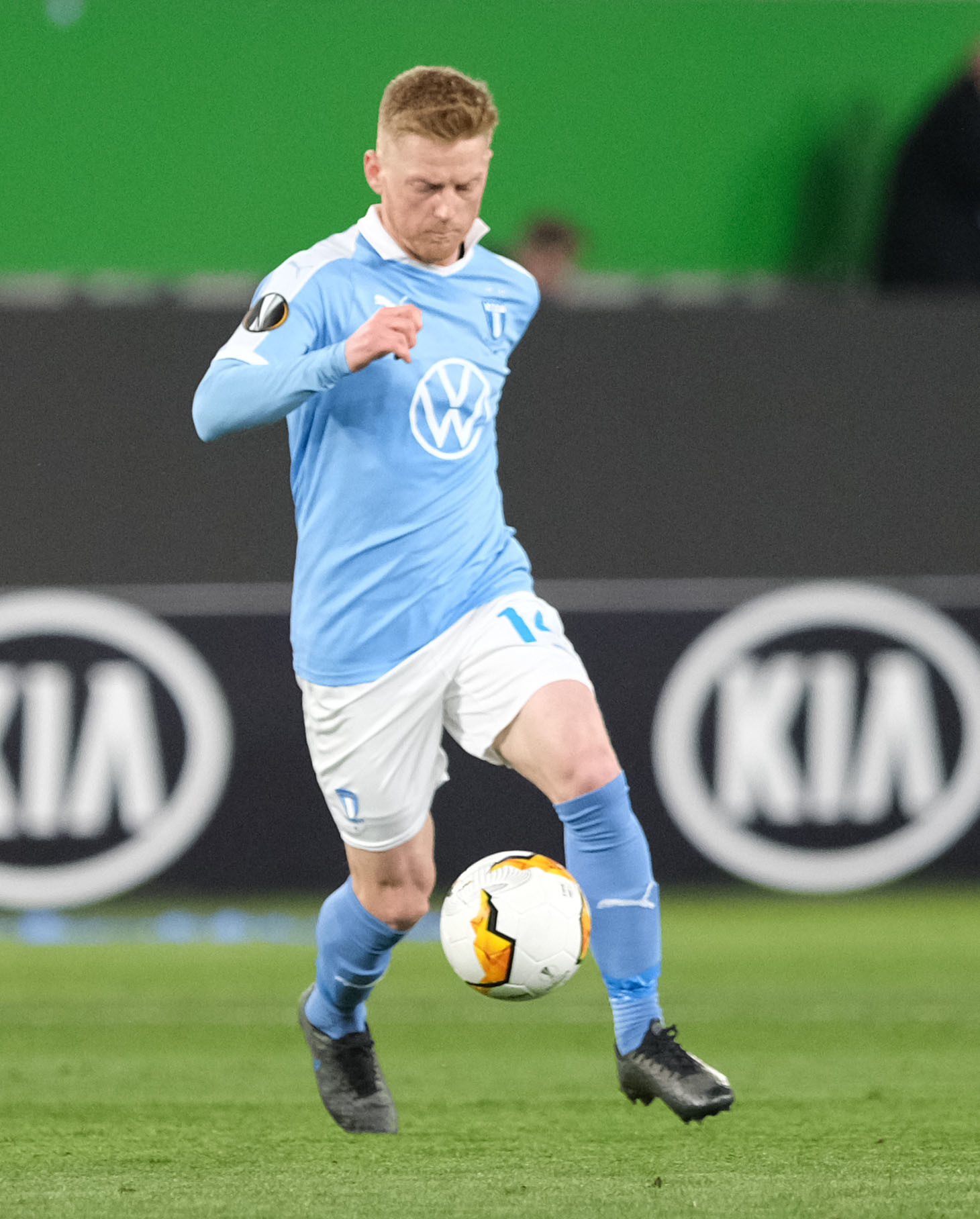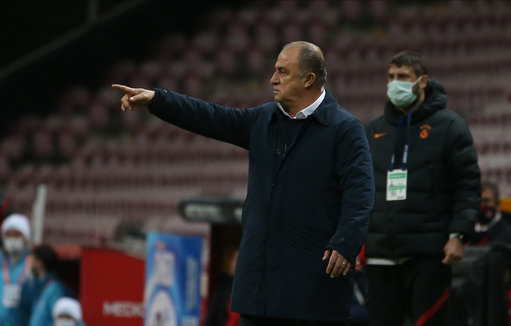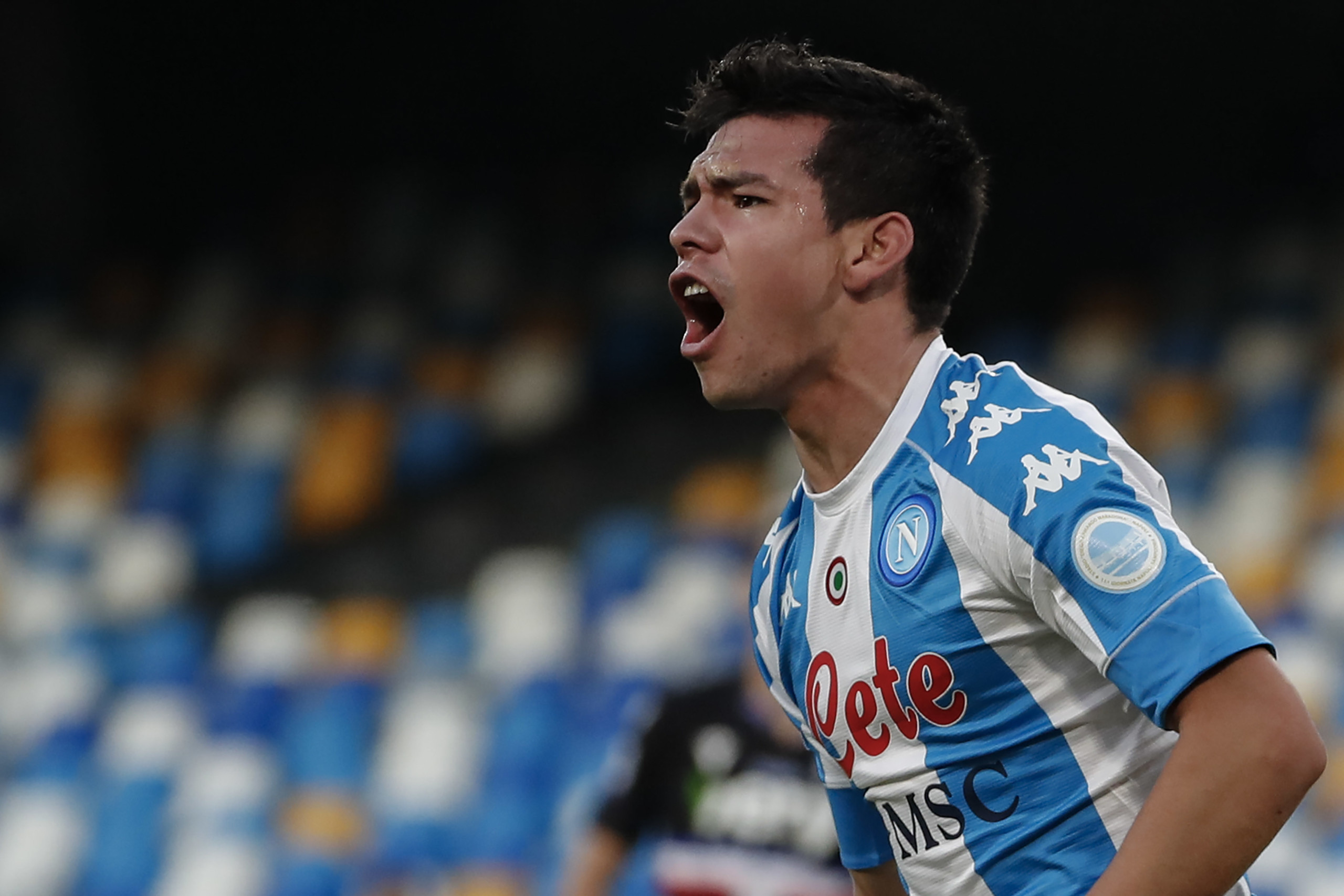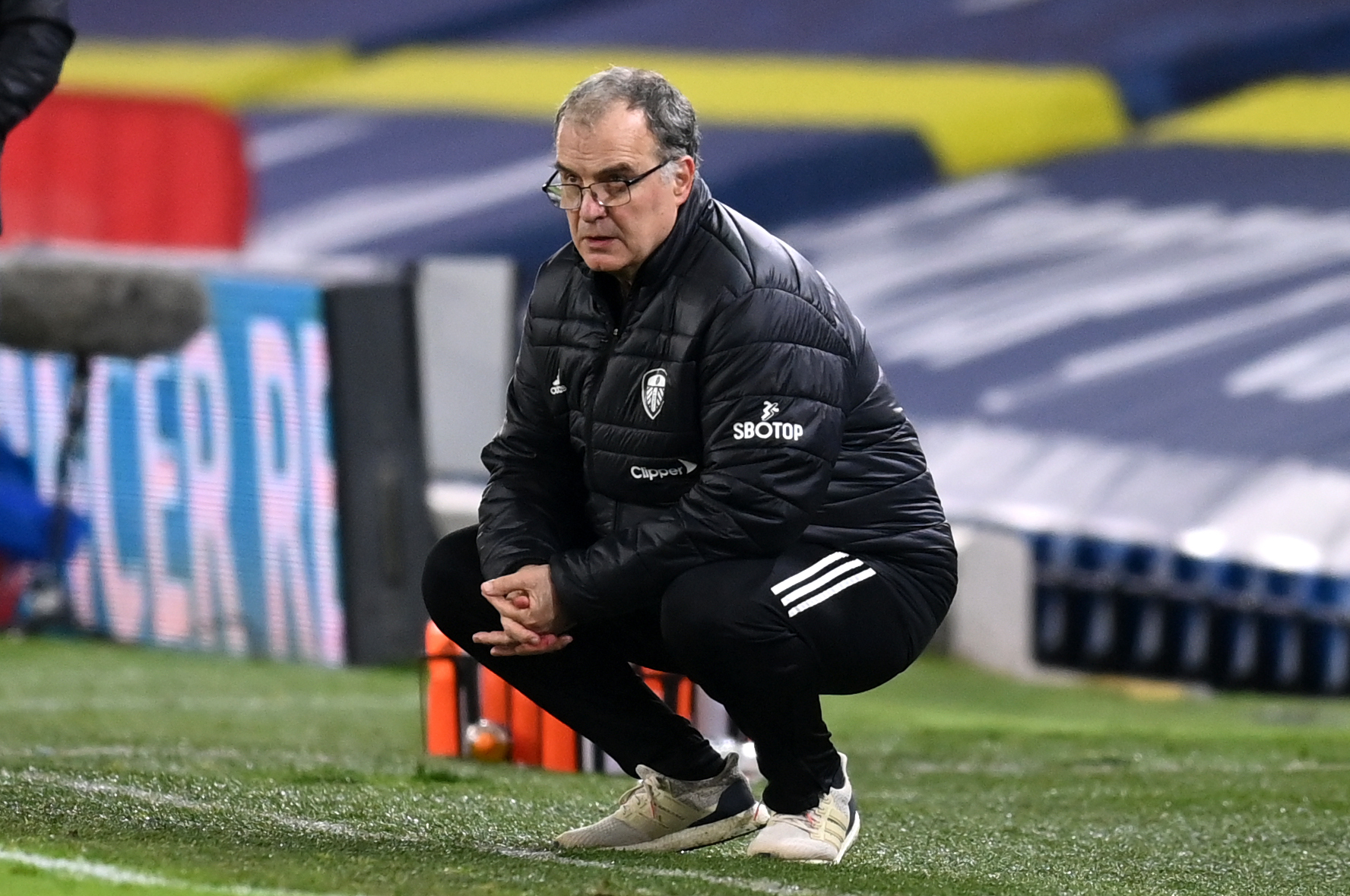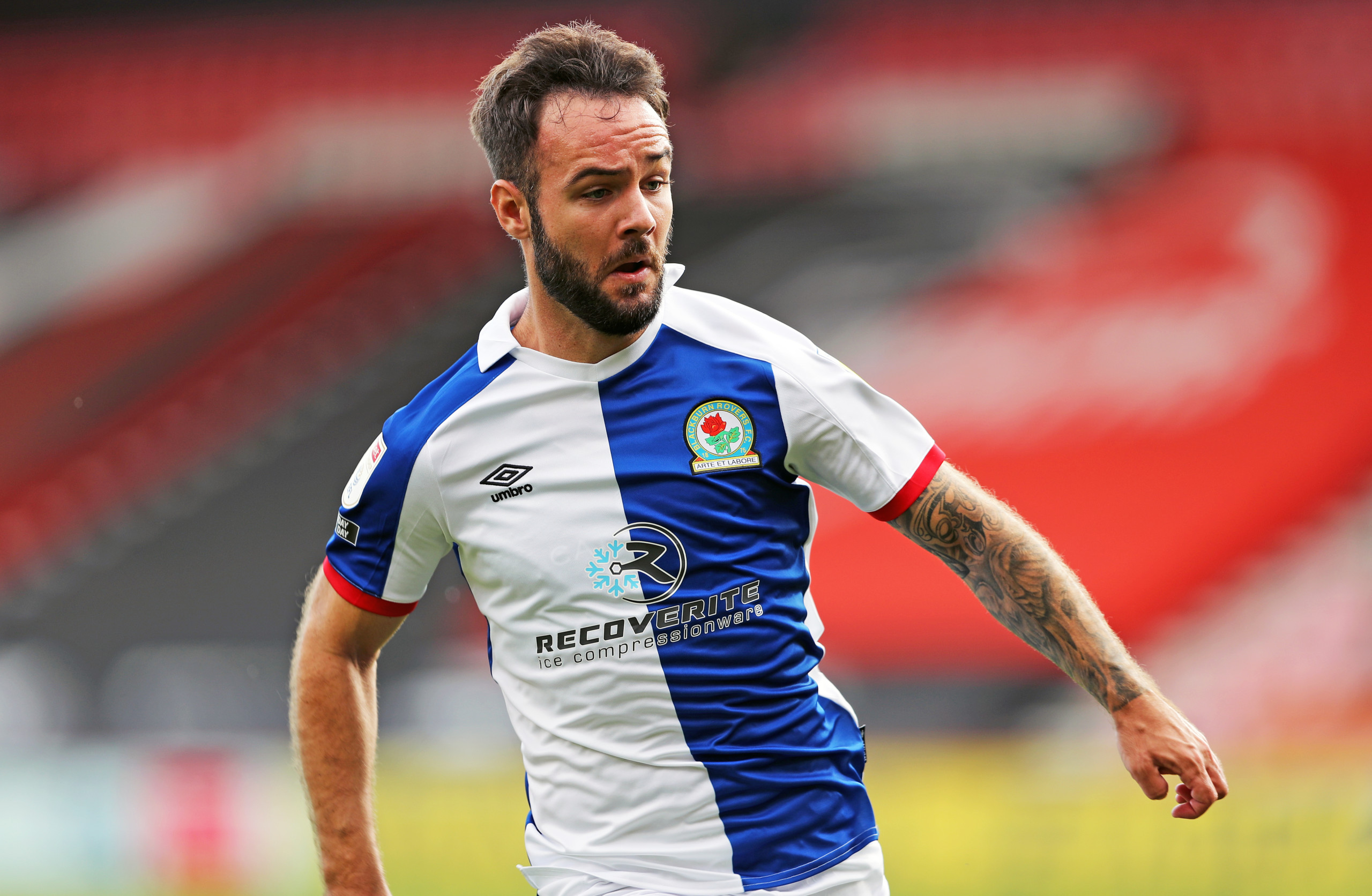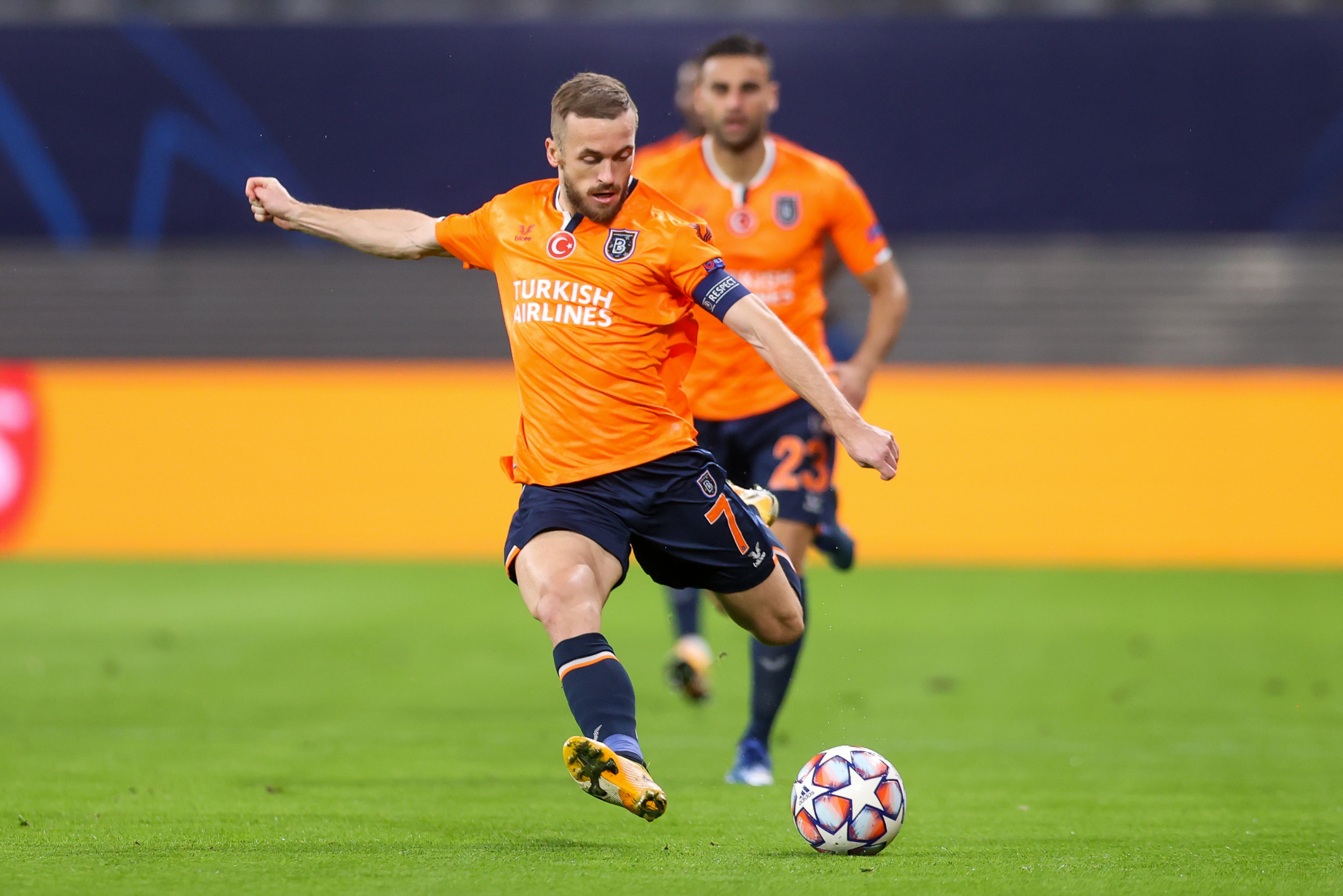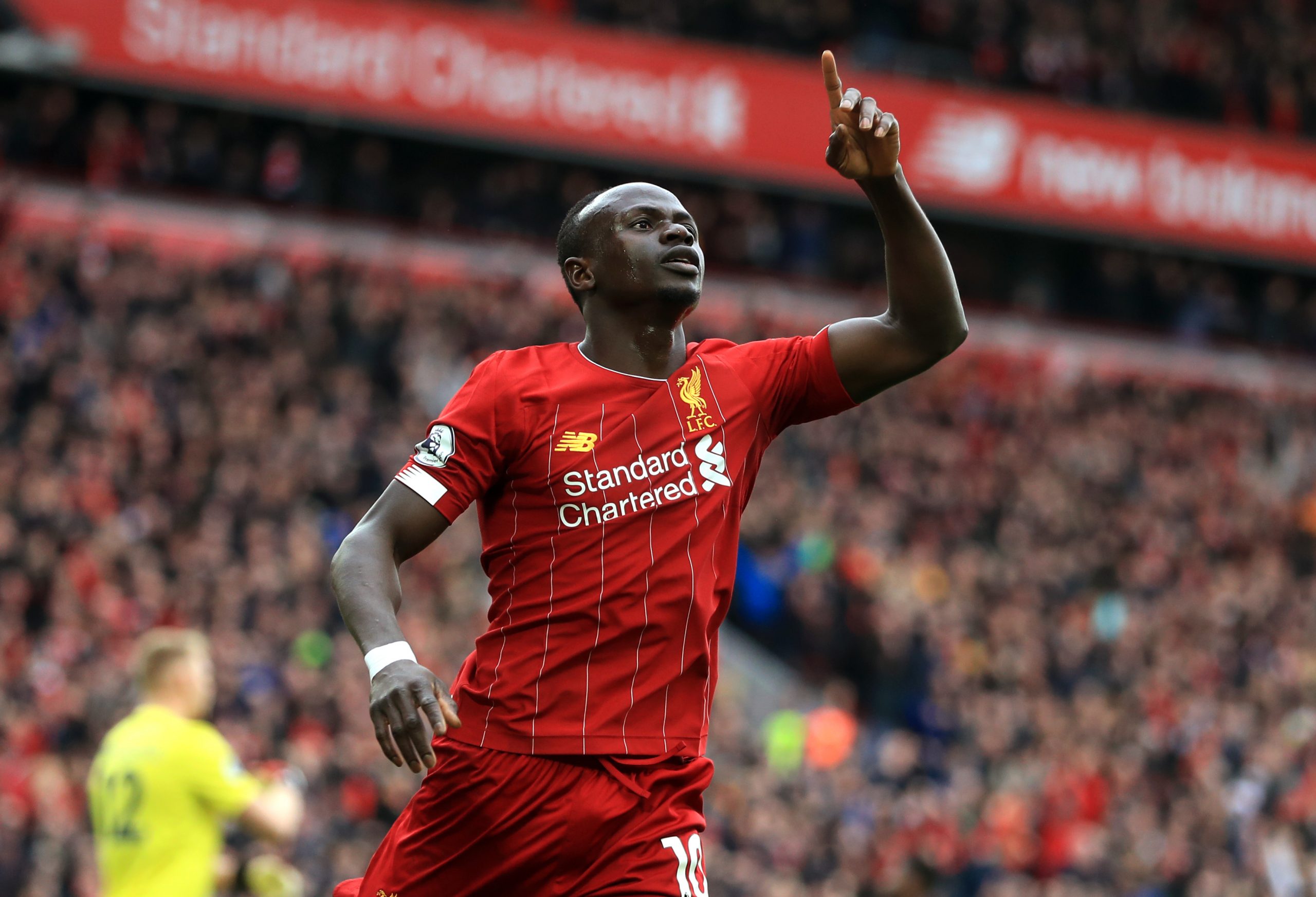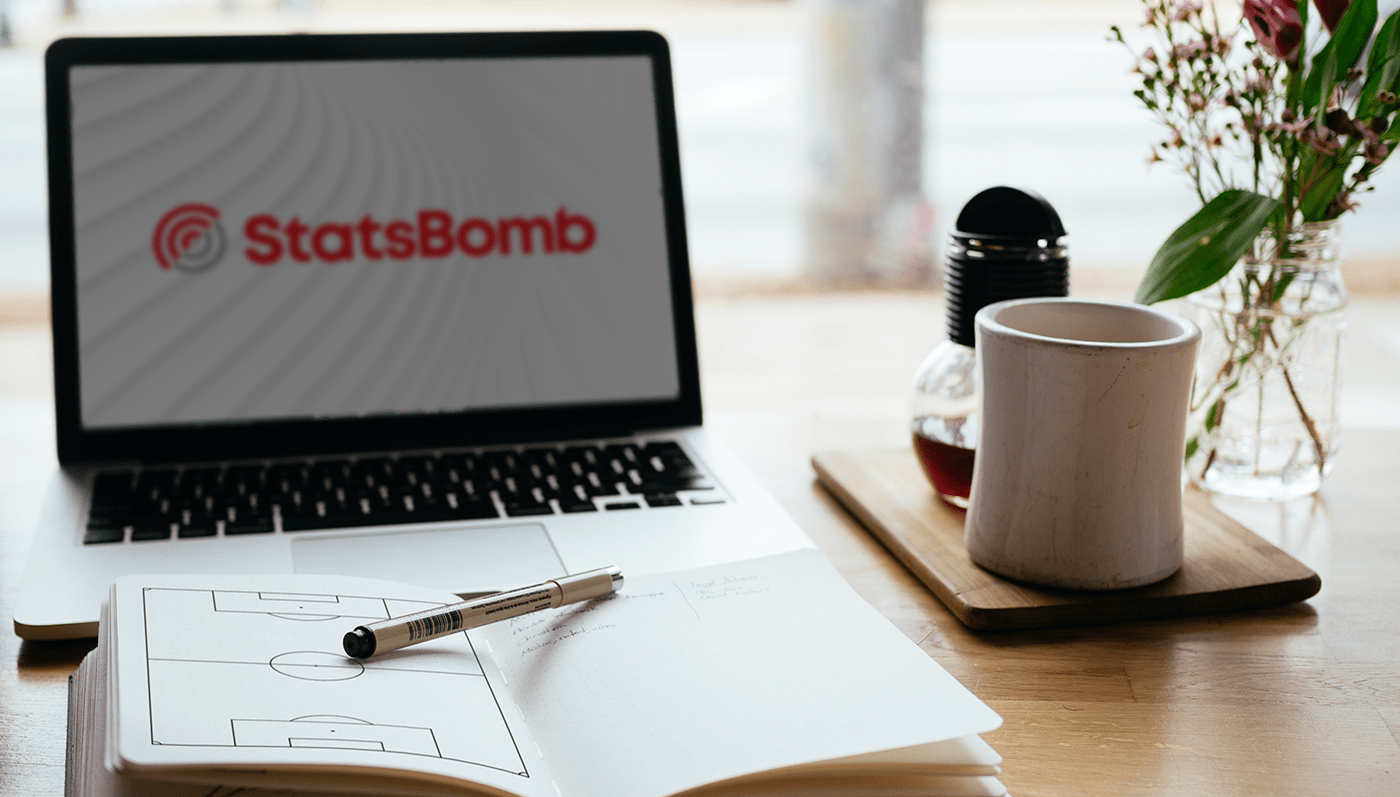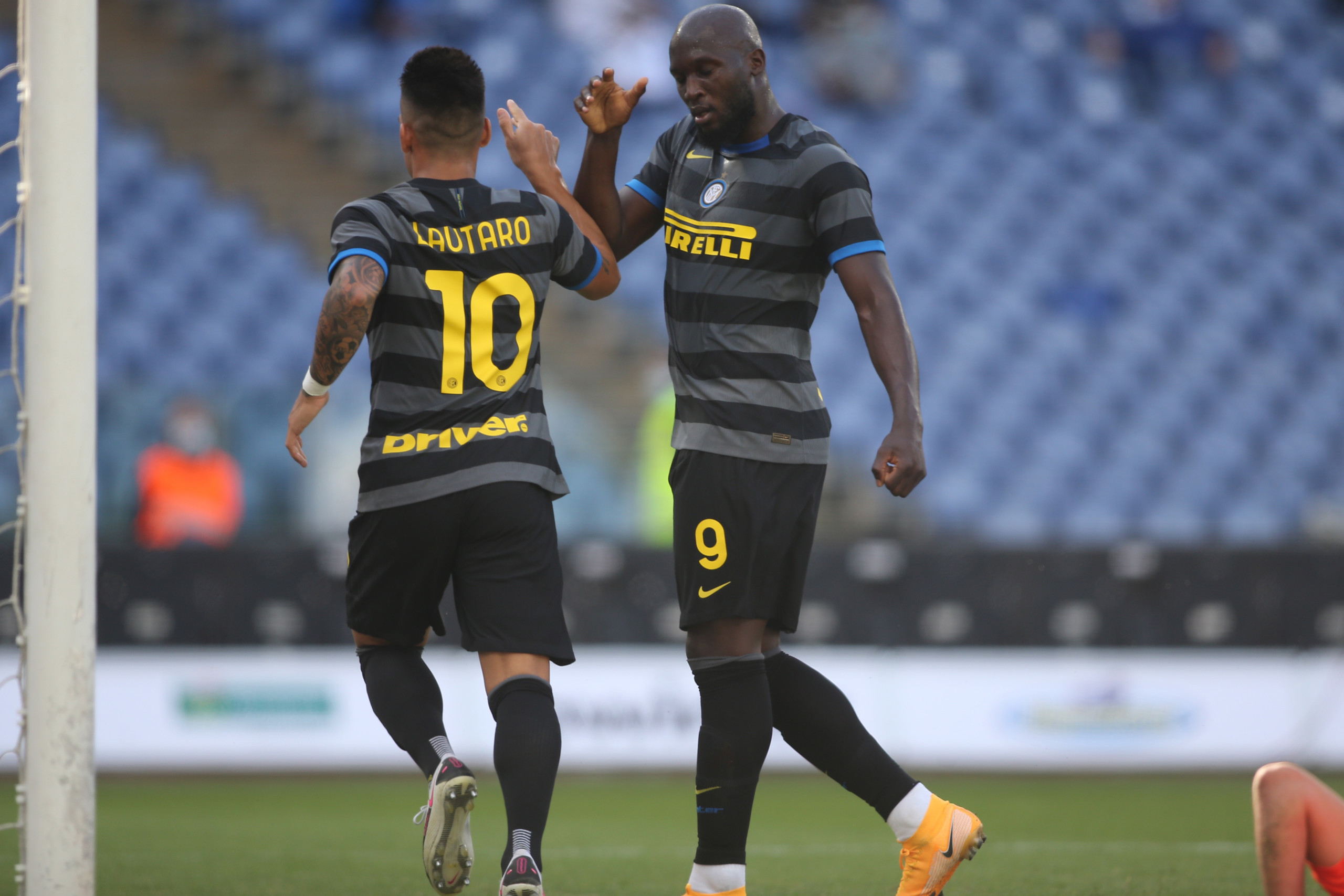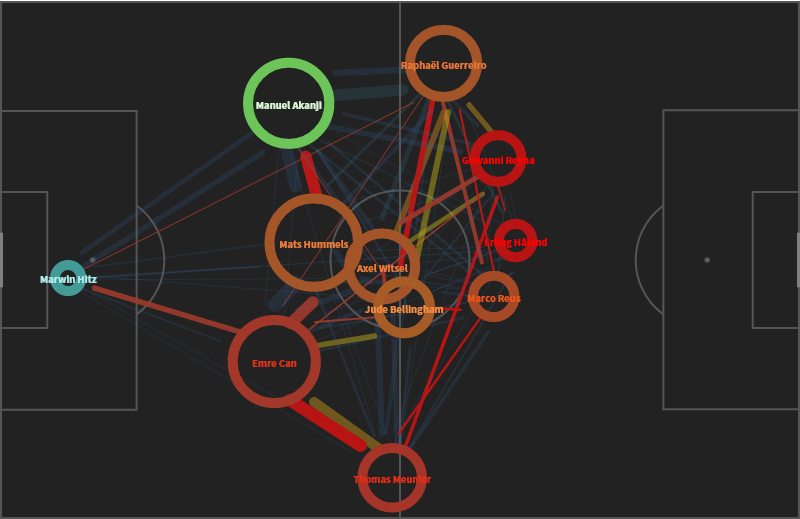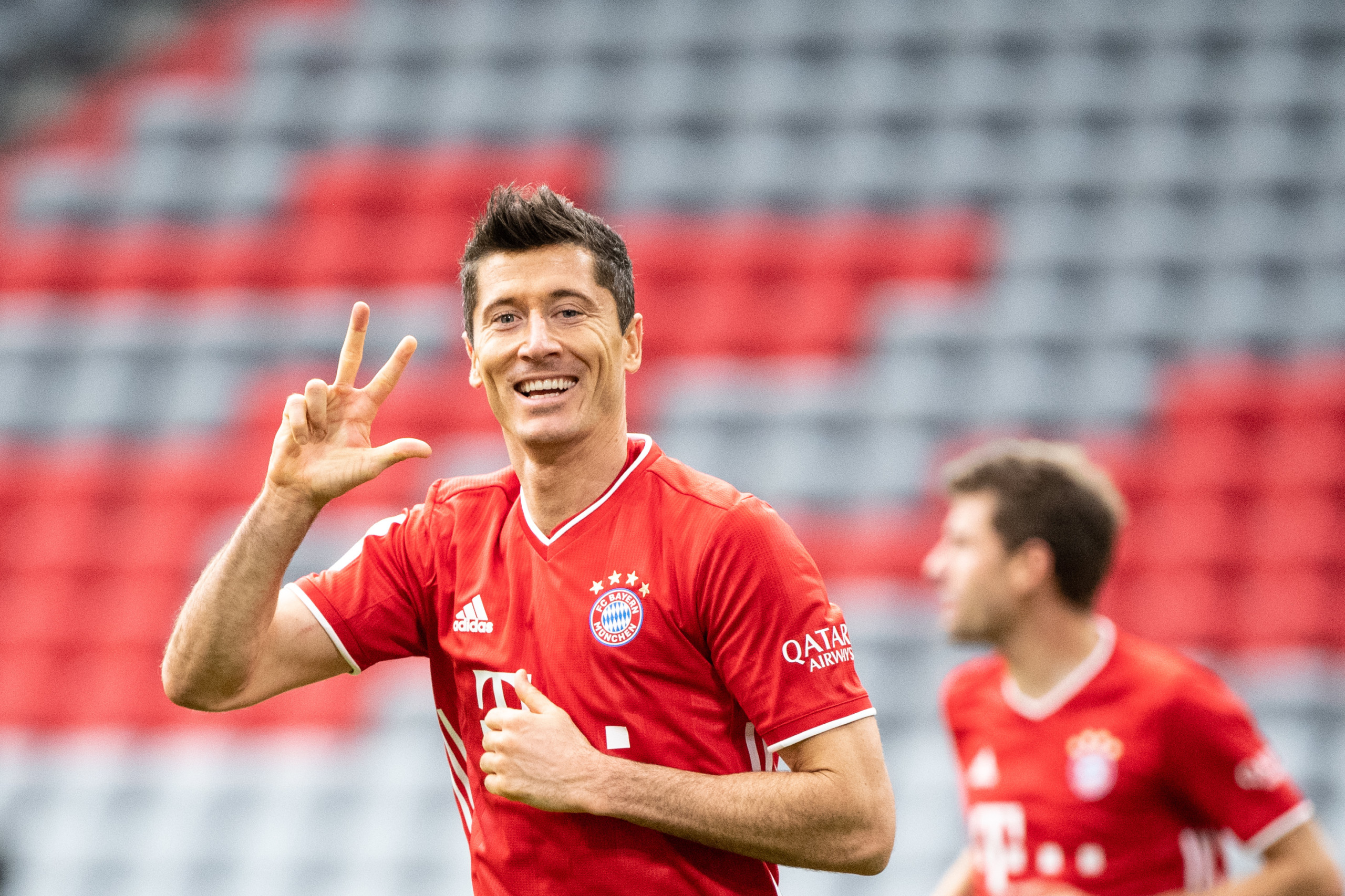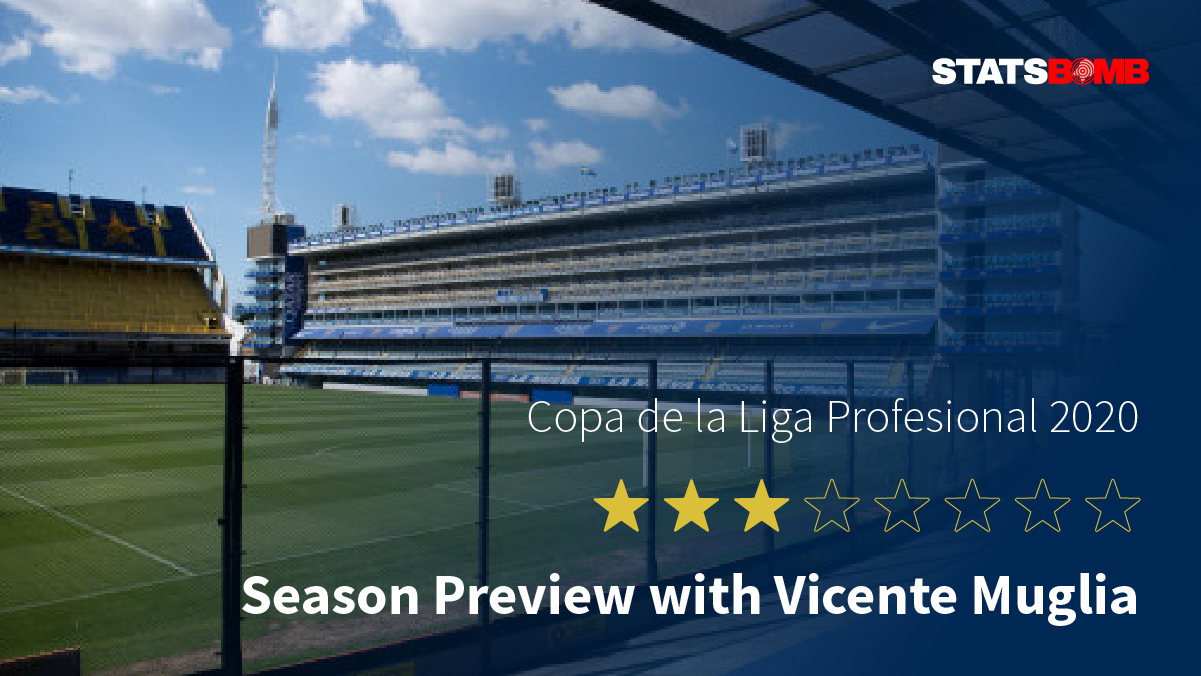After the 2019 Allsvenskan season ended in dramatic fashion - Djurgårdens taking the title from Malmö and Hammarby by a single point on the final day, after coming from 2-0 down to draw 2-2 - the 2020 edition had a tough act to follow.
IFK Norrköping were quickest out of the blocks, going 6-2-0 in the opening eight rounds to build a strong lead at the top of the table. Talismanic forward Christoffer Nyman and tricky winger Sead Hakšabanović – eventual top scorer and top assist maker in the league - were dovetailing to great effect at the top of the pitch, with support coming from an unlikely source in centre back Rasmus Lauritsen, responsible for 3 goals and 3 assists in the opening period of the season.
Jens Gustafsson and his team were aiming to go one better than their 2018 title challenge and the early underlying numbers suggested they were on their way to doing so: the Östergötland-based club had the best expected goal difference across the league after eight games. This was largely thanks to an attack that had notched 18 goals (plus 2 penalties) from 13.38 xG, an expected goals figure that was league-best at the time.
However, as we can see from their expected goals trendline, the team were unable to maintain their strong early-season form. As performances dropped off, so did results.
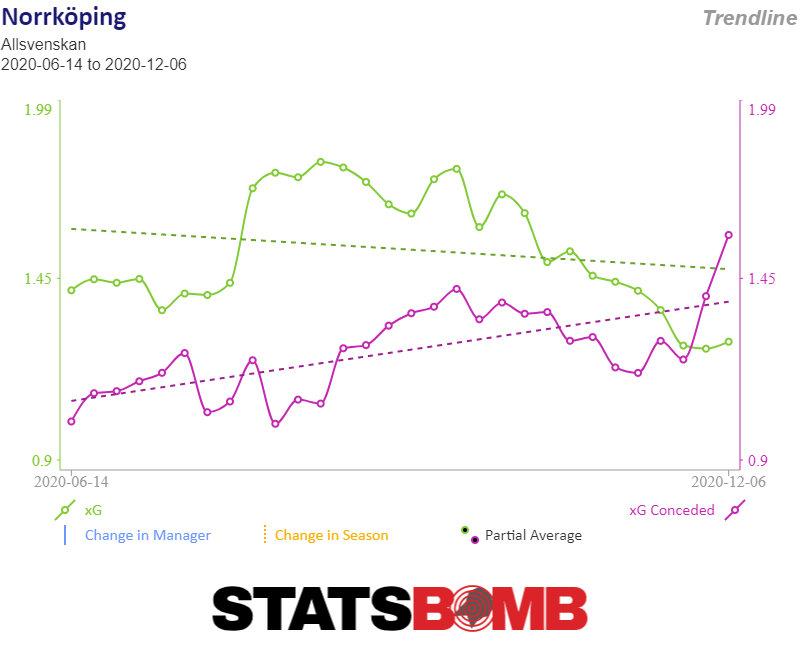
Malmö took full advantage. New manager Jon Dahl Tomasson’s reign had begun steadily and they sat seven points behind Norrköping after that eight game period due to a 3-4-1 start to the season. But, just as Norrköping’s engine faltered, Malmö went pedal-to-the-metal, winning their next eight fixtures in a row to ascend to the top of the table.
The approach in those wins was apparent as Di Blåe imposed their game on the opposition, defending further up the pitch and playing as much of the game in opposition territory as possible. Their Defensive Distance – the average distance from a team’s own goal from which it makes defensive actions – was 53.4 metres through this period, much higher than their average of 49.4 metres across the full season. That was matched by an aggressive press; Malmö recorded 629 pressures in the opposition half through this eight game spell, the highest in the Allsvenskan, and their ratio of pressures in the opposition half versus their total pressures of 59% was also a league-high.
The opening goal of their July fixture away to Östersund set the tone in this regard. As Östersund tried to play out from the back, Malmö formed a very high block and forced the home side to play a rushed clearance to the halfway line. Centre-half Oscar Lewicki made the interception and a string of quick, forward passes saw Ola Toivonen finish a Marcus Antonsson cutback unmarked 12-yards out, just seven seconds after the turnover.
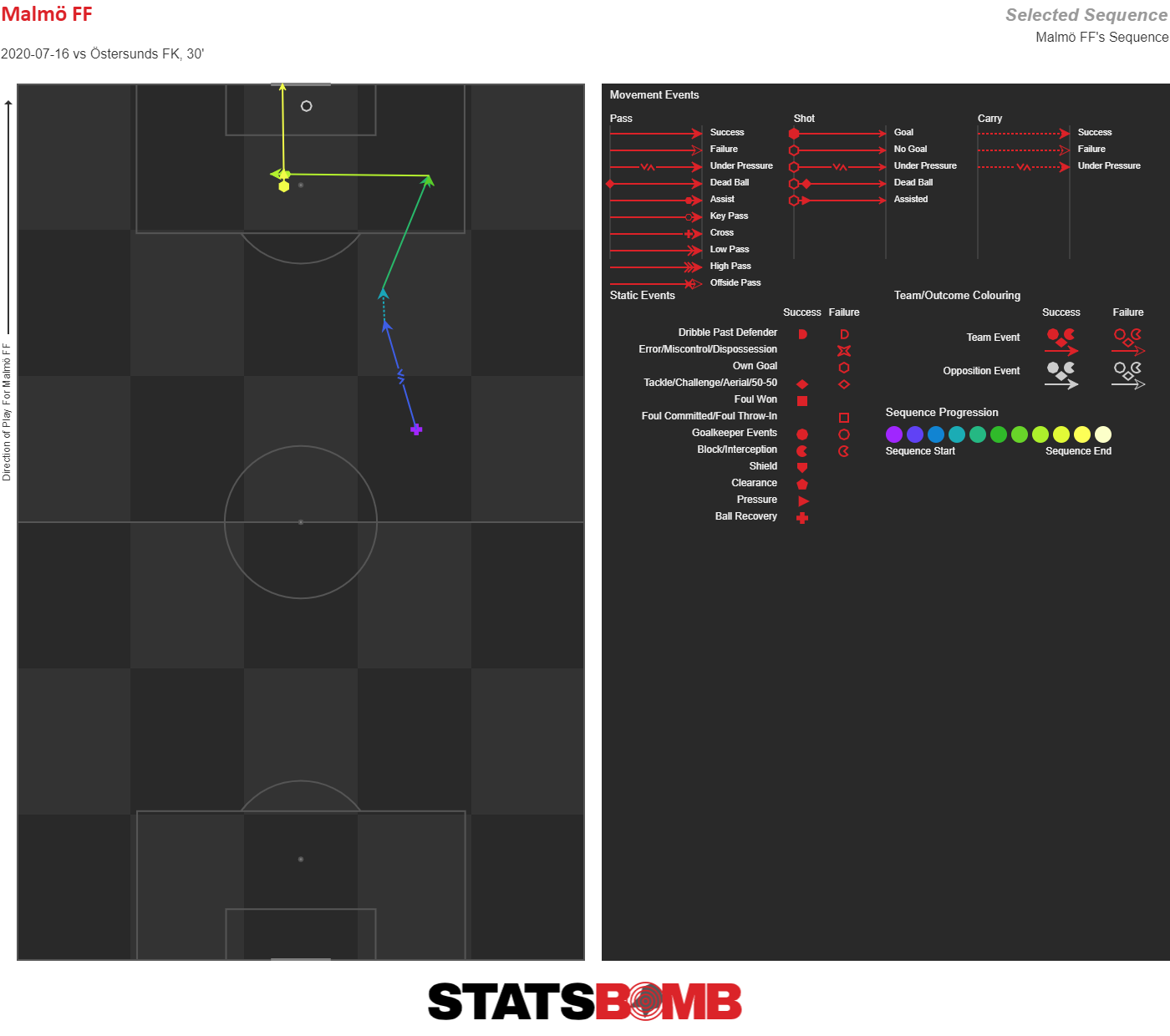
That run of form saw them move into top spot after gameweek 13, a position they would hold onto for the rest of the season in a dominant campaign. They went the entire season unbeaten at the Eleda Stadion, taking 11 wins and 4 draws from their 15 home fixtures, and a goal difference of +34 was more than twice the value of the next best goal difference in the league. Of course, a well-rounded side wouldn't be complete without a solid record from set-plays too; Malmö netted the most set-play goals in the league and also had the joint-best goal difference in this phase of the game.
2019 Allsvenskan 'Midfielder Of The Year' Anders Christiansen retained his title after another season of commanding performances in the middle of the Malmö midfield, and went one better in 2020 to claim the league’s 'Most Valuable Player Of The Year' award for the season too. The Dane was a key contributor on both sides of the ball but his ability to knit defence to attack in particular was crucial in the club’s 21st Allsvenskan title win.
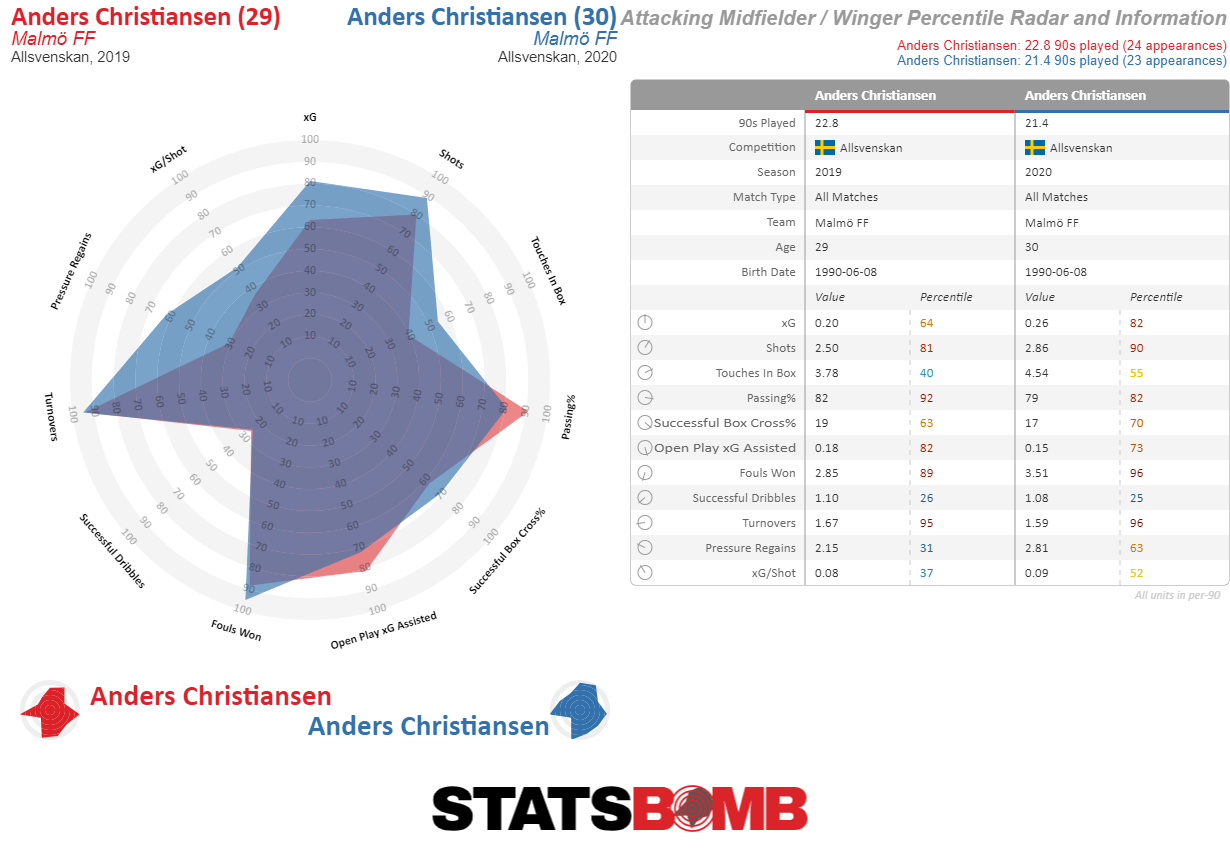
In the battle for European qualification, IF Elfsborg and BK Häcken edged out Djurgården to finish 2nd and 3rd respectively and enter the 2021/22 UEFA Europa League competition.
Djurgården, Allsvenskan Champions in 2019, finished just 1 point behind Häcken and might be frustrated not to have secured a top three finish on the back of some very robust defensive performances. Their 25.8 expected goals conceded, not including penalties, was the best record in the division by this metric, whilst their 0.08 xG per shot conceded ranked 2nd best, reflecting their ability to stifle the opposition from creating quality chances. It was underperformance at this end of the pitch, conceding 31 goals, that ultimately cost them a European qualification spot.
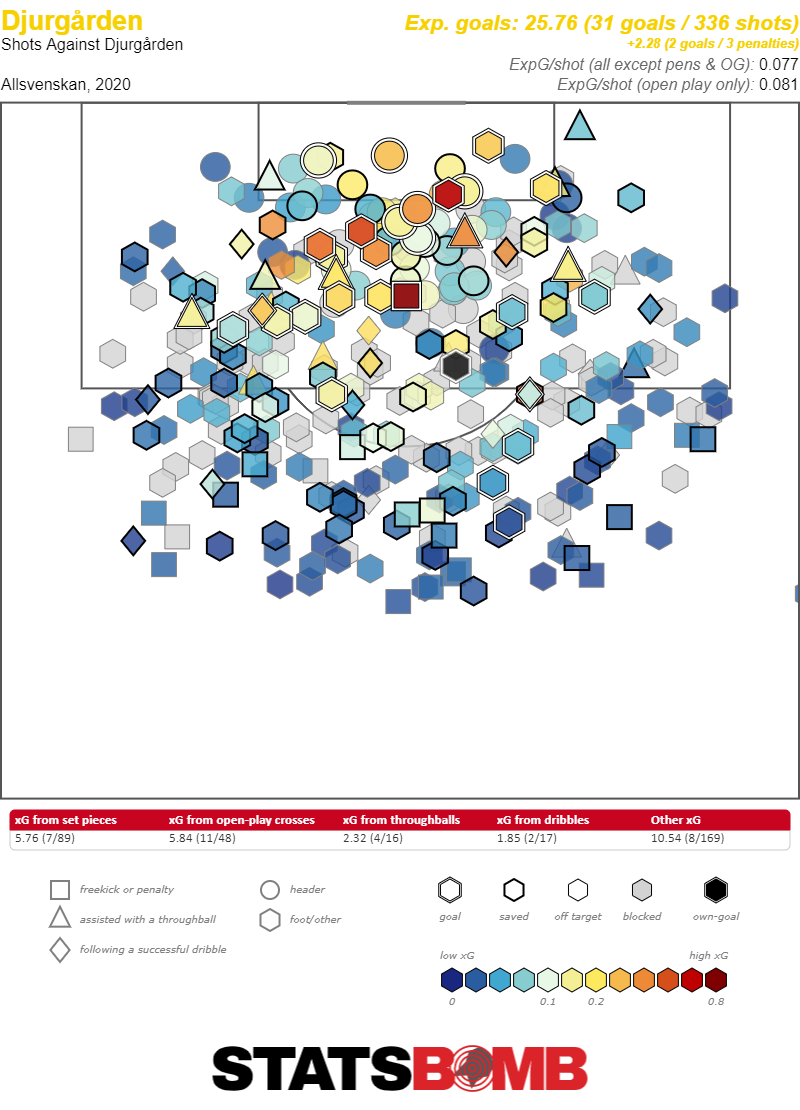
Runners-up Elfsborg had many of the league’s standout performers. Per Frick worked hard up front allowing Rasmus Alm and Simon Olsson to flourish behind him, while Johan Larsson was also a key contributor from right back, finishing as the club’s top assist-maker with 6 having registered both the most Key Passes in the league and the most xG assisted.
It was Allsvenskan 'Forward Of The Year' Jesper Karlsson who stole the show for Di Gule though, his performances on the wing earning him a September transfer to AZ Alkmaar in the Eredivisie.
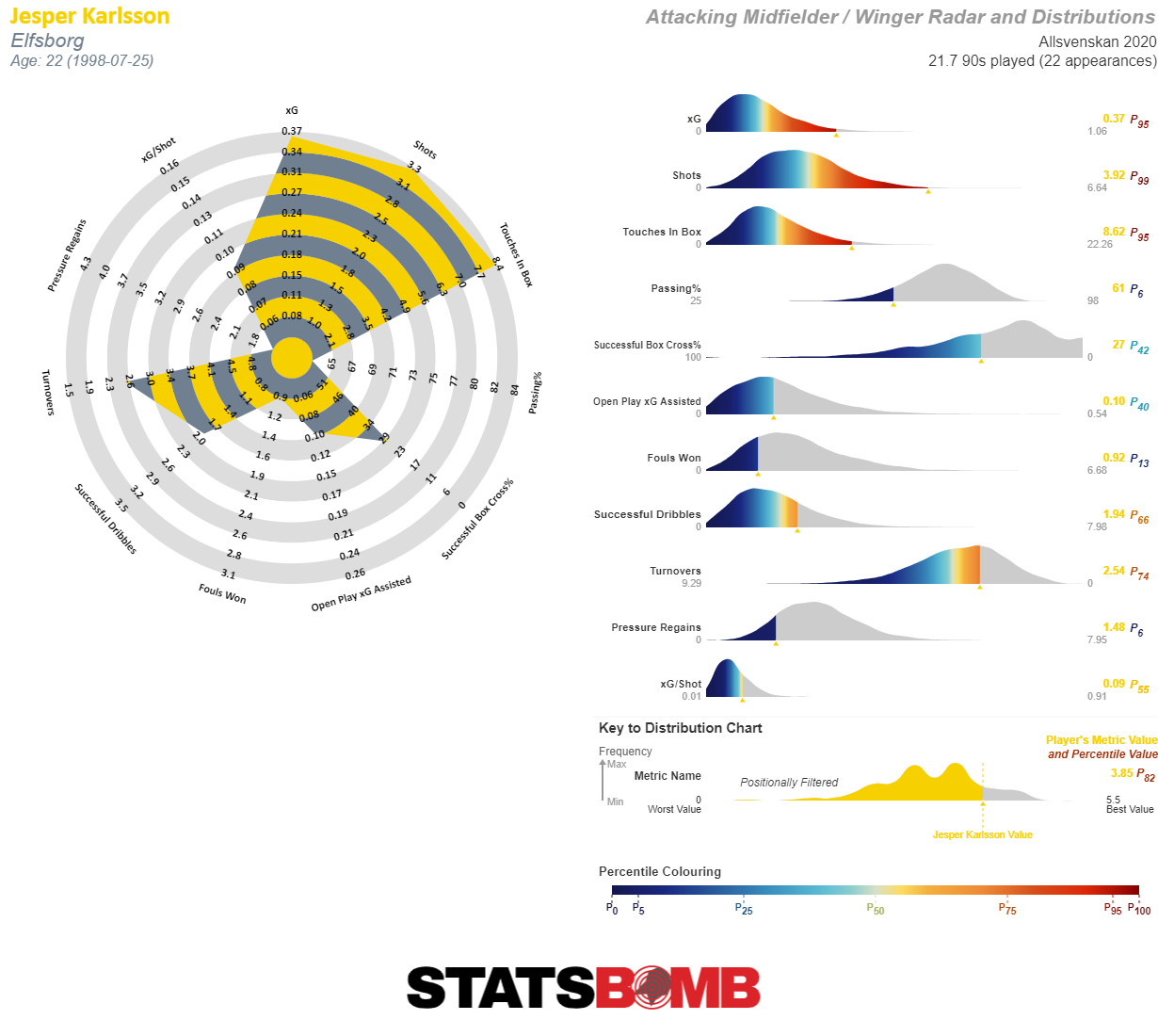
3rd place was BK Häcken’s highest placing since the 2012 season and their front-foot approach was central to their success. The Gothenburg side repeatedly showed their ability to quickly create shots off turnovers as they ranked joint-2nd for High Press shots - shots generated within 5 seconds of a defensive action in the opposition half - and tied it together effectively with their direct approach in transition, creating the most shots from counter attacks in the league.
Star player Daleho Irandust was central to this approach as his driving runs through the centre of the Bravida Arena pitch to carry Häcken into the attacking third were a regular sight, and his creativity in the final third saw him accrue the 2nd-most xG assisted from open play across the entire Allsvenskan. His high output in this area was a sizeable reason why he was recently identified as having a similar style to Atalanta keystone Papu Gómez by the Similar Player Search tool in our IQ platform.
As exciting as it was at the top, some of the brighter storylines were to be found further down the league table. To say that newly-promoted Mjällby adapted to their new surroundings with ease to stay up comfortably would be an understatement. Returning to the top flight after their 2014 relegation, the Hällevik-based club finished 5th, a club record, and their tally of 47 points was only four behind runners-up Elfsborg at the close of play.
It was a combination of deep defending and wise shot selection that powered the surprise package to their lofty position: up front the side paired the 3rd-best xG per shot with the 3rd closest average Shot Distance, taking the fewest shots from outside the box in the process. At the back, the team combined the 2nd highest Passes Per Defensive Action with the lowest percentage on StatsBomb’s Aggression metric at 17% (the proportion of an opponent’s pass receipts that are tackled, fouled or pressured within 2 seconds), prioritising their defensive shape over engaging the opposition.
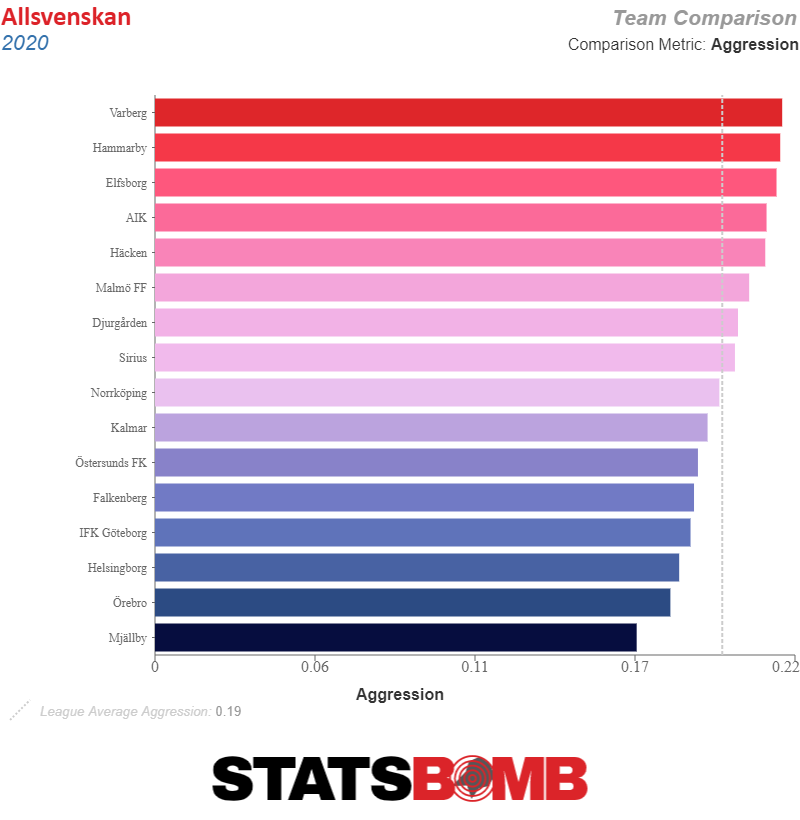
Which brings us to Varbergs BoIS.
Promoted alongside Mjällby and themselves making their debut in the Swedish topflight, the West Coast side led by Joakim Persson took a different approach to that of their fellow Allsvenskan newcomers. While Mjällby were happy to sit in their shape out of possession, Varberg were much more proactive in their defensive approach and recorded the most Pressures as a team in the 2020 Allsvenskan season, actively engaging the opposition across virtually the entire pitch.
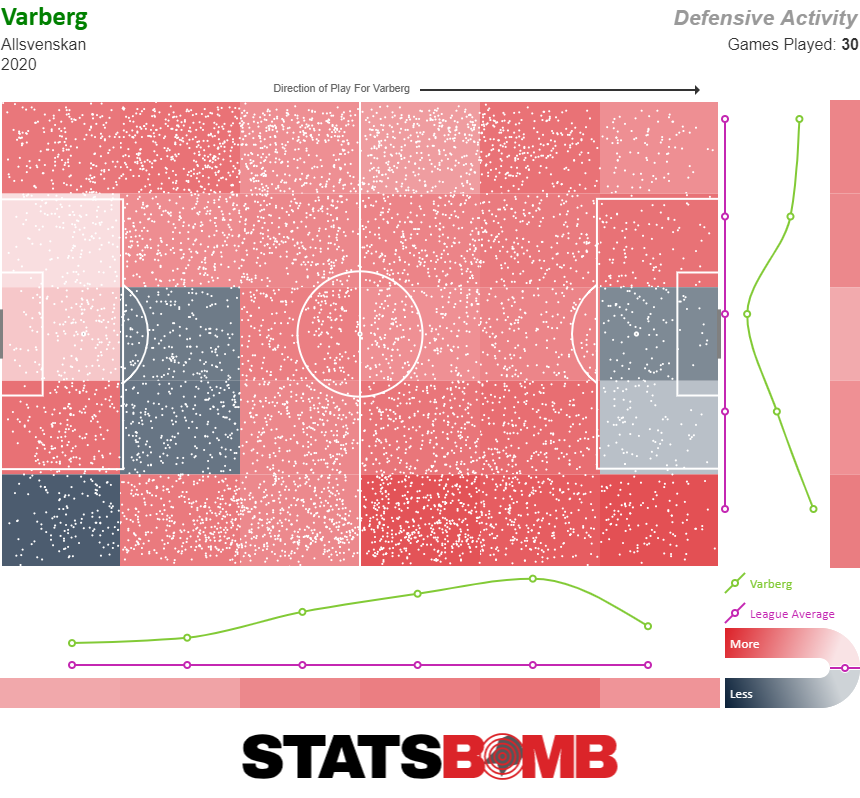
Star of the show for 7th-placed Örebro was undoubtedly goalkeeper Oscar Jansson, whose efforts were recognised with a 'Goalkeeper Of The Year' award. Örebro finished the season with a -4 goal difference, but with a -16.8 expected goal difference (including penalties). Such a large discrepancy wasn't solely down to Jansson's heroics, but the data still shows the former Tottenham Hotspur 'keeper to be a worthy winner of the award: StatsBomb data ranked Jansson as having the 2nd best Shot Stopping %, relative to the quality of the shots he faced, in the league, as well as ranking 2nd in StatsBomb's "Claimable" metric, a measure of how likely a goalkeeper is to claim a "claimable" pass.
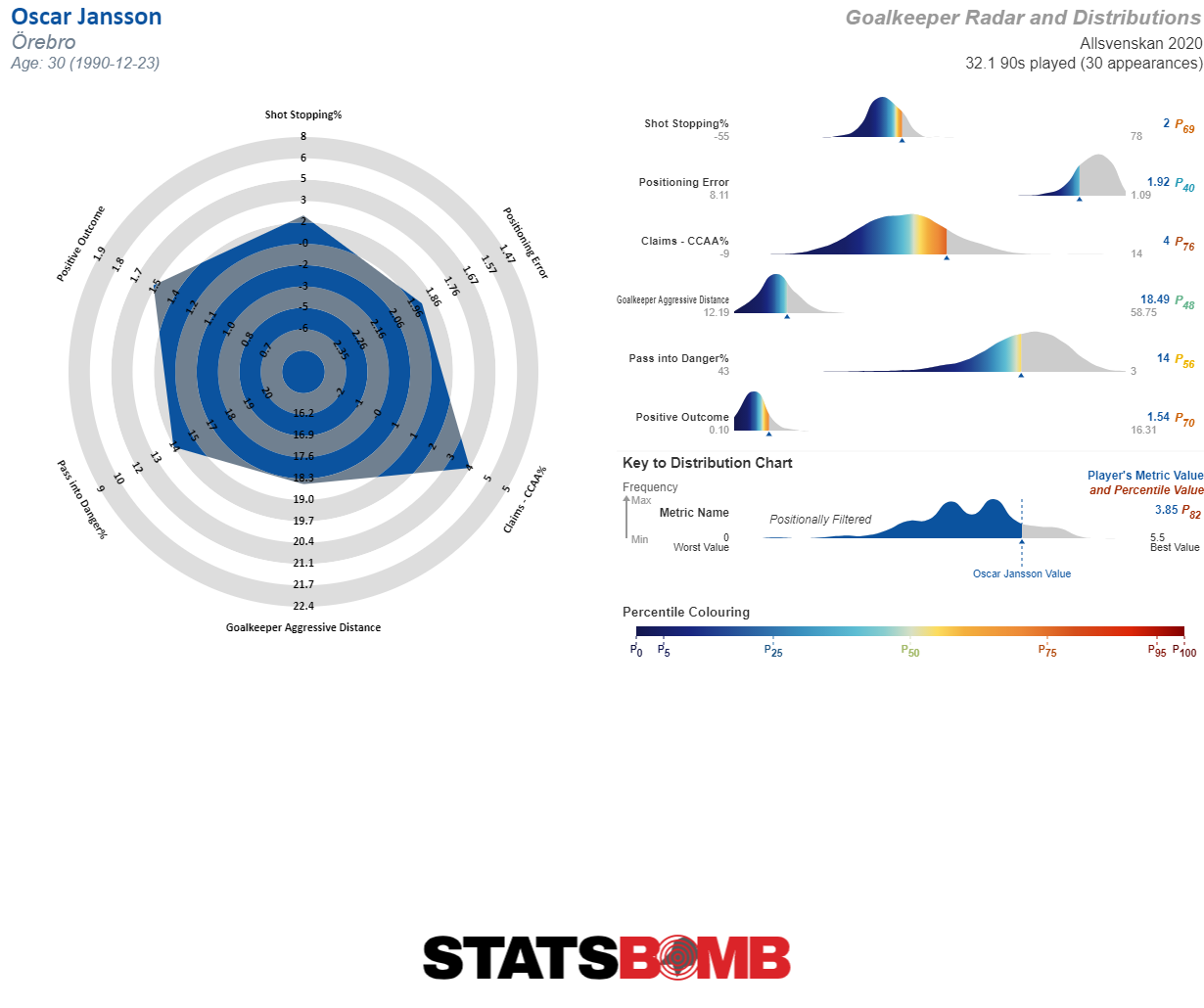
At the bottom of the table, a three-horse relegation battle was eventually won by Kalmar, consigning Helsingborg and Falkenberg to the 2021 Superettan. Kalmar’s defence-first approach in the final few weeks of the season saw them keep four clean sheets and pick up nine points from their final six games to overtake their rivals at the bottom of the table, having sat bottom of the league as late as gameweek 26.
Their penultimate fixture away at AIK was the key result, an 83rd minute Erik Israelsson goal from a corner securing a win that, combined with Helsingborg’s draw with Falkenberg, confirmed that Kalmar would avoid automatic relegation.
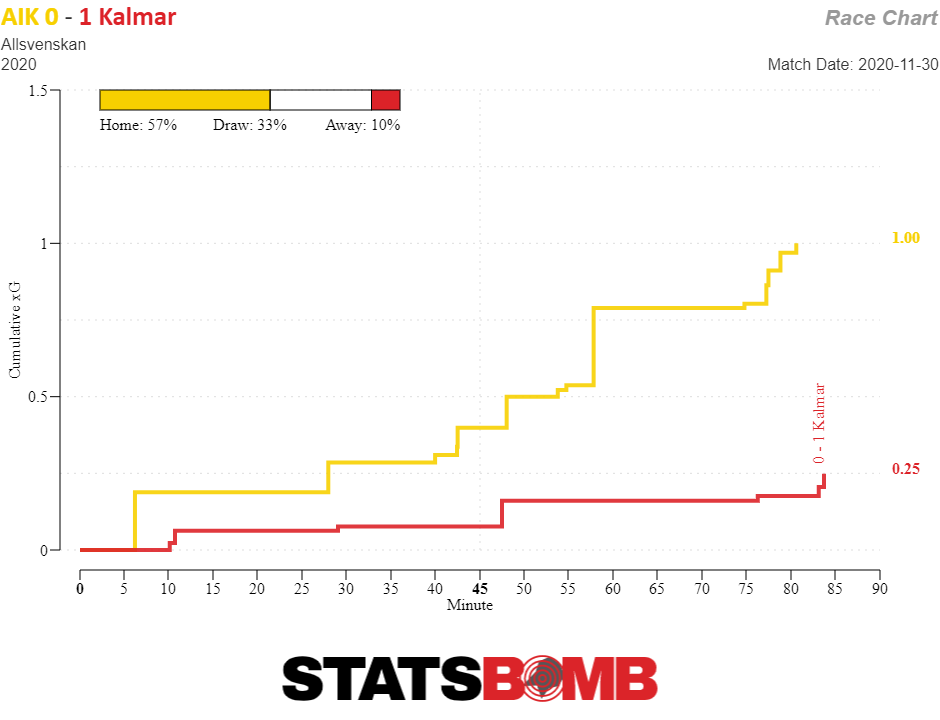
Their 2021 Allsvenskan place was finally confirmed after a 4-1 aggregate victory in the relegation/promotion play-off over Superettan’s 3rd-placed side Jönköpings Södra. With Helsingborg and Falkenberg dropping a division, their places will be taken in the 2021 Allsvenskan by Superettan champions Halmstads BK and runners-up Degerfors in what promises to be another lively campaign.
If you are a club, media or gambling entity and want to know more about what StatsBomb can do for you, please get in touch.
Welcome back to the Wild East!
What's happened since the last Süper Lig update? We have a new top goalscorer in Aaron Boupendza having just scored 12 goals from 6 starts, a new leader in Beşiktaş who shot up the table from 9th at the time of my previous article, a title holder Başakşehir that, despite having the second best xG in the league, roams right above relegation spots, and more. Let’s take a look at the underlying numbers in the 9-match period since November 27.
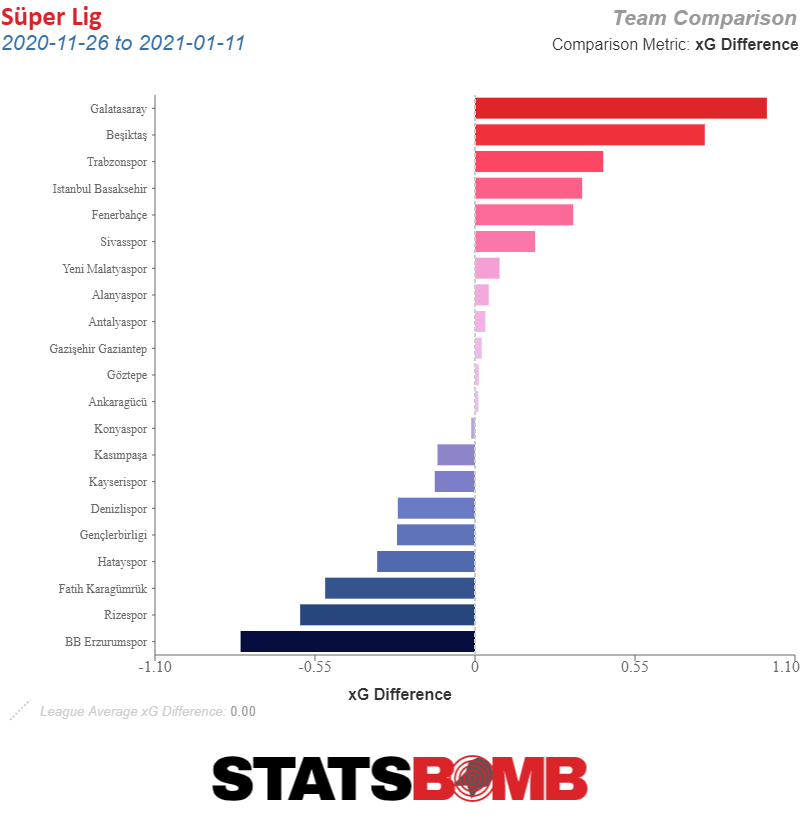
Beşiktaş made amends for their terrible start by cruising through this period with 23 points from a possible 27 and found themselves top of the league, while Alanyaspor slipped from the top with 10 points out of possible 30. Galatasaray and Fenerbahçe, meanwhile, kept their pace in around the top spot.
Beşiktaş – Sergen Yalçın’s Winning Formula
Let’s start with Rachid Ghezzal who is topping the assist charts in the league with eight to his name. Leicester City didn’t quite get what they were looking for from their Riyad Mahrez replacement and that should not come as a surprise looking at the radar below – not quite the all-rounder even at Süper Lig level.
However, he’s producing a staggering 0.28 open play xG assisted and 0.44 xG assisted per 90 for Beşiktaş so far. Those are elite numbers, and they’d be quite happy if he kept on doing just that. What sort of player you would want on the other flank of a 4-2-3-1 if Ghezzal on the right is creating chances at such rate while having close to no goal scoring potential?
A goal scoring wide forward with box presence and a nous for getting into high quality shot locations? Introducing Cyle Larin, second top goalscorer in the league with 11. Previously a striker, the Canadian reinvented himself this season as a wide forward under Yalçın and he’s finding himself on the end of a ton of chances so far, producing elite output both with his 0.64 xG per 90 and his xG/shot of 0.24.
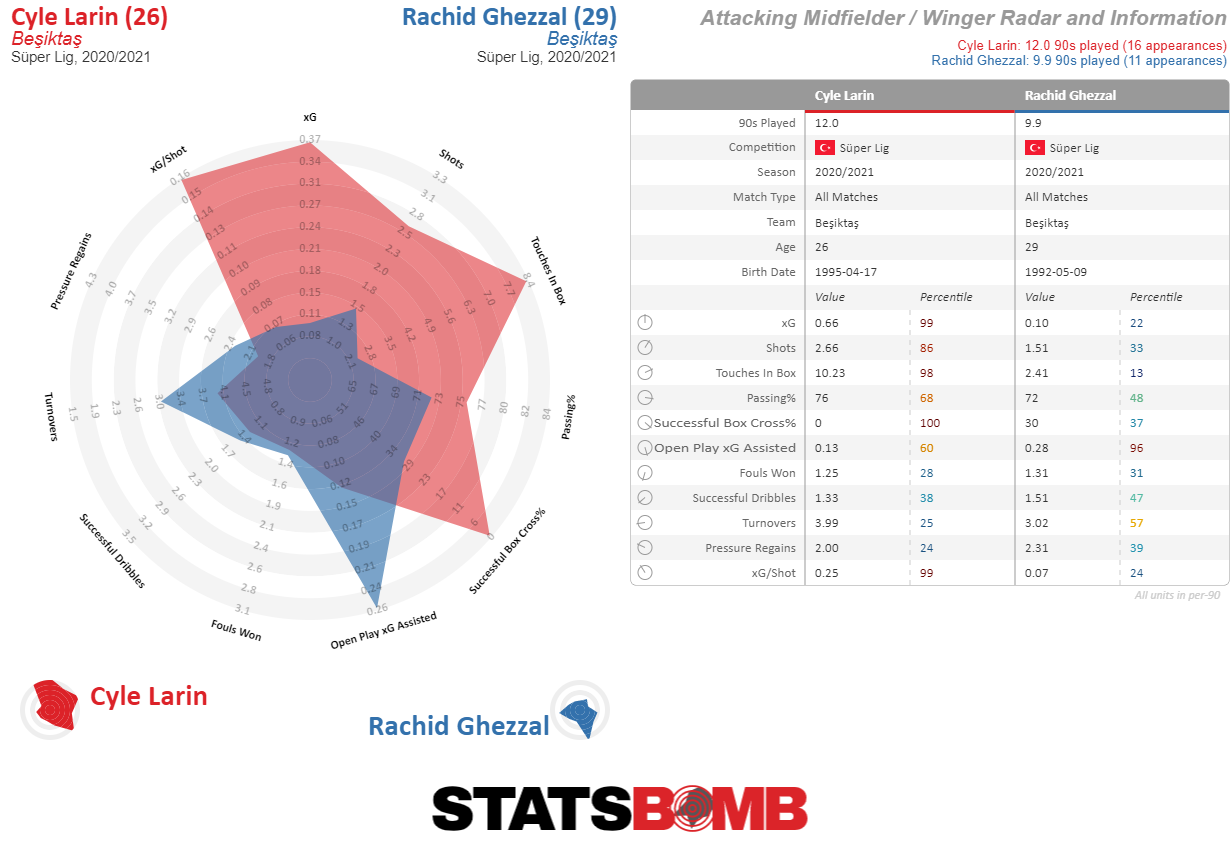
Besides the perfect fit of these two players in the final third, the majority of the success is coming from Yalçın finding the right formula in buildup play and how his team positions themselves in the opposition half – in fact, Ghezzal and Larin could only start three of these nine games together.
Yalçın found box-to-box skills out of 37-year old veteran defensive midfielder Atiba Hutchinson who contributed with 3 goals and 4 assists, while Hutchinson’s defensive midfield partner Josef de Souza often drops between the centre-backs and has improved the build-up play.
Full-backs Valentin Rosier and Rıdvan Yılmaz have been playing very well in advanced roles to aide the aforementioned roles of Ghezzal and Larin, and striker Vincent Aboubakar has been excellent in link-up play. Players have been rotated in and out of the 11 through this period, but Yalçın deserves credit for fitting the rotation players into the same dynamics and getting results. That said, Beşiktaş have overperformed their underlying numbers by 6 goals in total, so the recent honeymoon might not last forever.
Galatasaray – Best In The League, Too Reliant On Their Positional Play?
Galatasaray boasts the best xG difference in the league by a margin, both in this 8-game period at +1.0 xG difference per 90, and with their season average of +0.87 per 90. Galatasaray fans would not have expected to be the best team in the league after not being able to sufficiently strengthen the squad in the summer, and doubts still remain, with the slightest hiccup leading to heavy criticism of the team by the fanbase.
Yet, Fatih Terim managed to put together a side that’s out to dominate games and definitely looking a strong contender for the title considering the output to date. However, as a symptom of the squad’s shortcomings, Galatasaray might be too reliant on their positional play. Terim is a manager that wants to dominate games, and the attacking options in the team are mostly technical but slow players that lack mobility and stamina, such as Sofiane Feghouli, Younes Belhanda, Arda Turan, Emre Akbaba, and Ryan Babel.
Add striker Mbaye Diagne to that equation, who barely does anything on the pitch besides poach goals, and the fact that Galatasaray is having a disastrous season in set-pieces, and what you end up having is a team that purely relies on positional play to score goals. The team can’t counter-attack, can’t press much, and can’t score from set pieces.
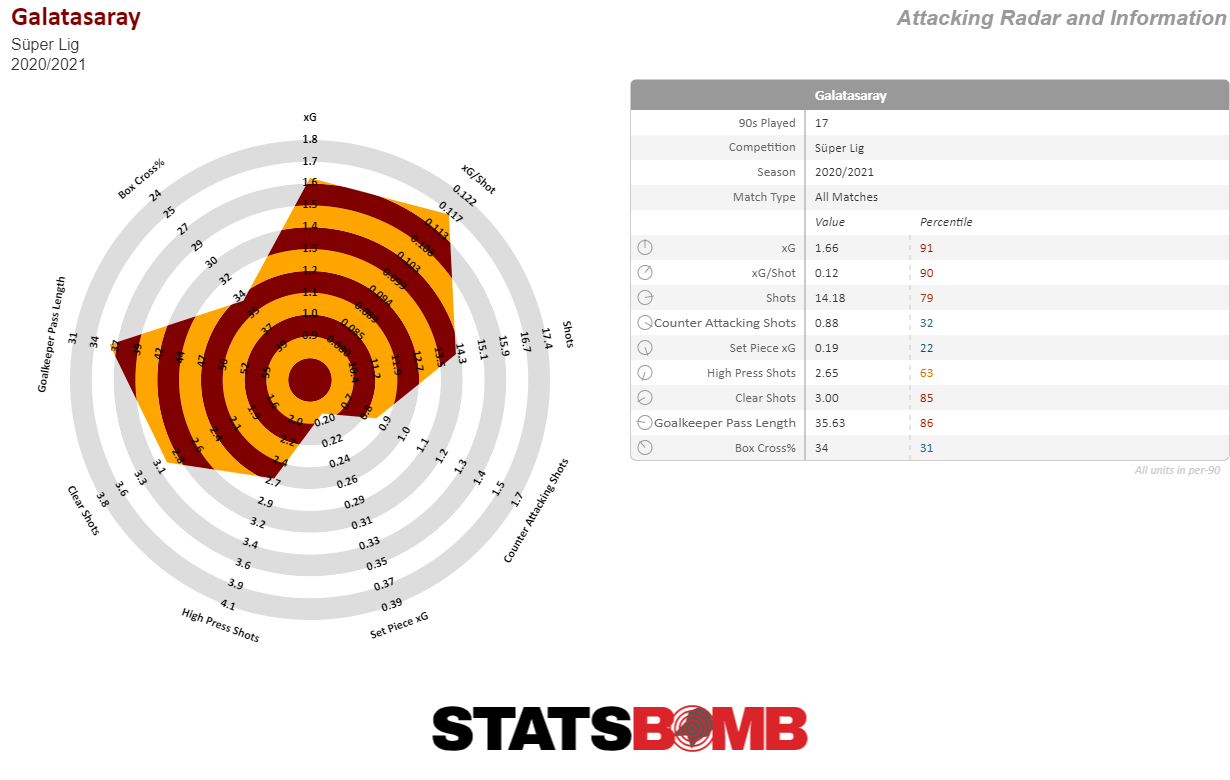
So far, by the underlying numbers, a combination of strength in positional play and a league-best defensive performance seems to be doing just fine and Galatasaray is on a good course if they keep this up, but diversifying would definitely help as they do struggle when the opposition has a good enough plan to stifle their positional play. If Monaco’s Henry Onyekuru comes back in January for a third spell on loan as rumored, he could provide some counter-attacking shots to the mix.
Fenerbahçe – Bulut Flying The Mourinho Flag
One of the biggest talking points within this nine match period was the war of words between Fenerbahçe manager Erol Bulut and Alanyaspor manager Çağdaş Atan after Fenerbahçe’s 2-1 win at home. Fenerbahçe ended the game with 30% possession, which led Atan to moan about the Istanbul giant not making a proper game out of it with their approach and that no title winner in top 5 leagues plays like that anymore.
Bulut replied in a Mourinho-esque way, saying it was the right strategy to beat Alanyaspor and only the win matters. Fenerbahçe looks like the opposite of Galatasaray in attacking terms – open play issues continue with a mediocre open play xG of 1.0 per 90 that is only slightly above league average, but is compensated for by a best-in-class 0.46 xG per 90 from set plays.
On the defensive side, although things were looking really drab in two bruising losses in a row versus Yeni Malatyaspor and Gaziantep containing some alarming centre-back performances, Fenerbahçe is a good defensive unit as a team with second best underlying numbers and an increasingly healthy pressure in the opposition half, as shown below. It’s fair to say the Süper Lig underdogs struggle to create in the positional play they find themselves handed against Fenerbahçe, as they are mostly hardwired to counterattack against these sides.
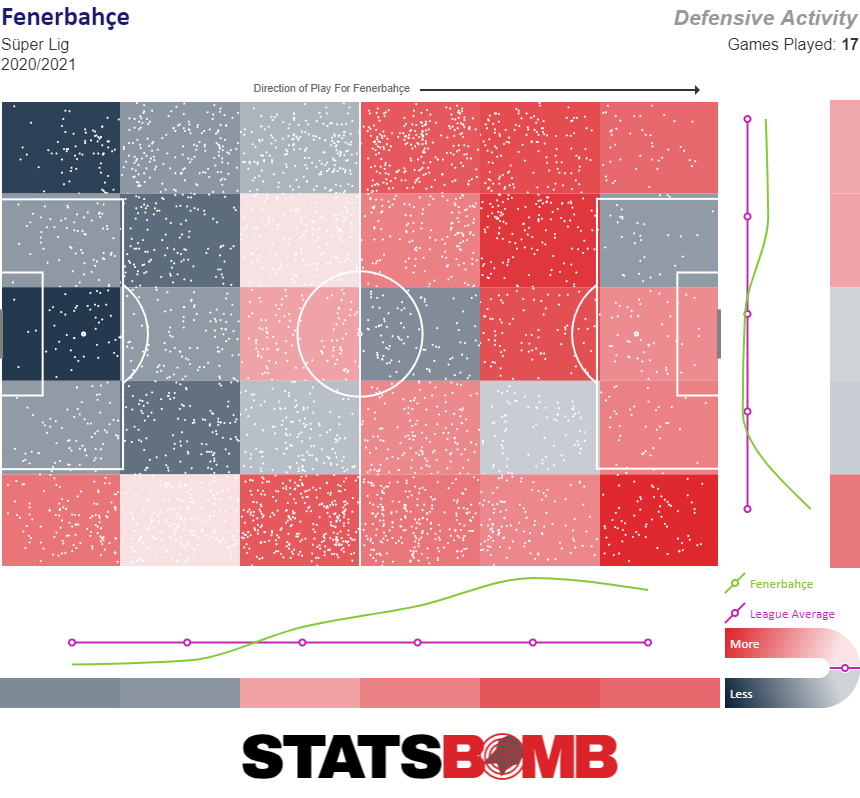
Averaging only 52% possession to date, Erol Bulut is clearly showing much less interest in dominating games compared to his title rivals, flying the “Mourinho” flag in Süper Lig. Their main source of creativity in open play is crosses from left-back Caner Erkin who’s at 98th percentile of the full-backs in the world with 0.21 open play xG assisted per 90. That’s double that of Trent Alexander-Arnold this season. He’s also responsible for creating the lion’s share of the set-piece xG.
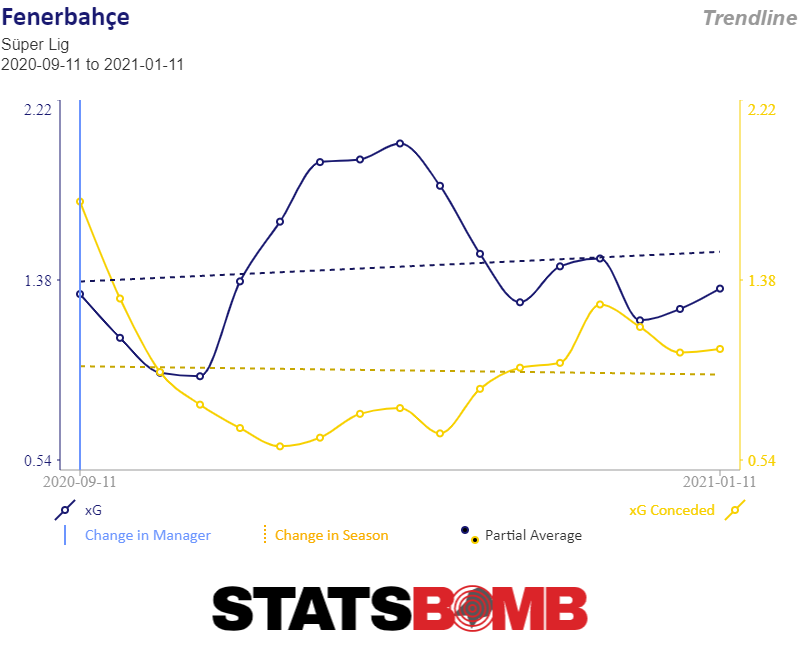
Looking at the above trendline with a 5-game rolling average, we can see that Fenerbahçe’s performance has been on the decline but they still managed to get four wins on the bounce in their last four, two of them against strong sides in Başakşehir and Alanyaspor. A good chunk of the decline can be attributed to the set-piece xG that crashed back down to Earth, with 0.30 per 90 in last 9 games after an incredible 0.60 in the first 8 games. How can they improve in open play to compensate for that? The rumoured transfer of Mesut Özil could certainly help, but there are deeper tactical issues with Bulut’s approach to be confident of sustainably being able to unlock deep defensive lines for the remainder of the season. We will see whether Bulut or Atan proves right, but Atan has a point in questioning the footballing identity of choice.
Başakşehir – A Classic Case Of Variance In Football Stats
To say holders Başakşehir are struggling with their title defence would be an understatement. They find themselves 12th in the table after 17 games played, just six points above safety. They are indeed unlucky this season – they are underperforming their xG difference by 10 goals, but last year’s title win saw them have a goal difference of +31, overperforming their xG difference by 15 goals. Başakşehir actually has almost identical xG difference per 90 with last season, with a very healthy xG right below Galatasaray, but a league average defensive performance is the main problem.
One bright spot for them is their star midfielder Irfan Can Kahveci, who first made the headlines after a Champions League hat-trick against RB Leipzig, and now with Fatih Terim publicly declaring Galatasaray’s interest in him. The transfer looks unlikely due to the gap between Galatasaray’s budget and Başakşehir’s asking price, but let’s take a look at how he compares to Galatasaray’s Younes Belhanda, who he would likely replace as the playmaker in the midfield trio. Neither player seems that interested in the defensive side of things, but Irfan Can grabs the attention as an elite dribbler compared to Belhanda and progresses the ball to final third significantly more than his Moroccan counterpart.
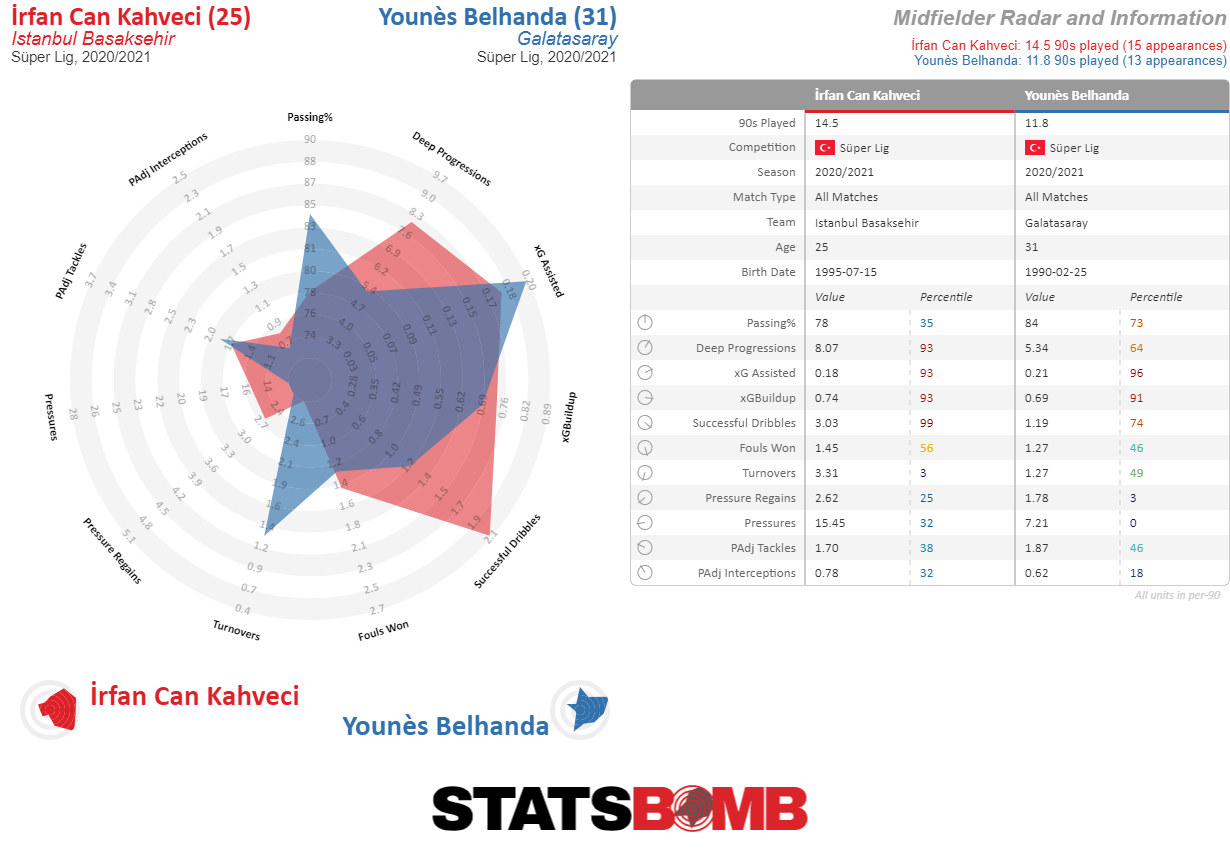
Alanyaspor In Freefall
Alanyaspor’s fall from grace is not like Başakşehir – their initial excellent start was entirely deserved, but so is their demise since late November. Their offensive output has fallen off a cliff, as seen below in their attacking radar. What happened? Teams started treating them like a big club in their tactical preparation, to the extent that even Fenerbahçe did, and they are so far finding it hard to break those defences down. It’s also telling that two of their wins through this terrible period came against Beşiktaş and Başakşehir - teams that were willing to play open.
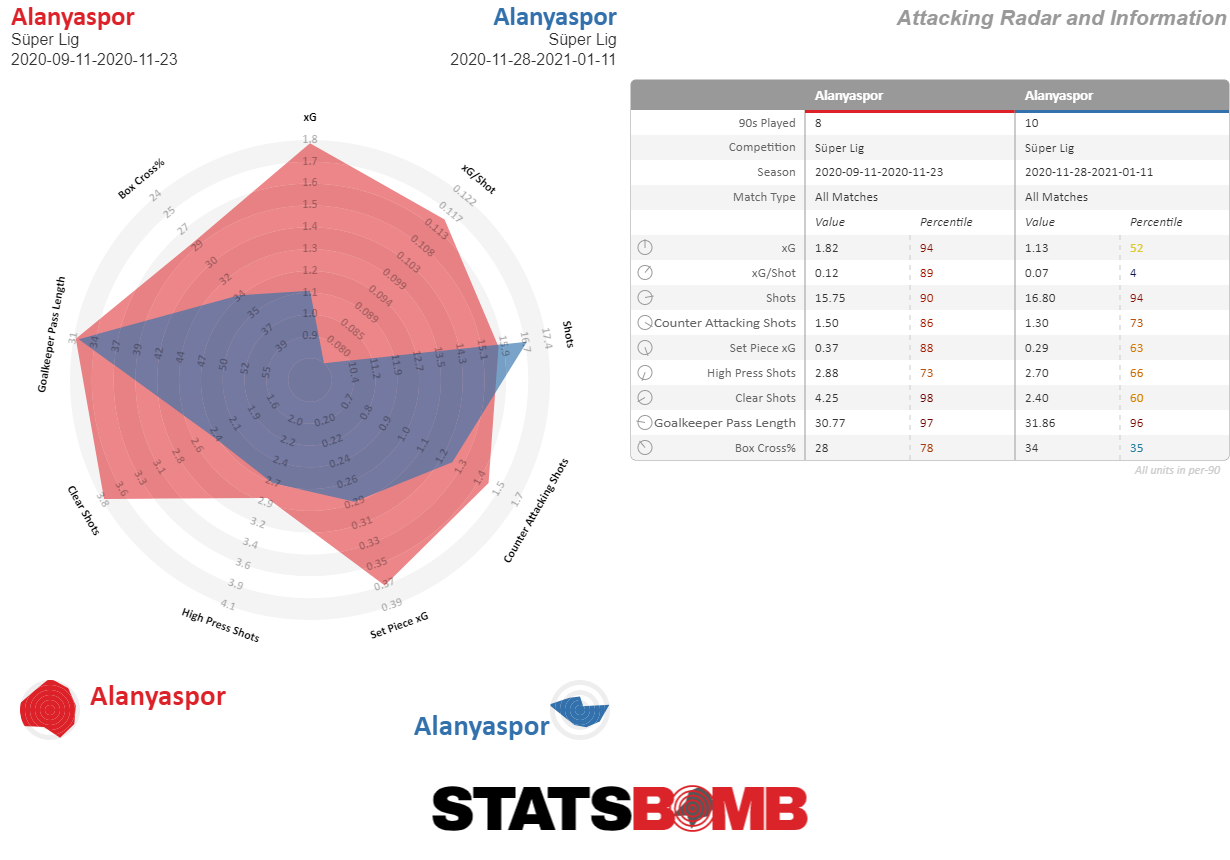
Aaron Boupendza
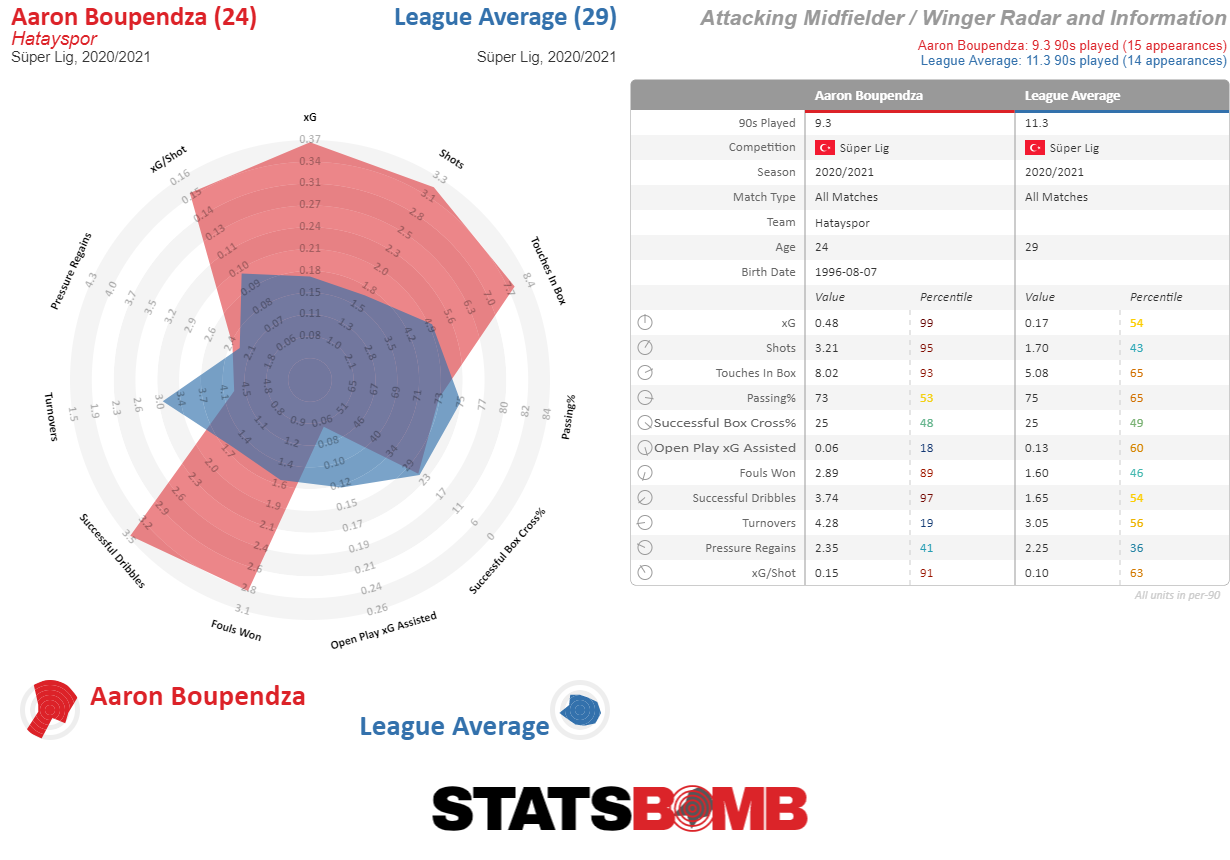
Finally, since we mentioned him at the start, here’s Aaron Boupendza’s radar. More of a goal-every-other-game type of underlying performance rather than 1.50 goals per 90 as you can see, but that’s not to take away from the start to his Süper Lig career.
Let’s see if he ends up as one of those that graduate to the big three of Istanbul.
If you are a club, media or gambling entity and want to know more about what StatsBomb can do for you, please get in touch.
What will México’s squad look like at the 2022 World Cup in Qatar? The qualifying process is yet to get underway in the CONCACAF region, but we can probably say with some degree of confidence that Mexico will make it. So we sat down with ESPN columnist and expert on all things Mexican football Tom Marshall to discuss the players likely to be on the plane in two years time.
Nick Dorrington (ND), Content Manager at StatsBomb: Hi Tom. Thanks for giving up your time to join us. Before we get to the players, how have Mexico generally lined up under Gerardo Martino in terms of formation and play style?
Tom Marshall (TM): Hello Nick. Thanks for the invite! So far, it’s largely been a 4-3-3 with one holding midfielder, although Martino experimented with a back three against Algeria in October and used more of a 4-2-3-1 in the second half against Japan in November. In terms of playing style, Mexico have employed the traditional hallmarks of a Martino team: usually a high press, trying to play the game in the opposition’s half, dominating possession while trying to be as vertical as possible, full-backs pushing high up, playing out from the back and trying to win the ball back as quickly as possible on the attack-defense transitions.
ND: So between the sticks, Guillermo Ochoa seems the obvious pick as first choice. Who else do you think will join him in the squad? Hugo González and Jonathan Orozco were the other two goalkeepers at the Gold Cup last year, so are they the most likely candidates?
TM: Ochoa is definitely the first choice right now. He has said he believes that González will be his eventual replacement and that’s probably the projection as of now. Alfredo Talavera has been in form this season for Pumas and should be in the conversation, although he is now 38 years old.
ND: As you say, Talavera has had an excellent season, outperforming expectation in relation to our Post-Shot xG model.
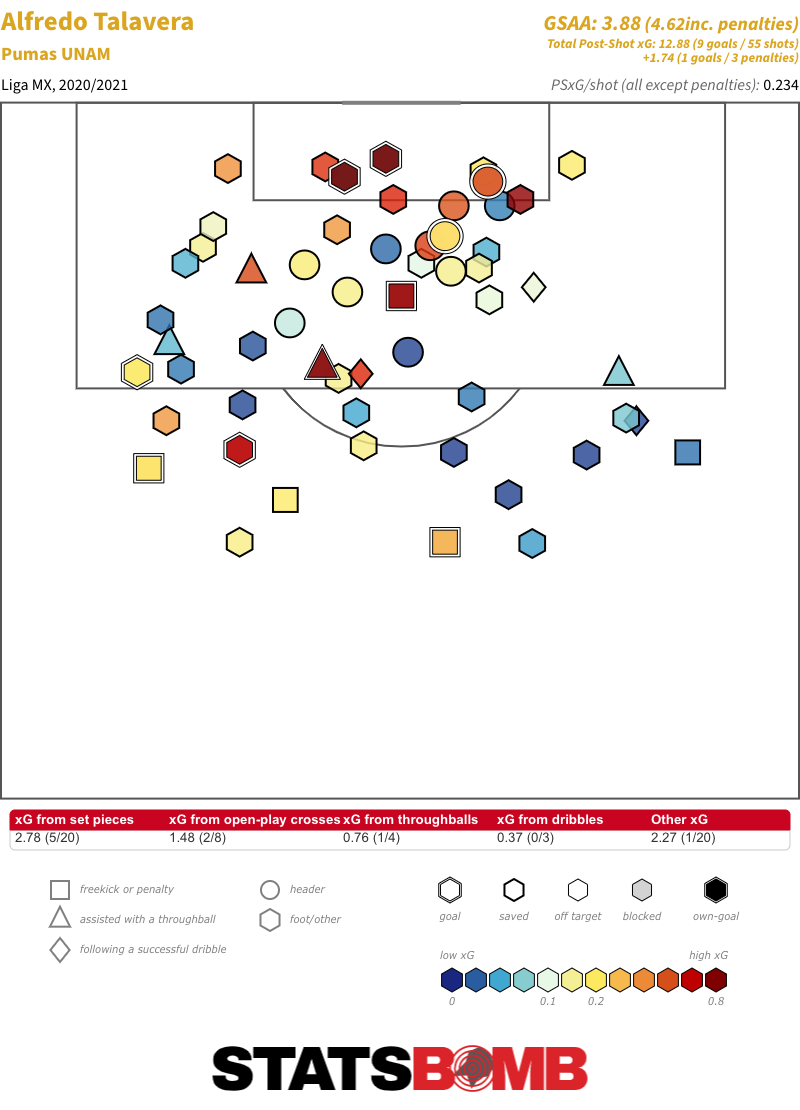
But he’ll be 40 by the time the World Cup comes around, and in 2019-20 his numbers were less impressive.
TM: As for Jonathan Orozco, he’s arguably the most suited to Martino’s style, but had a really poor season at Club Tijuana.
ND: What are the skills that Martino’s style requires of a goalkeeper?
TM: Martino is looking for a goalkeeper who is adept at playing out from the back to start attacks. It feels like right now he doesn’t have a perfect fit. Ochoa is a very good shot-stopper and high-level performer in big games, but not the most adventurous with the ball at his feet.
ND: Orozco does look to have had a poor season. By our numbers, only Gil Alcalá had a worse tournament among Liga MX goalkeepers in terms of shot stopping. But he really does stand out with the ball at his feet, particularly in terms of his calmness under pressure. Orozco was actually the only goalkeeper during the Torneo Guard1anes 2020 to improve on his overall passing completion rate when pressured. Ochoa went longer when pressed; Orozco went shorter.
(Yellow = successful pass; Red = incomplete pass)
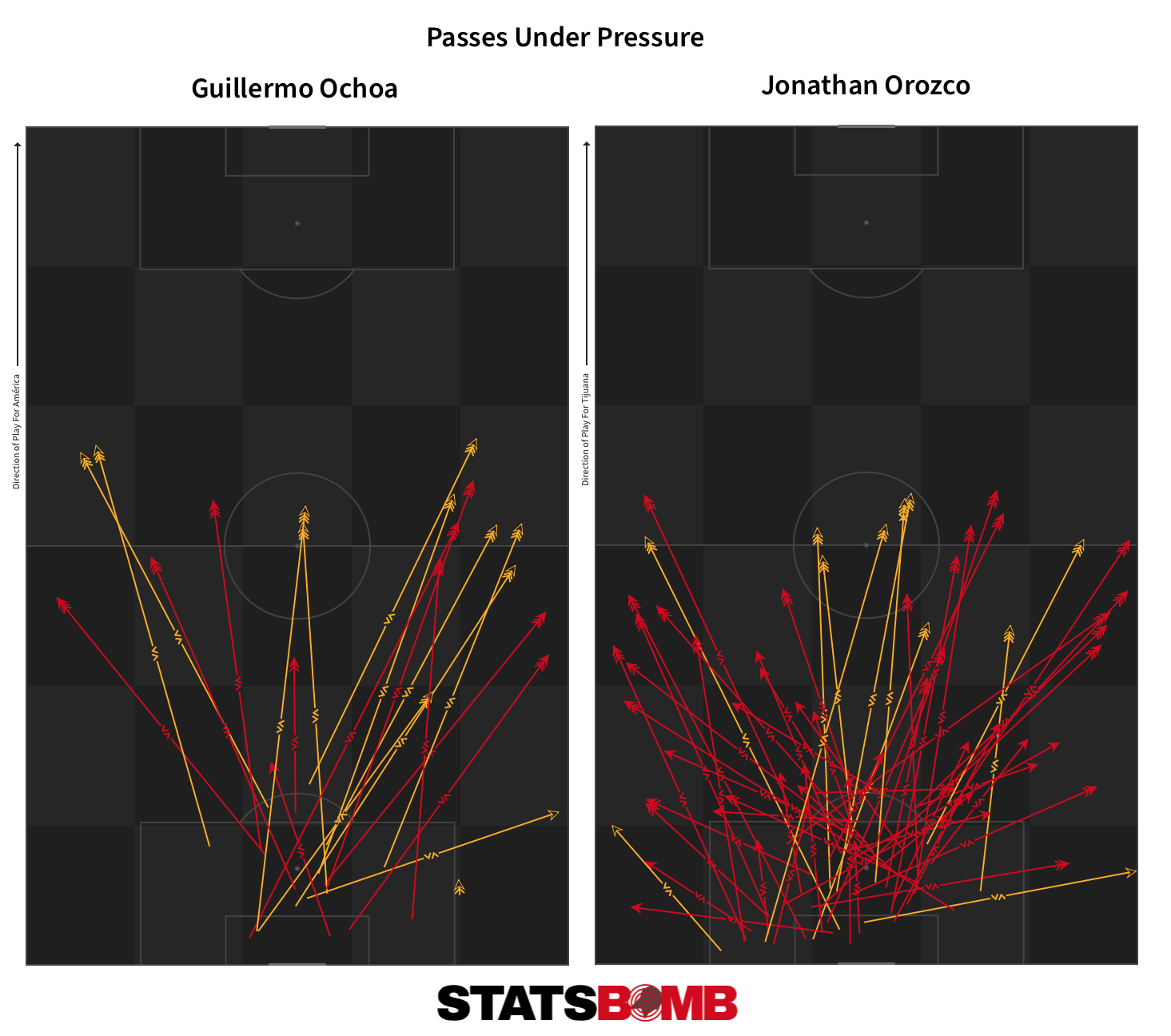
But even with a skillset that seems well-suited to Martino’s approach, you don’t necessarily think that Orozco will make the squad?
TM: It’s a tough one. I don’t think it is guaranteed based on Orozco not featuring for Mexico in 2020. Of the younger generation, I particularly like Luis Malagón (Necaxa) due to his comfort playing under pressure, while Carlos Acevedo (Santos Laguna) will likely get a shot and has been impressive this past season.
ND: Let’s move on to the defence. At full-back, Luis Rodríguez and Jesús Gallardo were the starters at last year’s Gold Cup. But Rodriguez will be going on for 32 by the time the World Cup comes around. Do you think his starting berth could come under threat? Who is most likely to edge him aside?
TM: Rodríguez is a good quality Liga MX player, but his starting role is by no means guaranteed for the national team. This is one of the more concerning positions for Martino. Jorge Sánchez is physical, has the stamina to get up and down as Martino likes, but tends to switch off too often defensively. Alan Mozo at Pumas has shown some potential, although I’m personally a bigger fan of Pachuca’s Kevin Álvarez, even if he hasn’t played too many Liga MX games. The other interesting option is Julian Araujo at LA Galaxy. He’s done well in MLS, but the caveat is that he hasn’t yet been persuaded to choose Mexico over the United States.
ND: Álvarez has also had some minutes at left-back, we could be a useful attribute. He seems to offer a good mix of strong defensive output and decent ball progression, particularly off the dribble.

Do you think Martino will take four dedicated full-backs or will one of the backups be a player, like Álvarez, capable of filling different roles?
TM: There are definitely a lot of options if he wants to cut a full-back. I like Érick Aguirre’s chances of making the squad for this exact reason. He can play in either full-back position, a number of roles in central midfield and even on either wing. Sánchez can and has played on the right and the left. And there’s the option of Jesús Corona as a wing-back as he’s played at times for Porto.
ND: In the centre of defence, Carlos Salcedo and Néstor Araujo look dead certs to make the squad. Who else do you think Martino will take?
TM: I’d assume Monterrey’s César Montes will be a certainty by then. He looks like he’ll be challenging for the start in the lead-up to Qatar 2022.
ND: Montes profiles like a solid, stand-off central defender with a decent passing range. Is that a fair assessment?
TM: I think that’s fair. It’s his physical attributes that also stand out. There aren’t too many Mexican center-backs with his size and strength. European clubs are certainly watching and the hope is that he’ll be playing in one of the top leagues by the World Cup.
ND: Who are the other options at centre-back? Will Héctor Moreno still be in the picture?
TM: Edson Álvarez is an option, while the two younger centre-backs that have stood out are Johan Vásquez and Gilberto Sepúlveda.

As for Moreno, he’s got a good chance of being in the squad because he is experienced and gets what Martino is looking for, especially in possession. The question is how much his level will drop between now and the World Cup given he’s an aging defender playing in Qatar.
ND: Moving forward, and presuming the 4-3-3 shape persists, who looks the likely starter at the base of the midfield? Am I right in thinking this has been somewhat of a problem position for Martino?
TM: Álvarez without any doubt. The truth is there aren’t many options. In an ideal world, Martino would have someone who could distribute the ball and be technically better than Álvarez, but I wouldn’t say it is a problem position necessarily. Álvarez is a leader, protects the defense well and already has World Cup experience. The issue for me is if he isn’t available.
ND: Is his relative lack of playing time at Ajax a concern? He’s been decent when he’s got on the pitch, but hasn’t done so a great deal since moving there from América in 2019.

TM: Yes, Álvarez has a battle on his hands at present. He’s perhaps too defence-minded for a side that dominates games in their domestic league. That said, I’d be confident that if he left Ajax, he’d be able to resurrect his career in a different European league. I’d love to see him in the Premier League and think he’d be successful at a mid-table team.
ND: Who are the other options for that defensive midfield position?
TM: Perhaps Luis Romo is next in line, but he’s arguably better further forward. Hector Herrera may be dropped back into a role he’s played before, although he doesn’t necessarily have the defensive capabilities. It's worth throwing out the name of 20-year-old Erik Lira, although he’s only really broken into the first team at Pumas this season.
ND: There seems to be a good crop of players in their early-to-mid twenties competing for the two interior positions ahead of the holding midfielder. We know that Mexico aren’t afraid of including older players in their World Cup squads -- Rafael Márquez in 2018; Cuauhtémoc Blanco in 2010 -- but will there still be a place for Andrés Guardado at 36? It could easily just have been a system thing, but there was a pretty clear drop off in his output at Real Betis from 2018-19 to last season.

TM: It’s going to take something big for Guardado not to be in the squad. He’s the leader of the team, the captain and commands respect. The experience he’s got at World Cups and playing in Europe should mean he is at least useful off the bench. Martino will be hoping that one of Carlos Rodríguez, Sebastián Córdova, Orbelín Pineda, Víctor Guzmán, Marcel Ruiz, Eugenio Pizzuto or Érick Gutiérrez will step up and earn that starting spot. As mentioned in the question, there are plenty of potential options and no shortage of talent, but those names are either still developing or have been too inconsistent to be able to confidently predict they’ll be in the XI at the World Cup.
ND: Is there a certain profile of player you think Martino will be looking for to fill those interior positions?
TM: The interior midfielders are prominent in Mexico’s press and Martino also likes technically gifted players there, often ones which would be number 10s on other teams.
ND: If we look at some of those names you mentioned, Pineda and Rodríguez look like talented players but both provide almost nothing defensively. Ruiz is a more conservative player, with solid defensive output and a safer passing profile. Cordóva and Guzmán look to have a better balance between defensive and offensive output, particularly Guzmán.

He also played on a Pachuca side who were one of the most active pressing teams in opposition territory during the Torneo Guard1anes 2020. Gutiérrez will also be playing on an aggressive pressing side under Roger Schmidt at PSV Eindhoven as and when he returns from injury. Now we’ll move on to the forward line, where there would seem to be a clear first-choice front three?
TM: Definitely. There is a lot of excitement in Mexico about Raúl Jiménez (fingers crossed everything goes well with his recovery), Jesús Corona and Hirving Lozano.
ND: They seem to have a pretty good mix of attributes. Lozano is a high-volume shooter, Corona creates more shots than he takes, while Jiménez combines solid shot volume with a good all-round game.

How has that worked out when they’ve played together for the national team?
TM: Not well! The first time Mexico lost 4-0 to Argentina and on the second occasion they were down 1-0 to South Korea when Lozano was taken off. Mexico went on to win 3-2. Martino criticized the trio for being static in that game against Argentina, indicating that they were too predictable. There was more fluidity though against South Korea and it feels more a case of them needing to play more regularly together to get used to each other's movements than the right mix not being present.
ND: Who do you think will fill the other two or three forward positions in the squad?
TM: Martino is a huge fan of the way Rodolfo Pizarro finds space and uses the ball between the lines. In fact, it’s not out of the realm of possibility that Martino could field Corona as a wing-back to allow Pizarro a starting spot. If Mexico use a 4-2-3-1, all four could also play.
ND: Pizarro is certainly someone who receives the ball all across the attacking midfield line.
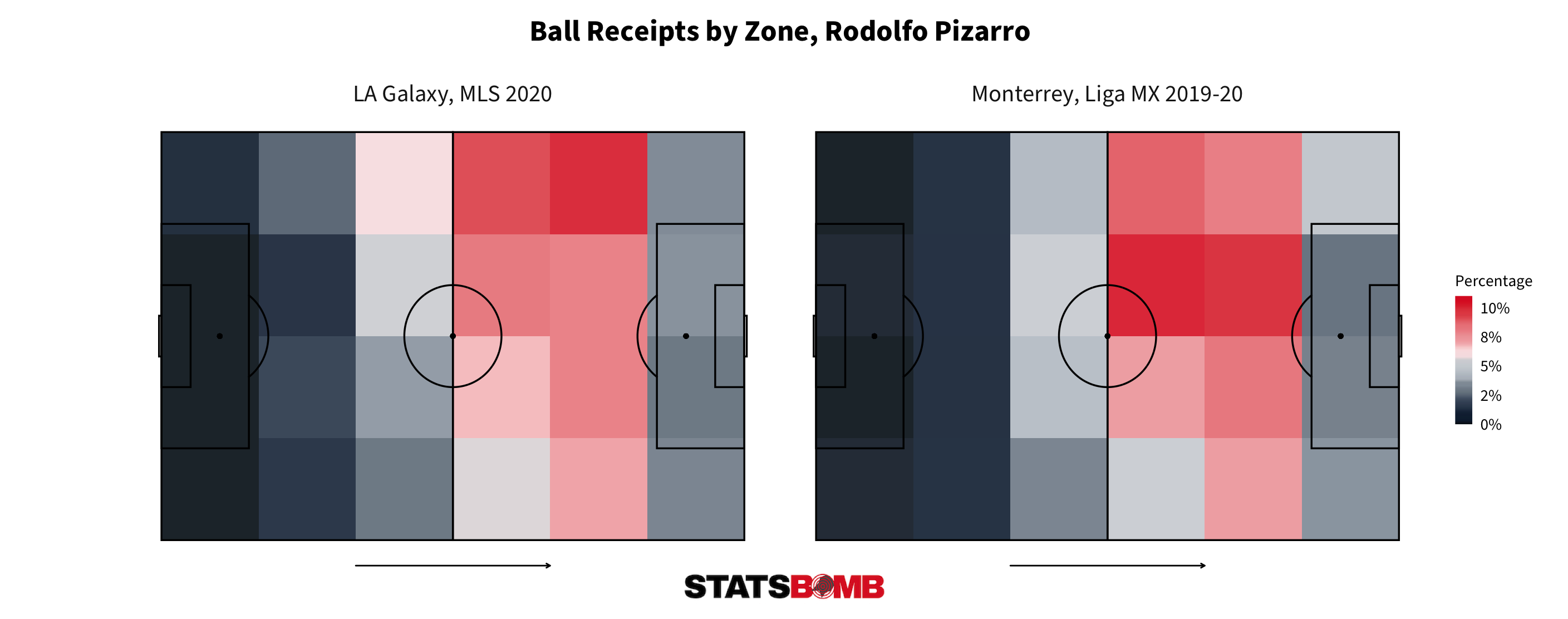
He doesn’t really stand out as a creative passer, but he can knit things together and make inroads off the dribble.
TM: Let’s not forget Diego Lainez. He may not be starting much for Real Betis, but he’s still highly regarded as a potential difference-maker.
ND: Is there an obvious backup to Jiménez as the central reference point?
TM: José Juan Macías should develop into that role by Qatar 2022. He’s got the ambition and professionalism to be an important player for Mexico, although he’s a different type of center forward than Jimenez.
ND: It will be interesting to see if he can reach that level. He looked very good in a small sample size when he returned to Chivas from his loan at León in January, but he didn’t have a great Torneo Guard1anes 2020. In fact, the young forward who really stood out was Cruz Azul’s Santiago Giménez. While he is more penalty area centric, Giménez also has a pretty similar statistical profile to Jiménez.

If he can add some other elements to his game, is he in with a shot of making the squad?
TM: 100 percent. He’s certainly part of a group of players who could be in the mix, including Rogelio Funes Mori, who is in the process of becoming a Mexican citizen, Javier Hernández, Alan Pulido and Henry Martín.
ND: The forward positions are often the ones in which younger players can suddenly emerge in the year or two leading up to the World Cup. Are there any guys not yet in contention who might make a leap forward in the intervening couple of years?
TM: Perhaps Marcelo Flores, who has impressed for Arsenal’s Under-18s. LA Galaxy’s Efraín Álvarez certainly has the talent to explode between now and then.
ND: One last question: with the squad that we’ve talked through here, can Mexico finally progress beyond the round of 16 at Qatar 2022?
TM: Yes! In all seriousness, Mexico will have a solid squad and I think will go into the tournament as one of the team’s to watch in terms of being aggressive and entertaining. Martino’s team won’t take a step back, even against the top teams. El Tri will need a little bit of luck and going into Qatar 2022 as a seeded team, which isn’t impossible with the new rankings system, would be a significant bonus.
ND: That’s great. Thanks again for providing us with your time and insight Tom.
TM: No problem at all. Thanks for having me.
Over the past few weeks we’ve highlighted the 'Similar Player Search' function in StatsBomb IQ and presented some use cases for the tool. Today, we’re going to look at a related feature we’ve recently added to our industry leading analysis platform: 'Similar Team Search'.
The functionality is almost identical to that of the player search. A team and radar type (Attacking, Defending or Custom) is selected and the algorithm then produces a list of teams with similar statistical profiles, ranked on a scale of 0-100, with 100 being an exact match. A selection of filters can then be applied to tailor the results as necessary.
This is a powerful tool that takes in data from the wide range of global competitions we collect (80+ from 2021), and one that has a number of potential use cases for clubs, including:
- Head Coach Recruitment: which teams employ a similar style of play to ours? Who are their head coaches?
- Tactical Inspiration: team x press in a similar way to us but seem to be more effective at suppressing shots. What are they doing differently?
- Player Recruitment: team x has a comparable approach to ours. Do they have any players who could be of interest to us?
Let’s look at a few examples using custom radars that seek to primarily identify stylistic rather than performance-related similarities.
We will start off with an attacking radar that attempts to capture team ball progression and chance creation style. Which teams come out as being similar to Manchester City, by some distance the Premier League's top scorers last season?
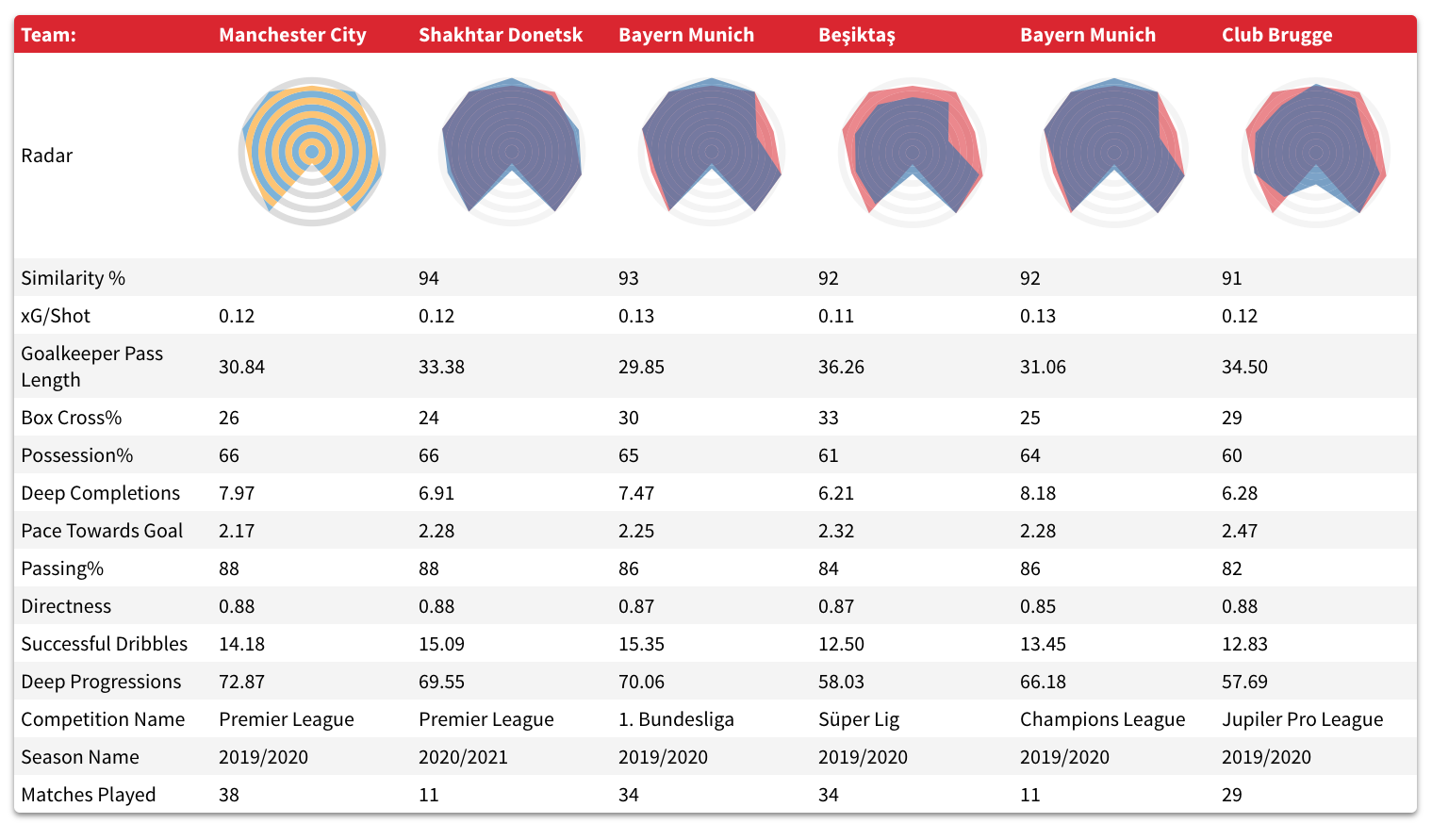
That looks like a promising list of high possession, territorially dominant teams. Slightly further down you’ll find sides like PSV Eindhoven, Crvena Zvezda and Flamengo -- the latter of whom were coached by Pep Guardiola’s former assistant Doménec Torrent prior to his dismissal last month.
Now let’s turn our attention to the defensive side of things, more concretely to the manner in which team press and counter-press. Our template in this case is Marcelo Bielsa’s Leeds side in their promotion campaign from the Championship. They were a team who pressed aggressively all over the pitch and made it difficult for opponents to advance into dangerous areas.
So which teams produce defensive outputs similar to those of that Leeds team?
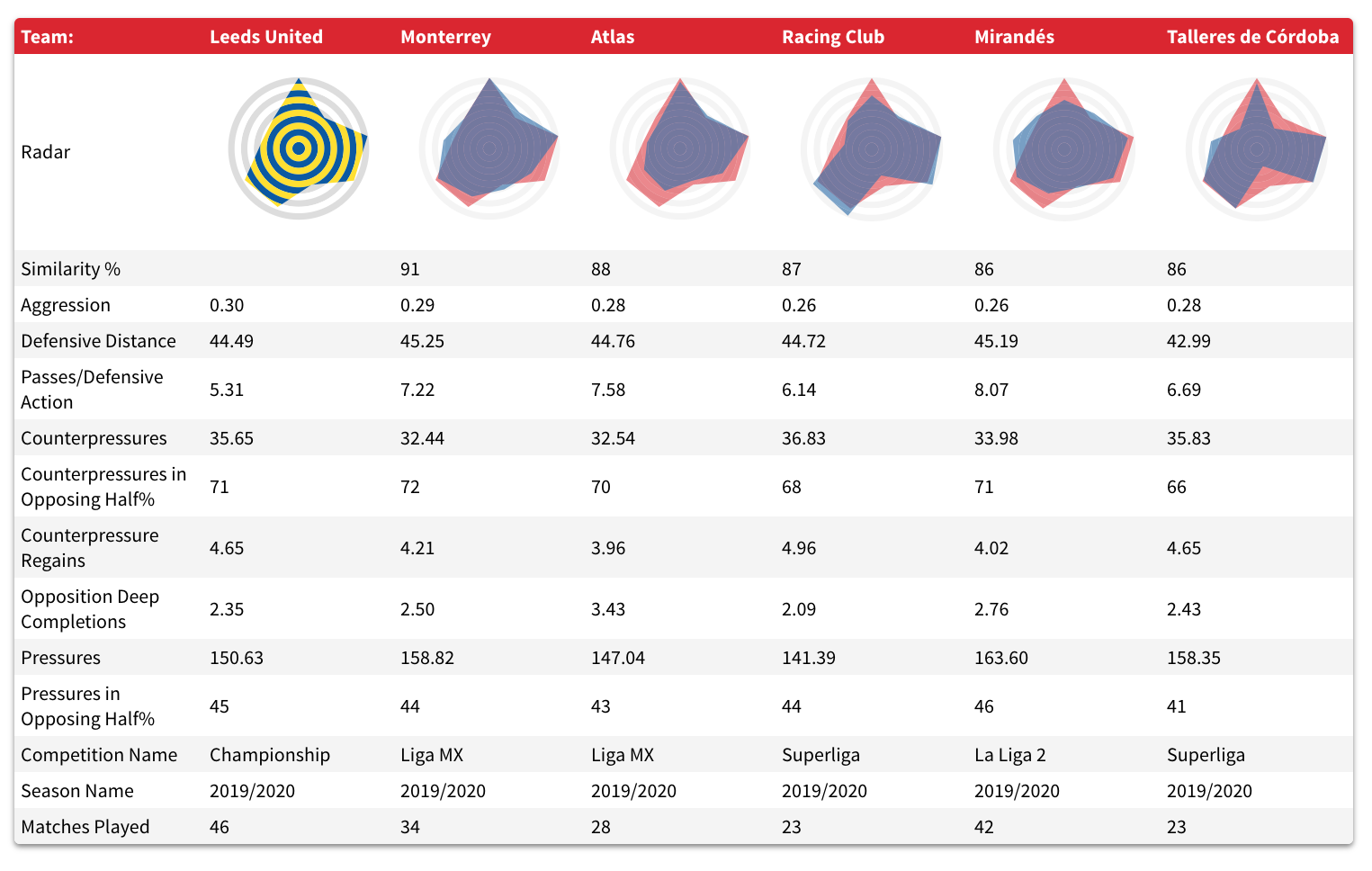
The two closest matches are Liga MX teams Monterrey and Atlas. Two sides from Argentina and Mirandés of the Spanish second division fill out the top five. Could this be a good starting point for an eventual search for Bielsa's replacement?
Finally, let’s look at a global radar that seeks to capture where and how teams defend and how and at what pace they transition from there to attack.
Getafe seem like a good example here, given that they employ an aggressive high press but combine that not with a high percentage of possession, as is often the case with pressing teams, but with a low possession share and quick and direct attacks. If José Bordalás was to leave tomorrow, who would be capable of replicating the approach that has helped lead them to three consecutive top-eight finishes since returning to La Liga in 2017?
Well... Diego Dabove of Argentinos Juniors would seem to be a pretty good candidate. Not only are his side the closest statistical match to Getafe, but there would also be no language barrier to overcome.
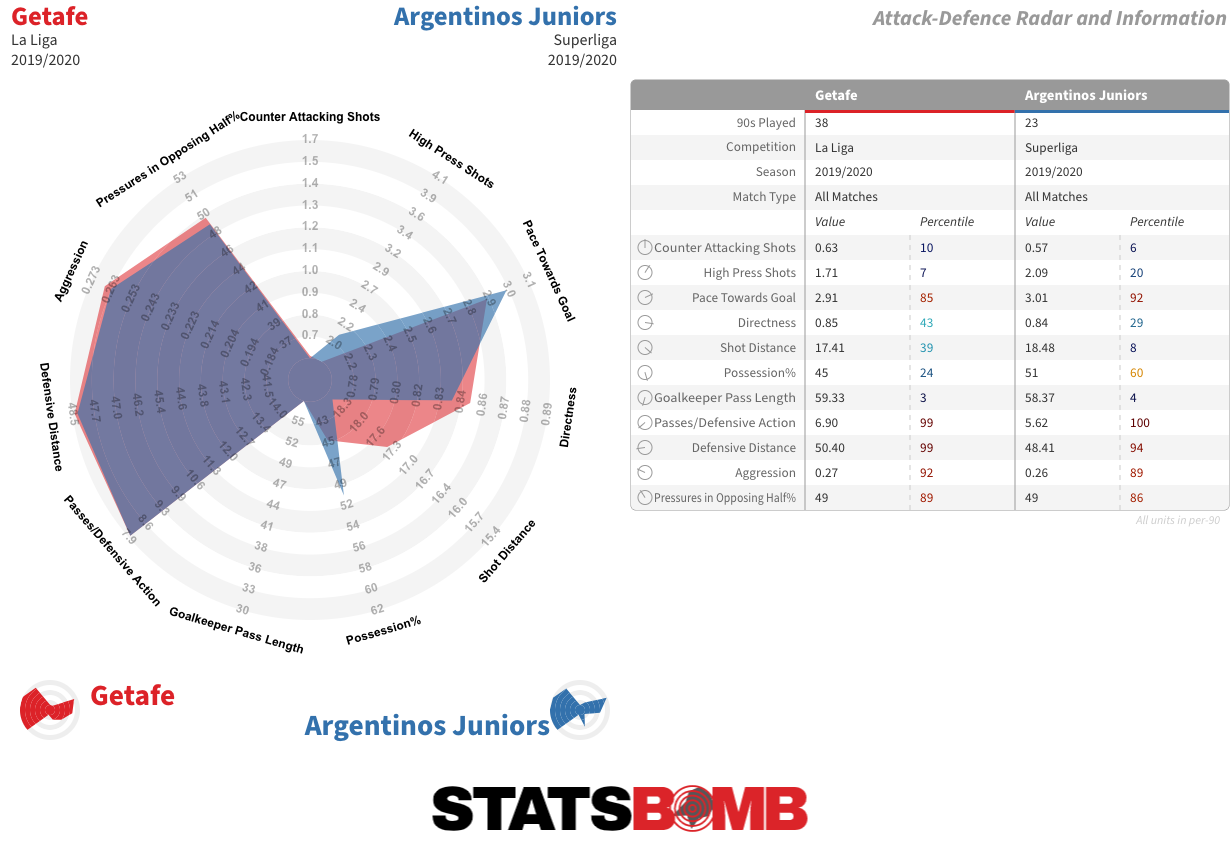
Other close matches include Slovácko of the Czech First League and Valérien Ismaël’s Barnsley.
That was a quick run through of the new 'Similar Team Search' function in StatsBomb IQ. With a wide variety of metrics to choose from, it is highly customisable tool, and we are certain our customers will utilise its functionality in ways we haven't yet conceived.
If you are a club, media or gambling entity and want to know more about what StatsBomb can do for you, please get in touch.
We are currently offering an extended 14 day free trial of our analysis platform StatsBomb IQ to potential clients.
Last week, we highlighted the ‘Similar Player Search’ function within StatsBomb IQ and provided some examples of its utility. We also ran a special request line on our Twitter account. This week, we are going to look at a concrete example of a doppelgänger in practice: Adam Armstrong of Blackburn Rovers. Armstrong has begun the Championship season in fine fettle. Fourteen matches in, he not only leads the league with 13 goals (including three penalties) but his underlying numbers are also off the charts, quite literally in fact:
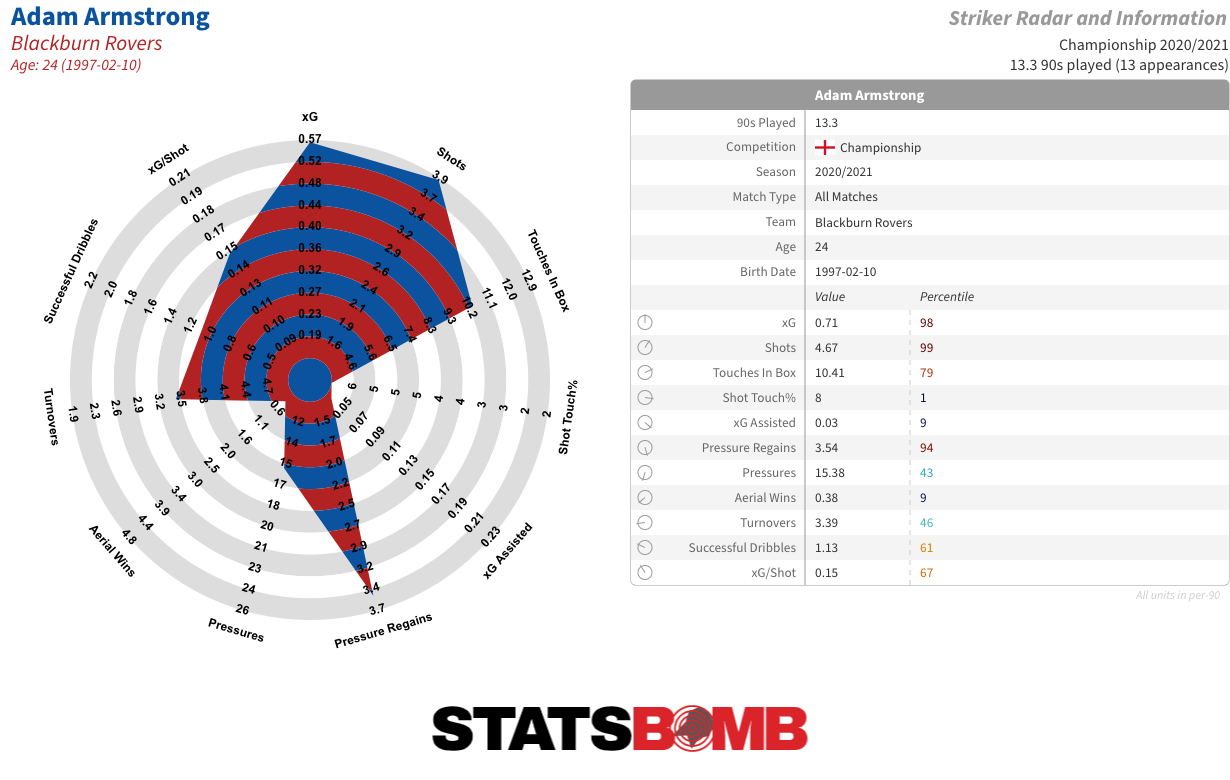
A sum of 0.71 xG per 90 puts Armstrong in the 98th percentile for that metric and some distance ahead of anyone else in the Championship. Consistent minutes through the centre have also seen him begin to post up 99th percentile shot numbers. He doesn’t create much for teammates, doesn’t win many aerial duels and a high proportion of his touches are shots. In short, he profiles like a pure goalscorer. Add in a solid contribution to Blackburn’s pressing game -- they are one of the most active teams in the Championship -- and you have the sort of output that produces comparisons to some of the finest strikers in Europe when you run his numbers through our ‘Similar Player Search’ function.

It remains to be seen whether Armstrong can maintain his early-season numbers over the full course of the campaign, but that is exalted company. There is, though, another statistical match just outside that top five that is particularly compelling, one that we’ll come back to once we’ve told the story of Armstrong’s winding path to a potentially breakthrough year -- a story that illustrates that player development is rarely linear.
On the opening day of the 2015-16 League One season, an 18-year-old Armstrong scored both goals for Coventry City in a 2-0 win over eventual league winners Wigan. One week later he would score two more in a win away to Millwall -- another strong side who finished runners up in the playoffs. It was quite the statement. Nobody expected much from a kid on loan from Newcastle but the talent he possessed -- the pace, the movement, the finishing -- was immediately apparent. The goals at Millwall showcased his sheer audacity: a 36-yard lob over the keeper was followed by a delightful chipped finish after leaving a centre back in the dust.
Armstrong went on to score 20 goals for Coventry that season in one of League One's most exciting teams. He was the central striker in a 4-2-3-1 formation, with young academy graduate James Maddison as the 10, Liverpool loanee Ryan Kent on the left, and Jacob Murphy on the right. The double pivot consisted of John Fleck and, erm... Joe Cole. That team was a nightmare for League One defences and it created the perfect environment for Armstrong to thrive.
The following season he was loaned to Barnsley in the Championship and struggled for game time despite managing 0.42 goals + assists per 90. The next season saw a loan to Bolton, one of the Championships poorest attacking sides. He only managed one goal, so Newcastle recalled him in January and sent him out to Blackburn in League One. There, he was reunited with his former Coventry manager Tony Mowbray. Blackburn got promoted that season and immediately purchased Armstrong outright. But back in the Championship, he struggled in a unfamiliar wide role:
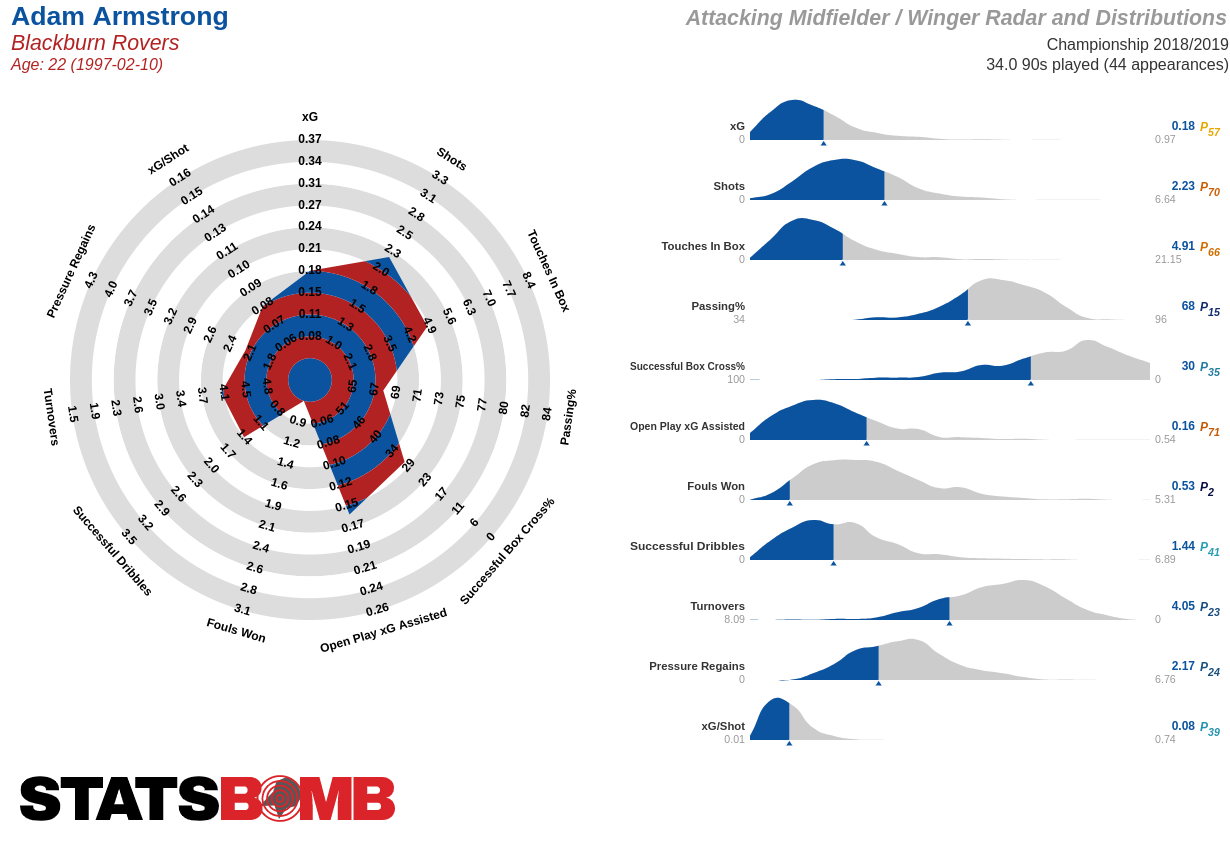
The following season he got more time as a nine, and the goals started flowing again: 16 for the season, alongside six assists. But the underlying numbers weren't as impressive and his goal tally was largely propped up by unlikely returns on long-rangers:
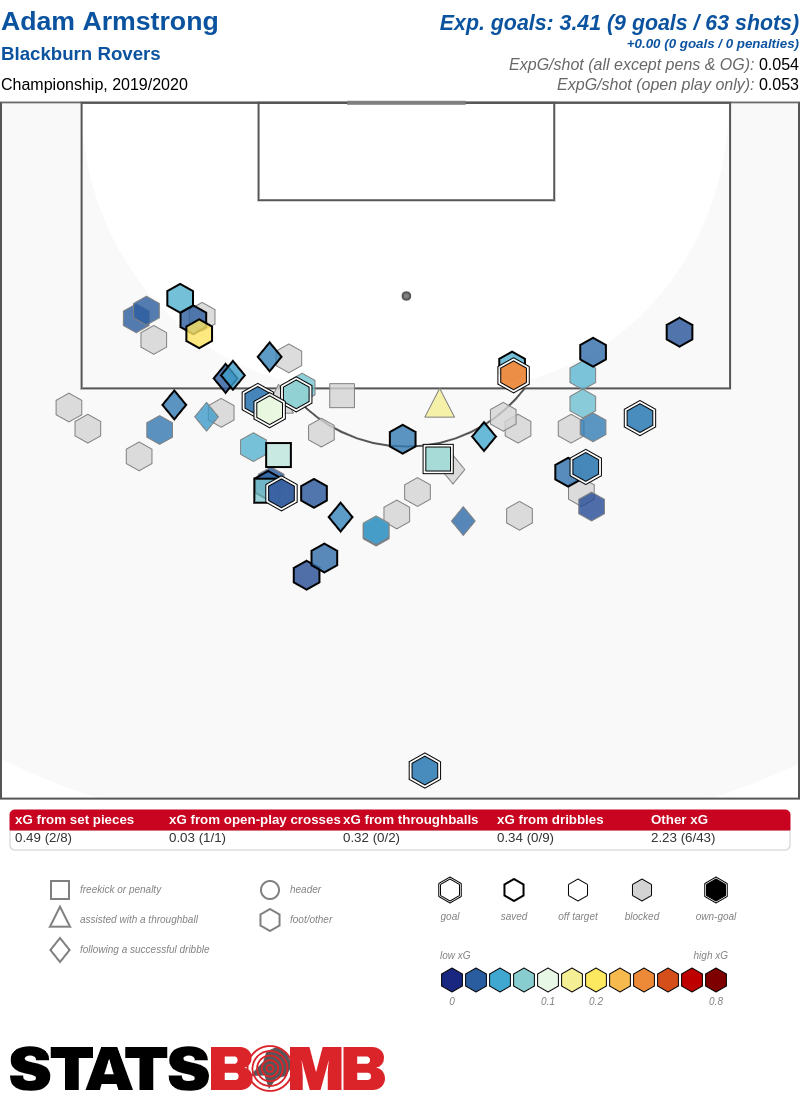
This season though, Armstrong finally finds himself in a similar environment to one he excelled in at Coventry. He's the sole striker, and when Bradley Dack returns from injury he'll have a player just behind him who was the other standout number 10 alongside Maddison in that 2015-16 League One season.
Young winger Ben Brereton plays on the left, Liverpool loanee Harvey Elliott is on the right, while Lewis Holtby takes up the Cole role as midfield creator That context has helped produce the stellar statistical profile that makes him a close match, at least at a lower level, to some of the top strikers in Europe. But we’ll now return to the player who feels like his most apt match: Danny Ings.
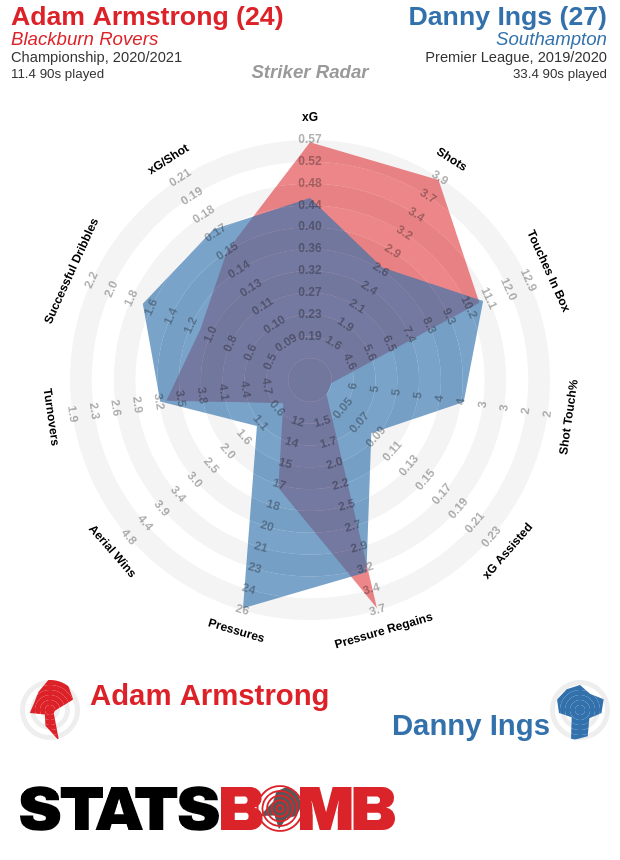
There are plenty of similarities between the two goalscorers. Out of possession, both function well in high press teams, but you can see how much more Ralph Hasenhüttl demands from his strikers as Ings manages nearly nine more pressures per game. On the ball, both show great movement to get the quality of chances they do, and they can both finish well off of either foot. Movement in behind has always been one of Armstrong's strong suits, especially in transition:
If he's in your blind spot you can bet he's about to get in front of you. Ings can't leave defenders behind like Armstrong can -- not since the injuries anyway -- but he's still a clever operator in the blind spot and offers much more in build-up play when he drops off the front to receive. You can see Ings edges Armstrong in xG assisted and successful dribbles, while a lower proportion of his touches are shots. Armstrong is getting better in this aspect though and you can see here against Coventry he was keen to take up a position between the lines during build-up play:
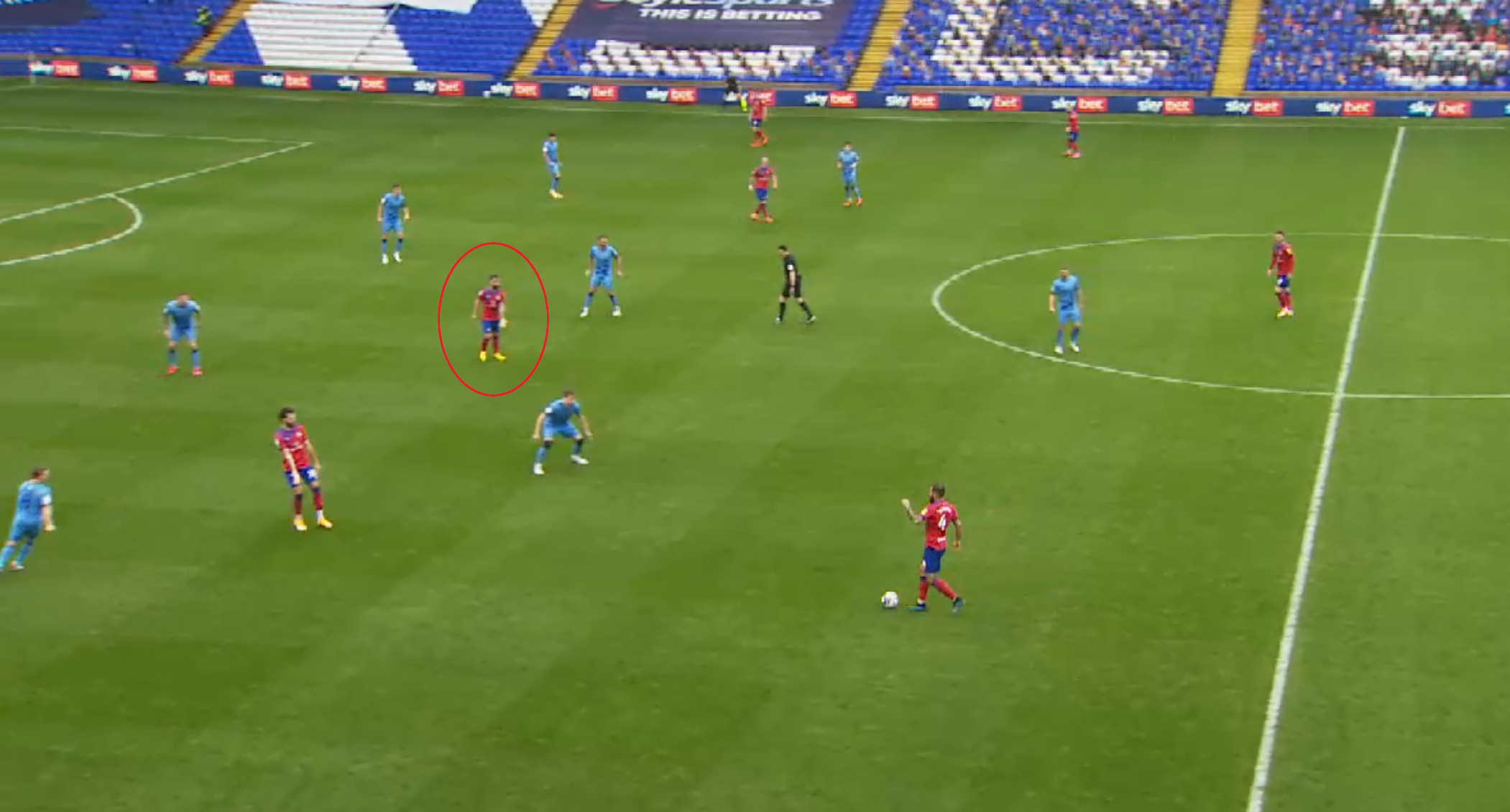
Back when he was playing for Coventry he would have sat on the last line here and expected Maddison to occupy that zone. As soon as Brereton receives on the turn, Armstrong is off like a rocket and gets himself a familiar goal.
Coincidently, up until about a fortnight ago, Armstrong and Ings had accumulated exactly the same xG total and almost identical goal tallies over the last couple of years:
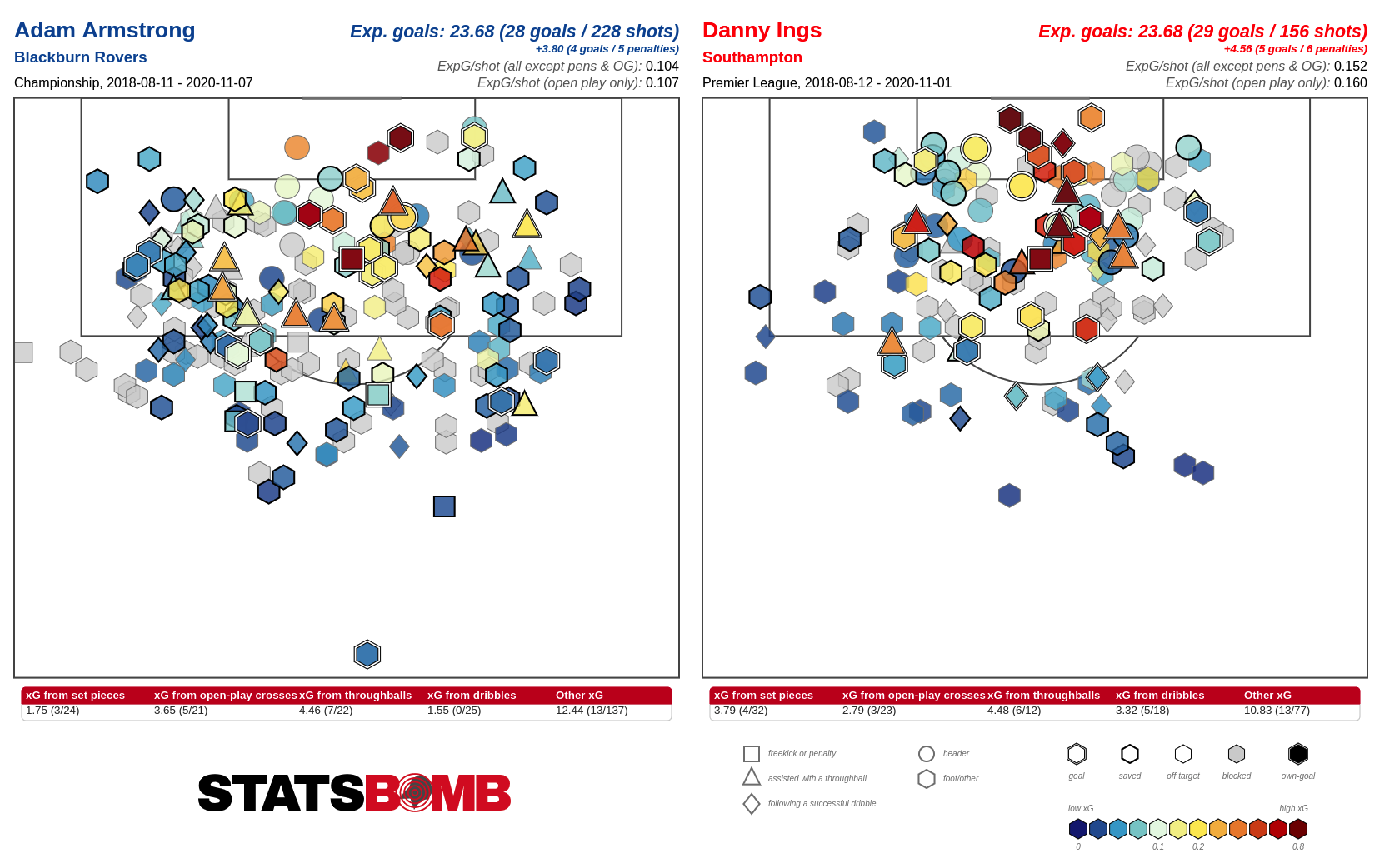
Both players overperformed their xG by a similar amount in that time, but they got there in different ways. Armstrong took more shots than Ings, who shot less often but from better positions. Shot selection is certainly one area Armstrong can improve on as Ings shows more awareness and maturity in that regard. Restricting the bad shots and choosing to move on possession instead will really help Armstrong scale his talents to the Premier League.
That is exactly where he might find himself next season, regardless of whether Blackburn are able to convert a solid start into a genuine push for promotion. If he does, a role as backup and eventual replacement for Ings at Southampton seem as good a fit as any.
Welcome back to the Süper Lig, the Wild East where Loïc Rémy is topping the scoring charts. And don't even ask why there are 21 teams in the league and no relegation last season! Nine matches in, the holders are struggling, we have a surprise leader, and the traditional powers have had varied starts. Let’s take a look at what’s going on with help from the underlying numbers.

Alanyaspor: the new surprise package
When I last wrote about the Süper Lig here last season, Sivasspor were top of the league, but it always seemed unlikely they'd win the title, mainly because they were heavily overperforming their underlying numbers. And so it was, because they ended up finishing fourth. This time around, surprise leaders Alanyaspor’s place at the top of the table looks completely warranted. Their underlying numbers do suggest overperformance in relation to their goal difference (they scored 3.5 more and conceded 4.5 less, probably skewed by the 6-0 against Hatay), but they really have been the best team in the league so far.
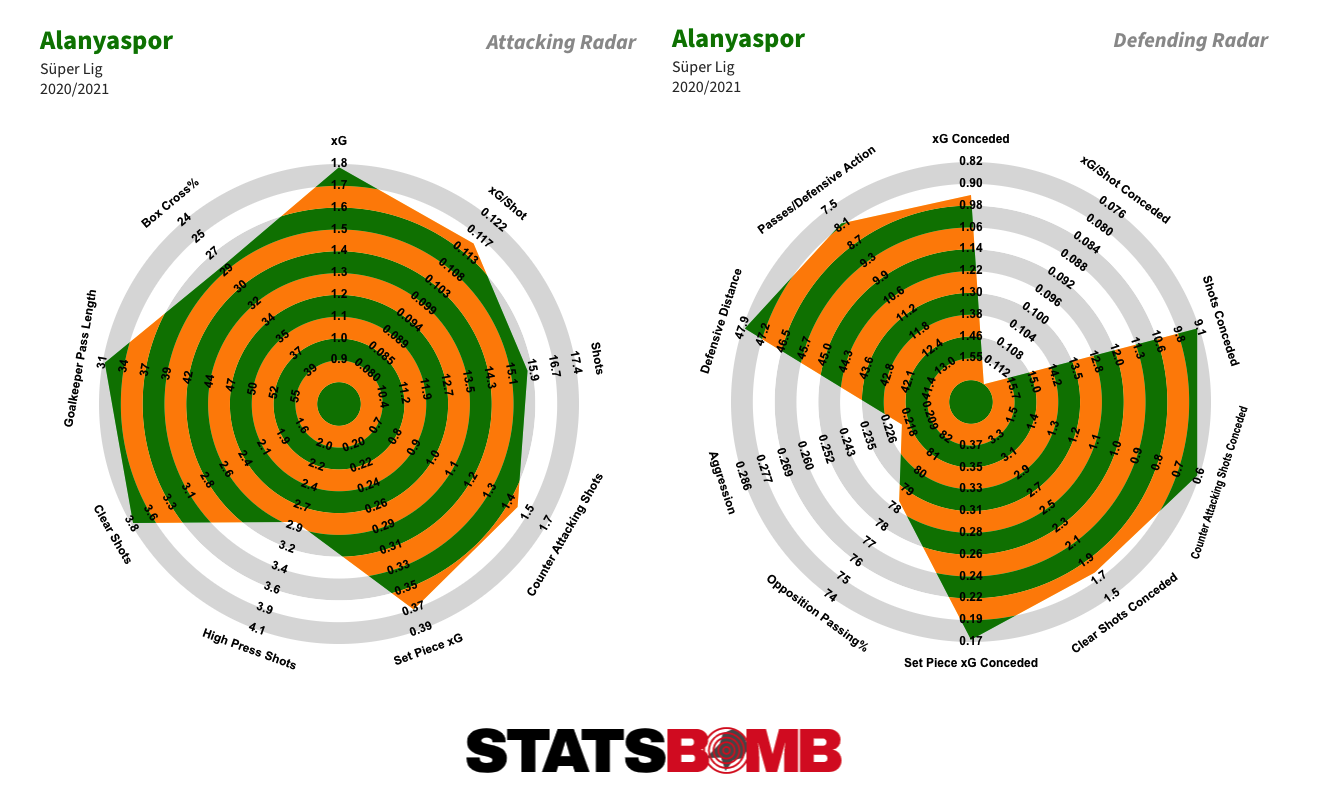
What makes them special? They are actually very good at pressing, which is rarer than you would think in the Süper Lig. It helped them to a statement win away at Galatasaray, forcing Oghenekaro Etebo into an early red card. But the really special thing is a different story -- perhaps the best actual footballing story in Turkey for a good while.
Alongside their debutant new manager Çağdaş Atan, who has spent the last five years as the assistant manager of Beşiktaş coach Sergen Yalçın, Alanyaspor hired Sassuolo’s 31-year-old goalkeeping coach Francesco Farioli as assistant manager. The Italian, who arrived from one of the most tactically astute teams in Europe, has absolutely transformed Alanyaspor’s Portuguese goalkeeper Marafona and the team’s buildup play along with it. Let’s take a look at Marafona’s open play passes this season.
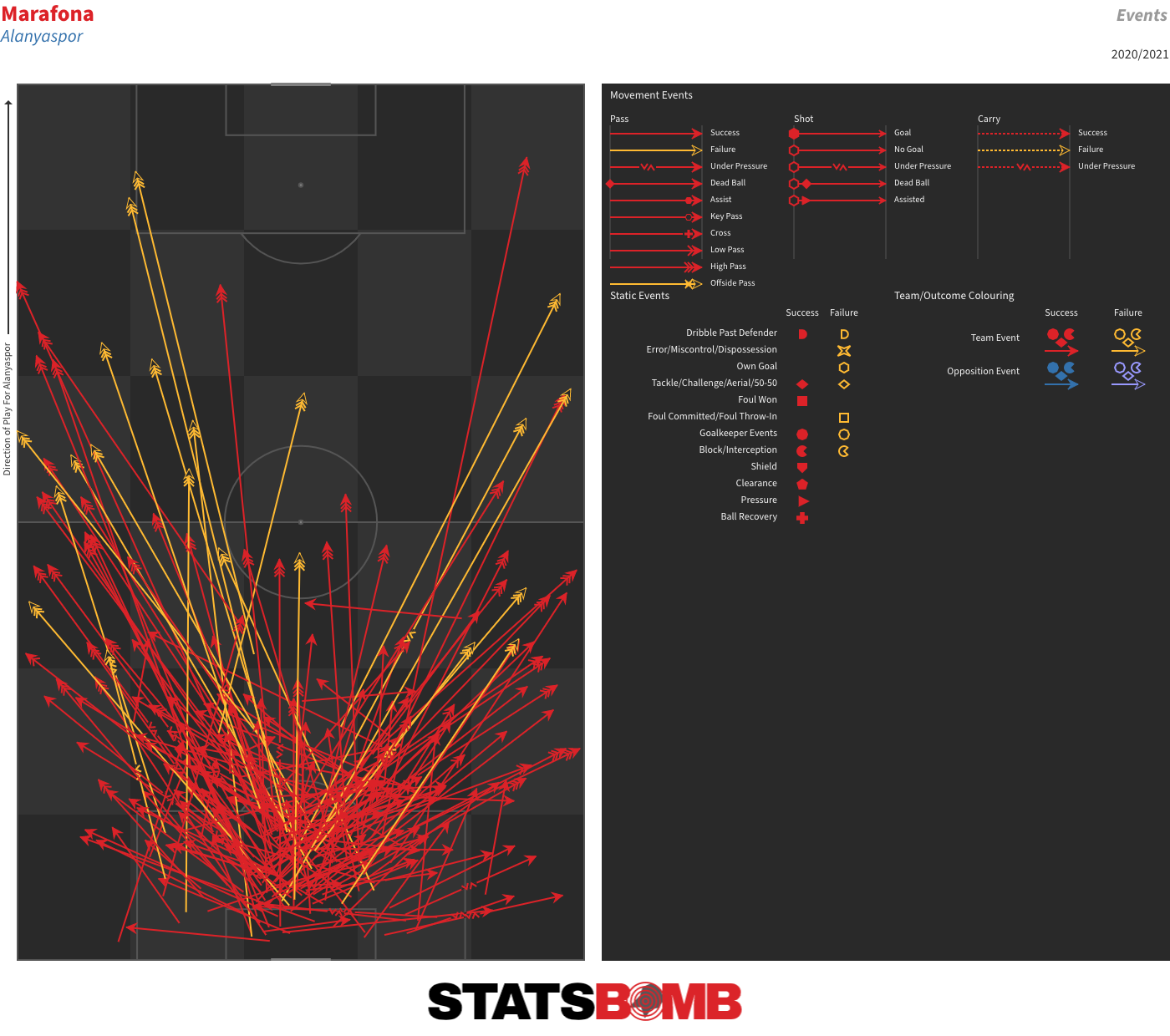
Marafona’s open play passing statistics, at 25 passes per 90 with 90.5% accuracy (versus 16 per 90 with 74% accuracy last season), are comparable to those of some of the top ball-playing goalkeepers in the world. Ederson posts 21 passes per 90 with 87%; Alisson, 23 passes per 90 with 84%. The Süper Lig's most renowned ball-playing goalkeeper, and Turkey’s number one, Mert Günok makes 17 passes with 76% accuracy.
Fenerbahçe: the set-piece kings
Fenerbahçe look on par with Alanyaspor in terms of their xG difference and seem to warrant their place alongside them at the top, albeit with one more game played. That is, though, in part due to an extraordinary performance on set-pieces, and they have serious problems in open play which results haven't yet fully reflected.

To be fair, Fenerbahçe’s new coach Erol Bulut was dealt a luxurious but tough hand. Freshly arrived from Alanyaspor late summer to his first job at a big club, the 45-year-old was handed 16 new players to integrate in a season in which Fenerbahçe president Ali Koç is going all-in for the title. There is absolutely zero tolerance for any other outcome. Bulut is playing it safe and doing what he does best. His career to date has taken in successful spells at Yeni Malatyaspor and Alanyaspor, with both sides set up on strong defensive fundamentals and largely hitting opponents in transition rather than dominating games with intricate possession play.
So far, Fenerbahçe boast the best defensive numbers in the league, at only 0.63 xG conceded per game. That is down from 1.14 last season, which clearly shows the huge progress he has made on the defensive side of things. They are showing good signs on the pressing front. However, although there has been gradual improvement, Fenerbahçe will have to produce more open play xG if they are to sustainably break down defences in this 40-game season. So far they are looking short of ideas other than crosses.

How are Fenerbahçe at the top of the table with that attacking radar? Well, because at their current pace of 0.60 set-piece xG per game, they are on a 24-goal pace for the season. They have already scored five. Out of the 17 goals they notched in total, a further four have come from penalties (which is probably not sustainable), and only eight have been from open play (three of them via crosses). None of that is to undermine how important set-pieces are.
It is an aspect of the game that is getting more and more attention, and Erol Bulut seems to be the top coach for it in Turkey. His Alanyaspor also had the best set-piece xG in the league last year with 0.44 per 90, level with Beşiktas, and he brought Beşiktaş’s set-piece taker Caner Erkin with him to Fenerbahçe. They are so far proving to be a power couple, but Fenerbahçe eventually have to improve their possession play and add other weapons to their arsenal if they want to win the league.
Galatasaray: buildup issues appear resolved; they look like a contender
In terms of underlying numbers, Galatasaray were by far the best team in the league in the second half of 2019-20, with 0.72 xG difference per game, far ahead of Beşiktaş in second with 0.39. Fatih Terim’s tactical changes played a key role in that. However, post-COVID-break injuries and results going against them meant that their season pretty much came apart by the end of June. Changes in the squad called for altered tactics going into 2020-21. Galatasaray came into the season with very low expectations after key loanee players Jean Michaël Seri, Mario Lemina and Henry Onyekuru departed, playmaking full-back Mariano left, and star goalkeeper Fernando Muslera went down injured. In fact, they were touted as a crisis club before a ball was even kicked.
The only notable first team additions they were able to make were dynamic right-back Omar Elabdellaoui on a free from Olympiakos and midfielder Oghenekaro Etebo on loan from Stoke. Centre-back Christian Luyindama's return from a long-term injury felt like a new signing, too. However, at least on the pitch, things are looking up for Galatasaray. Their xG difference of 0.75 per game is on par with their successful second half of last season, and not far behind Fenerbahçe and Alanyaspor.
They began the season with two impressive wins against Gaziantep and holders Başakşehir, then went into a slump after Fenerbahçe coach Erol Bulut laid down a template for other coaches on how to press and stifle their buildup play in the 0-0 draw between the sides. Galatasaray went on to lose two in a row against two of the best pressing sides in the league in Kasımpaşa and Alanyaspor, before recording two unimpressive victories against Erzurumspor and Ankaragücü. Terim then made a slight tactical tweak for the Sivasspor and Kayserispor games that not many people in Turkey picked up, despite Arda Turan explaining it in his post-game interview after the away win at Sivas.
He said that he was now being asked to roam between the lines rather than position himself wide, which contributed to him grabbing the winner and to the team functioning better in possession. From the more rigid 4-1-4-1 with which they started the season, with a 2-1 buildup, wingers positioned wide and number eights pushing high, Galatasaray’s 4-1-4-1 now looks very fluid in possession with plenty of options between the lines and in the halfspaces, another midfielder dropping to help buildup, and fullbacks pushing into much higher areas. Galatasaray played a hugely impressive 60 minutes against Sivasspor before dropping off late but edging it. They then produced a staggering 3.8 xG against Kayserispor despite the absence of five regular starters and were extremely unlucky to draw the game. Considering Galatasaray have got through three fixtures against their potential title rivals and that their the open play performance is trending up, there’s reason for optimism for Terim’s side.

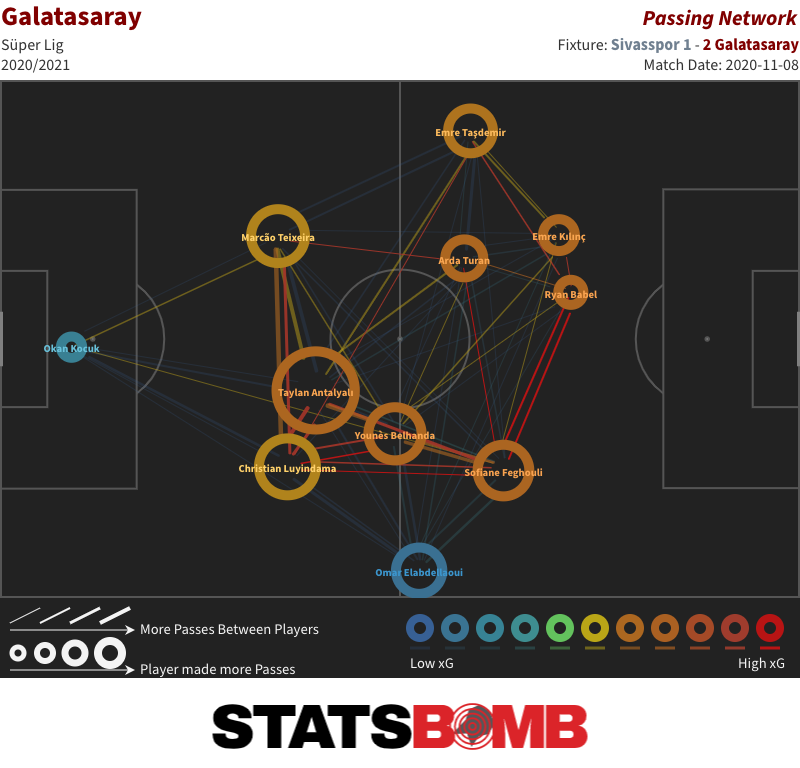
First half passing network is used
Beşiktaş: a long season ahead for Sergen Yalçın
Beşiktaş has the worst outlook among the big three of Istanbul. Like Galatasaray, they couldn't stretch beyond loan signings and free transfers in the off-season, and it looks like their steady decline since the glorious 2017-18 season in which they reached in the last 16 of the Champions League will continue. Not much is going on tactically either, and it seems like some nous there was lost after former assistant manager Çağdaş Atan left for Alanyaspor, considering what a special job he’s doing there.
One bright spot looks to be their Canadian forward Cyle Larin, who is consistently getting great chances and has five goals to his name so far, four of them while playing off the left. If he can improve his off-ball contribution, it looks like Beşiktaş have found themselves a functional wide forward with significant box presence. That’s potentially a good balance with new signing Rachid Ghezzal on the right, who is looking like the main creative outlet of the team.
Başakşehir: title defense proving tricky, but underperforming their numbers
Finally, Başakşehir. The holders took just a single point from their first four games, then notched up four straight wins before losing away to Beşiktaş this past weekend. What’s interesting is that their xG difference of 0.57 per game is better than last season’s title-winning 0.46. They combine a mid-table xG conceded sum of 1.10 with an attacking output of 1.68 xG per game that is better than last season and second only to Alanyaspor this time around.
They have scored two less and conceded two more than their underlying numbers so far. It is hard to talk about Başakşehir without talking about Edin Višća. The epitome of consistency, he's missed just two games in the league since the beginning of 2013-14. He contributed to last season's title with 13 goals and 13 assists, overperforming both his xG and xG assisted metrics by about 2.5 each. He has started the new season with three goals and two assists, which is good, but his underlying performance suggests he is tailing off a bit, which would definitely be a worry for Başakşehir.

It’s too early to draw conclusions, but so far Alanyaspor have been the best team in the league, followed closely by the Istanbul giants Galatasaray and Fenerbahçe, who are both out of Europe and fully focused on winning the league. Başakşehir have the oldest squad, a Champions League campaign to contend with, and have already bled some points, but they are also strong enough to put together a title challenge considering there are still 31 games left to play. A four-horse race looks to be shaping up.
At StatsBomb, we are committed to providing our customers with the tools they need to succeed. Our analysis platform StatsBomb IQ is designed by and for football professionals, and includes a number of essential features for those working within the recruitment space. It will also soon count upon an upgraded scouting section that will take into account the feedback we’ve received from end users.
Among the tools currently in IQ is one that can act as a useful starting point for any scouting process: Similar Player Search.
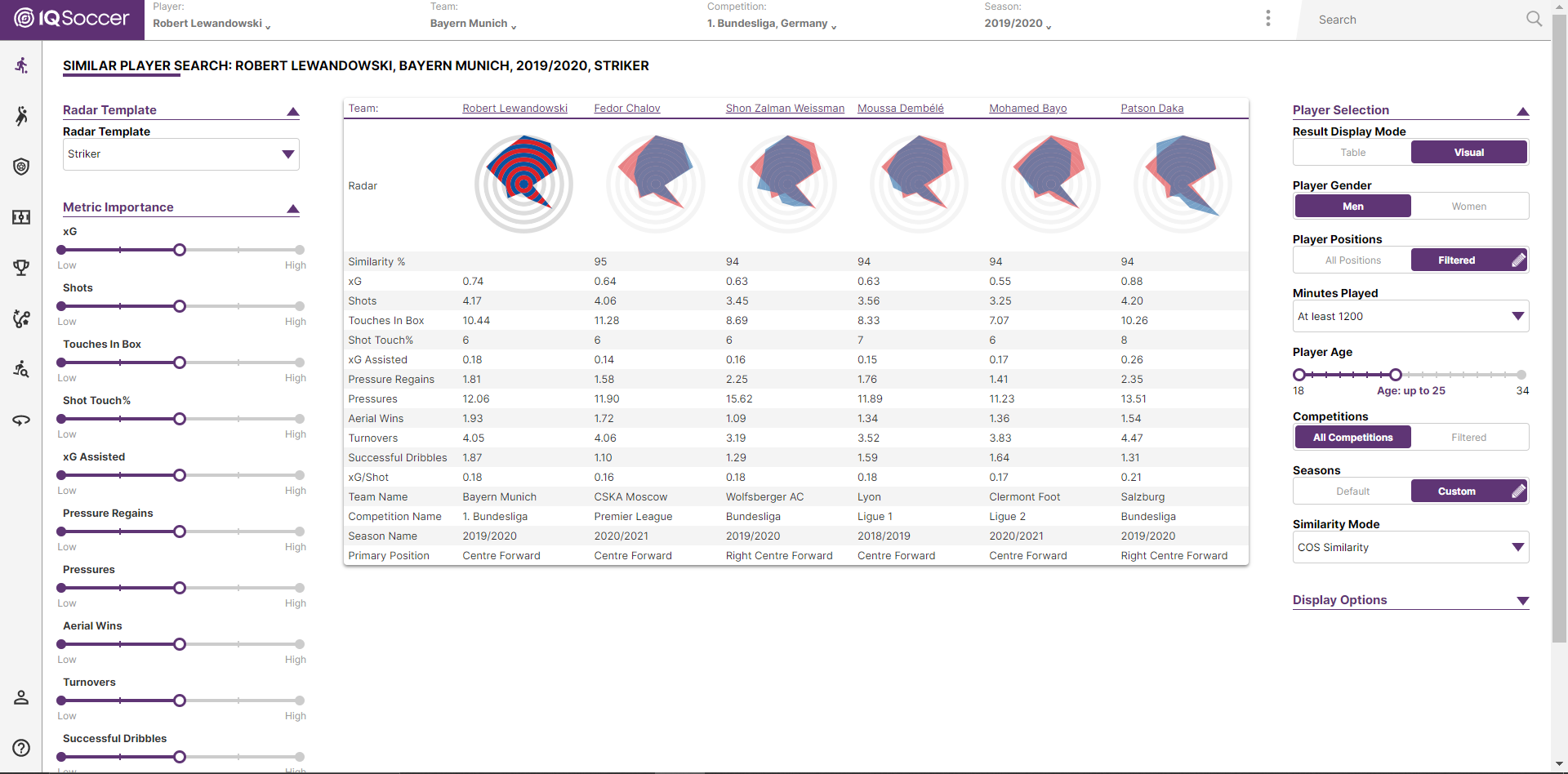
The concept is simple: a player is selected as the subject of the search and the algorithm then produces a list of players with similar statistical profiles, ranked on a scale of 0-100, with 100 being an exact match. The subject could be a well-known player, a potential transfer target or even one of a team’s own players for whom they require a backup or future replacement.
There are various filters that can then be applied to more closely tailor the results to the requirements of the end user. These include:
- Gender
- Position
- Minutes Played
- Age
- Competition: open selection or by region or tier grouping
- Season
It is also possible to adjust the importance assigned to each metric. For instance, if a team is looking for a player capable of replicating the passing and creative output of a league-leading attacking midfielder but are not as concerned about matching the defensive output of that player due to team play style or other factors, the former elements can be weighed more heavily in the similarity analysis.
The results can act as an ideal jumping-off point for a more involved scouting process, providing a list of names to investigate in further detail. StatsBomb Data covers 70 competitions and close to 50,000 players worldwide, so there is plenty of opportunity to come across some lesser known names. That is particularly valuable for teams operating on a tighter budget.
It is important to note that the simple fact of approximating the statistical output of another player doesn’t necessarily suggest similarities in ability, potential, physique or even always play style. Saying that a certain player matches the statistical output of Zlatan Ibrahimovic, for example, just means that they produce a lot of shots, win a lot of aerial duels and are good at retaining possession. It says nothing of their other technical or physical attributes.
It is most convenient to think of the subject of the search as an avatar for a certain set of statistical outputs; a shortcut to a given profile of player.
For example, give me a player whose output looks like that of Sadio Mane:
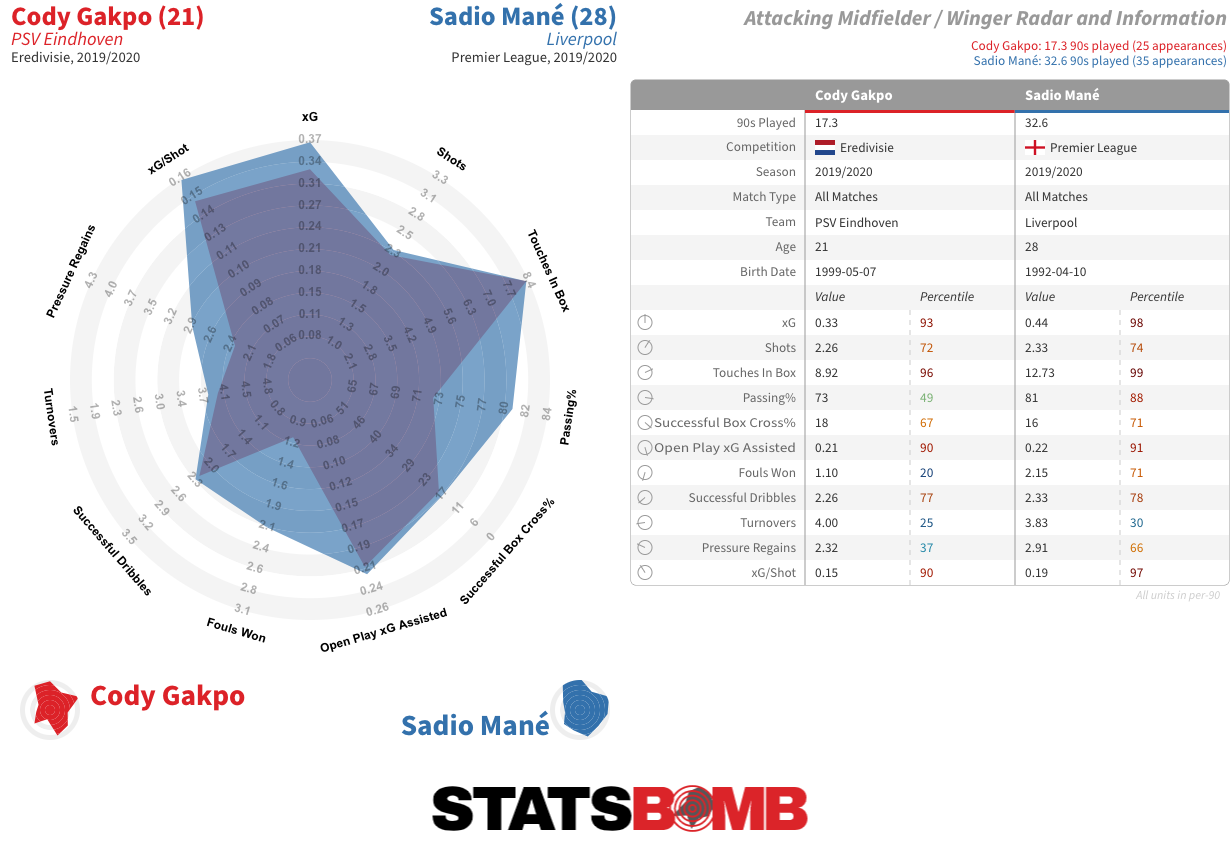
Or maybe Alejandro Gómez:
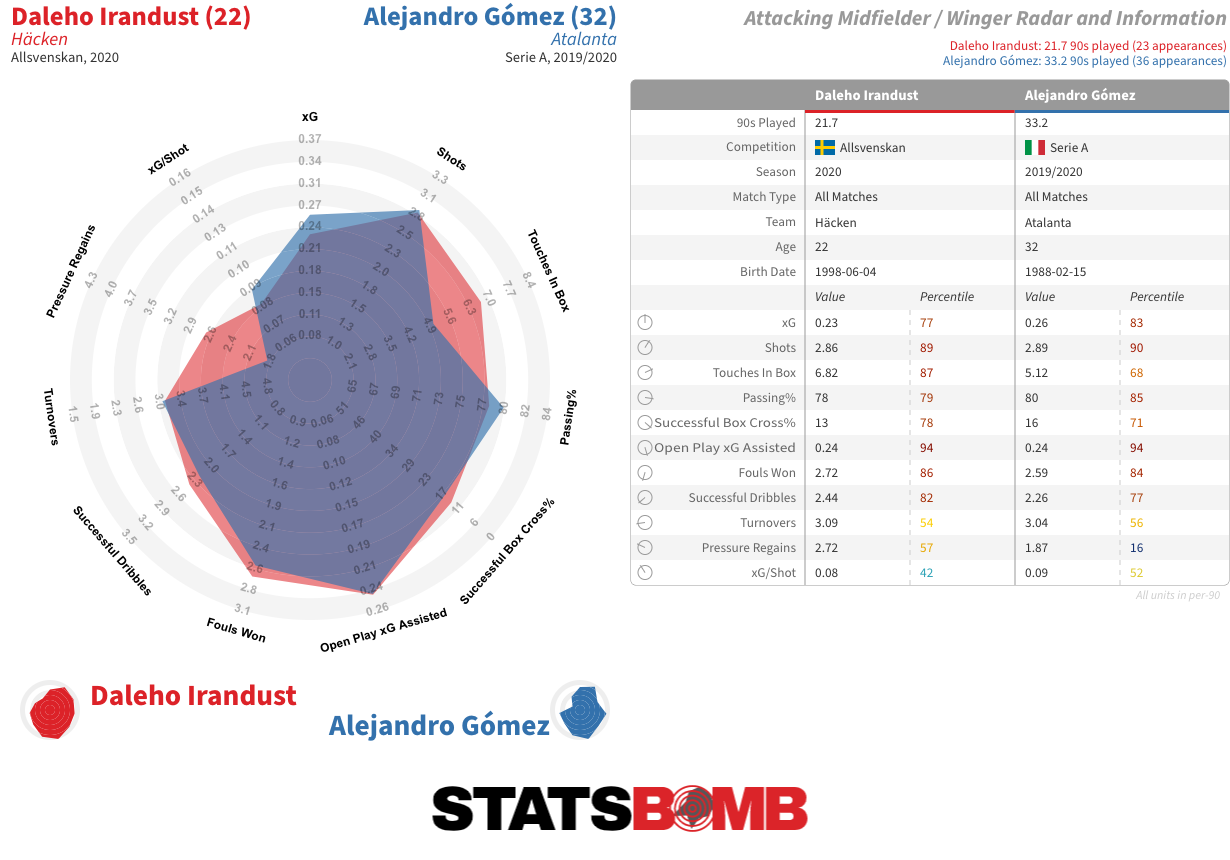
Or even Toni Kroos:

The possibilities are endless. Keep an eye on our social channels for more examples under the hashtags #doppelganger and #similarplayers.
----------------------------------------
We are currently offering an extended 14 day free trial of our analysis platform StatsBomb IQ to potential clients. For more information, please contact: Sales@StatsBomb.com.
The StatsBomb Hub is dedicated to improving understanding of football data and analytics. We have lots of educational articles on our website, but we also offer in-depth courses crafted by industry leaders with extensive experience within the game.
We initially delivered our courses in person, but we now offer the same expertly designed courses online, enabling students to learn at home and at their own pace.
The courses are packed full of practical examples and use our award-winning analytics platform, StatsBomb IQ, to visualise the concepts contained therein.
Most of us are working and learning from home now, so if you have extra time on your hands, why not give one of our courses a try?
Introduction to Analytics for Football Professionals
Our first course is Introduction to Analytics for Football Professionals, led by our Director of Football James Yorke and CEO Ted Knutson. It provides a solid foundation in football analytics at an introductory level.
A version of this course is also available in Castellano/Spanish, led by Pablo P.Rodríguez, Head of Tactical Innovation at StatsBomb: https://cursos.statsbomb.com/courses/introduccion.
What are people saying about it?
“I probably can’t overstate how much I learned from this course. Not only from the amount of detailed material covered but, perhaps more importantly, how it got me thinking more about the possible usage and ways of using analytical football data."
“A good place to start if you're new to football analytics, but also useful if you're already familiar with some of the concepts. Definitely worth the money.”
“This course increased my appetite to learn more about data analytics in football and is a great way to get started!”
What does it cover?
- Expected Goals (xG)
- Types of Attack
- Set Pieces
- Defensive Choices
- Team/Opposition Analysis
Who is it for?
The introduction course is designed to be accessible to everyone and teaches you the basics of data analytics in football. You don’t need to work in professional football or have advanced statistical knowledge. A basic understanding of football and statistics is useful.
Modern Scouting and Data-Driven Recruitment
Our latest course is Modern Scouting and Data-Driven Recruitment, led by our Director of Football James Yorke. It discusses how integrating data and traditional scouting can help a team make better recruitment decisions.
What are people saying about it?
“Every football team that is starting to use data or is not sure if they use it correctly should take the time to gather all the scouts, analysts and coaches, sit together, watch the course, discuss it and plan their approach to using data. Lots of great knowledge share, interesting stories. James is a really good teacher and it’s easy to follow his thoughts.”
“Money well spent! I'm really glad, I took on this course and had the opportunity to improve my personal insights on how data can help with scouting and player recruitment.”
What does it cover?
- Team Analysis
- Squad Building
- Player Analysis - Strikers
- Players Analysis - Centre Backs
- Scouting Integration and Bias
- Scouting Workflow
- Advanced Data Integration
- Player Evaluation
- A bonus lesson from CEO Ted Knutson
Who is it for?
The course is aimed at anybody who is interested in modern recruitment techniques. It covers all aspects of the process with a focus on data and scouting.
Both of these online courses can be found on The Hub. Look out for more in 2022.
If you work for a professional club, company or university, please contact us about the opportunity to purchase bulk course access or payment via invoice.
We complete our roundup of the first five matchdays of action in the major European leagues with a look at some early trends in Serie A. The Highest Scoring of the Big Five Leagues Anyone still clinging to that age-old stereotype of Italian football being boring and defensive needs to readjust to the current reality: Serie A is the highest scoring major league in Europe. Just a glance at last weekend’s results provides a flavour of what the league is now producing. There were two 3-3s, a 4-2, a 3-2 and a 2-2. Not a single encounter ended scoreless. In fact, there has only been one 0-0 draw in the 48 matches (actually) played so far this season. Serie A saw a stable 2.68 goals, between 2.43-2.44 non-penalty goals and 2.36-2.39 expected goals (xG) per match through the 2017-18 and 2018-19 seasons, but those figures shot up to 3.04 goals, 2.64 non-penalty goals and 2.54 xG last time around. That has increased again in the early running of the new campaign, with an average of 3.75 goals per match. That isn’t inflated by an abnormally high penalty count either, as around one penalty goal for every three matches is consistent with the recent average across the major leagues. The average of 3.44 non-penalty goals per match is also comfortably the highest mark across the big five. The early pace is eventually likely to ease off a little. That average of 3.44 non-penalty goals per match is around 116% of the xG sum of 2.96, which is marginally higher than the highest overperformance in any 48-match sample last season, although nowhere near as extreme as the 130% rate across the first five matchdays of the Premier League season. The xG sum itself is also comfortably ahead of any 48-match sample last season. But unless something dramatic occurs, Serie A will remain the prime choice for goal hungry viewers. Just maybe don’t tune in to Hellas Verona. Their matches were some of the lowest scoring in the league last season, and that has carried over into the new campaign, with their encounters featuring the lowest number of both goals (1.40) and xG (2.41). Finally a New Champion? Juventus are seeking a 10th consecutive Serie A title this season, but it is probably fair to say that their long run of successes is in more danger of coming to an end this time around than in any previous campaign. That is partly because of their own level. Last season’s total of 83 points was their lowest in any season in their title-winning streak, and they only had the fourth-best metrics in the division. It is actually necessary to go back to 2016-17 to find the last time Juve had the best underlying numbers in Serie A, despite the fact they’ve continued to accumulate titles. The gift of three points from their unplayed match against Napoli has helped them take nine from their opening five matches of the new campaign, but they’ve not looked convincing in Andrea Pirlo’s first steps as a head coach. Inter and Napoli both had marginally better underlying numbers last season and have both picked up more points with better metrics in the early running of 2020-21. Antonio Conte and Inter finished just a point behind Juventus last season and look particularly well-placed to challenge strongly. In fact, most bookmakers now have them as the favourites for the title. But there is also another potential challenger in the form of early leaders AC Milan, who have carried their excellent form from the back end of last season into the new campaign. No team picked up as many points as the Rossoneri between the resumption of action in June and the end of the season, and only Inter had better metrics.  Milan’s recent focus on the signing of the young players seems to be bearing fruit, although it is notable that Zlatan Ibrahimović has been their primary goalscorer since his return in January. We’re not sure if it says more about Ibrahimović or the openness of the league that he’s still putting up numbers like this at the tail end of his 30s.
Milan’s recent focus on the signing of the young players seems to be bearing fruit, although it is notable that Zlatan Ibrahimović has been their primary goalscorer since his return in January. We’re not sure if it says more about Ibrahimović or the openness of the league that he’s still putting up numbers like this at the tail end of his 30s.  We haven’t even mentioned Atalanta yet, arguably the most entertaining team in Europe, and certainly the one with the best metrics in Serie A last season. They’ve made a slightly less impressive start to the new campaign, although their matches remain the most open in the league, with 4-2, 4-1 and 5-2 victories followed by 4-1 and 3-1 defeats.
We haven’t even mentioned Atalanta yet, arguably the most entertaining team in Europe, and certainly the one with the best metrics in Serie A last season. They’ve made a slightly less impressive start to the new campaign, although their matches remain the most open in the league, with 4-2, 4-1 and 5-2 victories followed by 4-1 and 3-1 defeats.
Borussia Dortmund are in a tough spot. The German powerhouse have established themselves among the best teams in Europe and even more so in the Bundesliga where there is a considerable gap between Dortmund, Bayern Munich, RB Leipzig and the rest of the pack. Dortmund are expected to command the action on the pitch, and they themselves like to be in command.
Lucien Favre is certainly one of those managers that believe in possession and flawless passing as a way to dominate and drain the energy out of opponents. While flawless passing with infrequent shooting can seem dull to some, it is a technique to move opponents around and wait until there is the opening needed to advance quickly down the field. After all, Dortmund are at their strongest when the attacking cohort around Erling Haaland is moving at a rapid pace in open space.
The result from this is that Dortmund’s build-up play might be the most pivotal part of their game. BVB have, on average, 111 possessions per 90 minutes. However, as opposed to many other teams, a single possession usually consists of several build-up attempts, in particular because of Favre demanding from players to abandon an attacking play and start all over again from the back rather than desperately trying to force a shot with little to no chance of success.
“Of course my wish is that we can play through our entire team, starting from the goalkeeper, finding intelligent ways to get to the goal.” (Lucien Favre)
What are the key components of Dortmund’s build-up?
After tinkering with tactical line-ups involving a back four during pre-season, Favre decided to stick to the back three he successfully used for major parts of last season. He made slight adjustments to the structure in front of the back line, most notably the implementation of a mobile no. 10 in Gio Reyna, though the young American has also been used as a no. 10-winger hybrid when Favre went back to last season’s 3-4-2-1 in Dortmund’s recent encounter with Hoffenheim. That being said, the build-up structure has not changed. The only significant personnel change, as Thomas Meunier has replaced Achraf Hakimi, has had an impact on the forcefulness of Dortmund’s attack but less so on the early stages of the build-up.
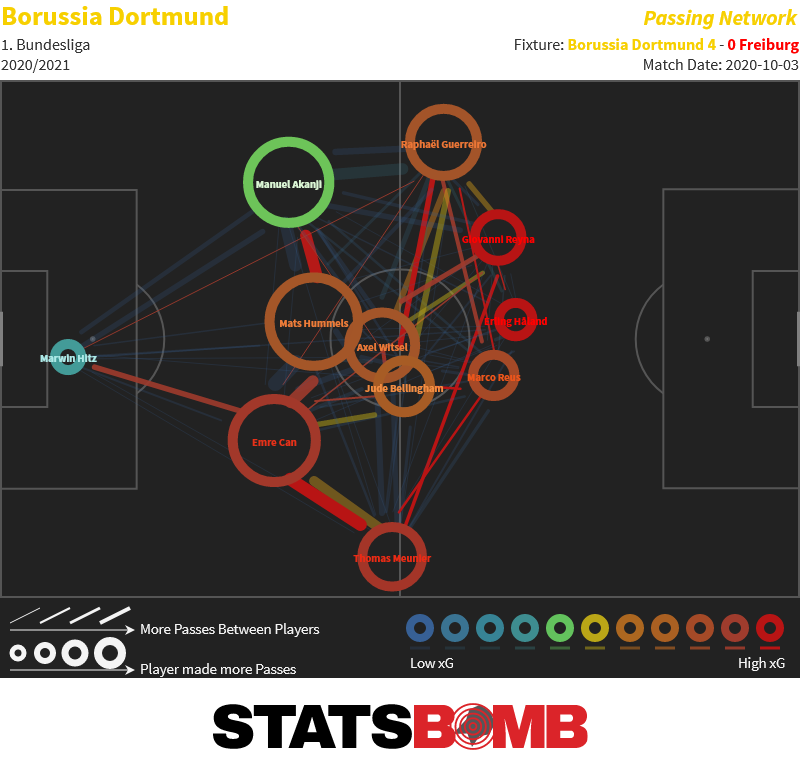
That build-up is usually done with a certain degree of urgency, particularly when Dortmund’s three defenders are pressured by a clear-cut man-marking scheme as seen in BVB’s match against SC Freiburg. The three defenders then attempt to move the ball laterally as quickly as possible, hoping that the opposing pressing line cannot keep up and offer openings that will allow Dortmund to bring the ball into the central midfield – which is the central component of the entire build-up. Dortmund always attempt to move the ball downfield through the middle of the field. While it might seem at times that Dortmund’s formation is stretched and the plays go to the outside, the main objective of the early build-up is to make use of Axel Witsel, Jude Bellingham and Gio Reyna, meaning to give them touches behind the first and occasionally second pressing line.
The rapid speed at which the three central defenders try to move the ball laterally leads quite naturally to passes towards the touchline, as it would, otherwise, be impossible to keep the ball going within the limited amount of space the back three occupies. This results in the two wing-backs being involved in the early phase of the build-up. Unfortunately, Meunier has not fully adapted to that aspect of the build-up, as he likes to advance quite quickly, but then finds himself in no-man's-land up the field, as the right-sided centre-back is desperately trying to play the ball to the outside. Meunier then has to rush back and receive the pass, though in a position that lets him face Dortmund’s goal and more or less forces him to play the ball backwards immediately. The left wing-back usually sits deeper and thus is positioned with a better body posture that allows him to play into the midfield centre after receiving a pass from the back three.
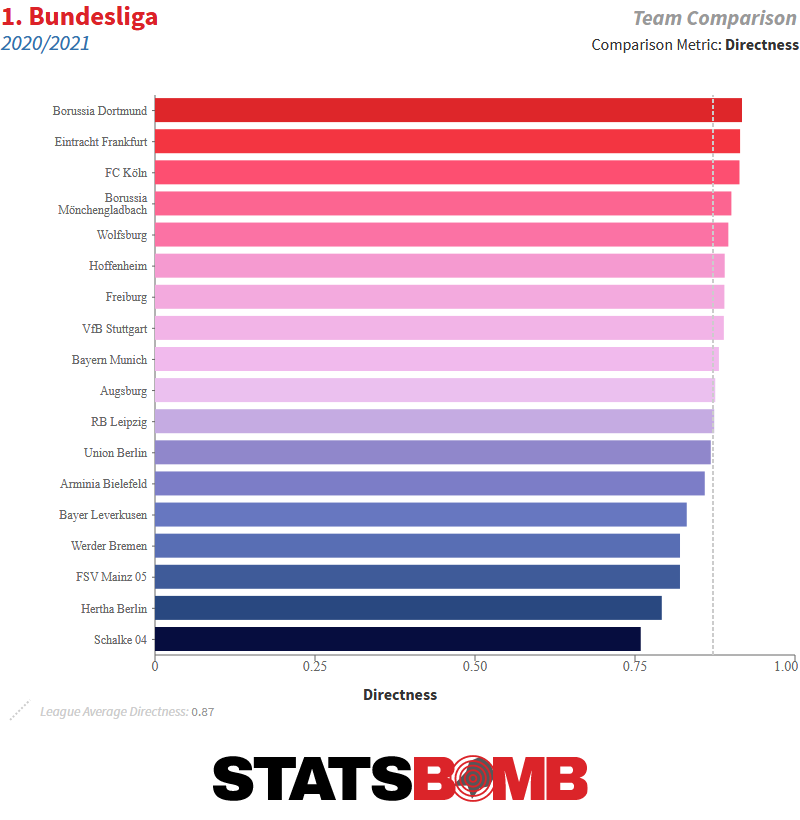
Dortmund’s attacks are currently the most direct in the Bundesliga. They finished second in this category last season. (‘Directness’ is a ratio of the distance towards goal from the start of a possession that ended in a shot, divided by the total distance travelled in build-up to the shot.)
This brings us to another key component of Dortmund’s build-up – diagonality, is created differently by the individual build-up players. First, there is Emre Can as the right-sided centre-back who likes to advance through the half-space, often moving slightly diagonally to break through flat pressing lines which don’t have the angle to close the gaps quickly enough. Statistically, Can is among the top 5 Bundesliga players in ‘progressive carrying distance’. Second, there is Manuel Akanji who plays as a right-footer on the left side and naturally tends to play diagonal passes into the midfield.
Third, there is Raphael Guerreiro who, as the left wing-back, often sits deeper to get a clear look at the field before playing the ball with his left foot either down the line or into the middle. Fourth, there is Felix Passlack who can quite effortlessly adapt his game and play as a left wing-back despite the right foot being his stronger one. Passlack knows that he has to turn his body towards the centre before receiving a pass from one of the central defenders in order to use his right foot and directly play a slightly curved pass into the middle.
While Passlack has done well in becoming a valuable part of Dortmund’s build-up, Guerreiro rightfully remains a linchpin of this phase in the game. Because of his proximity to the touchline, mixed with his deep position, he can play the inside pass at a sharp angle to Bellingham or Witsel who then follow up with a direct pass at a similar angle back to the wing. That pass is often ensued by a pass towards Haaland who is able to use the way Dortmund gain room through this sort of triangle on the left side to create separation from his defenders and make a run behind the last line.
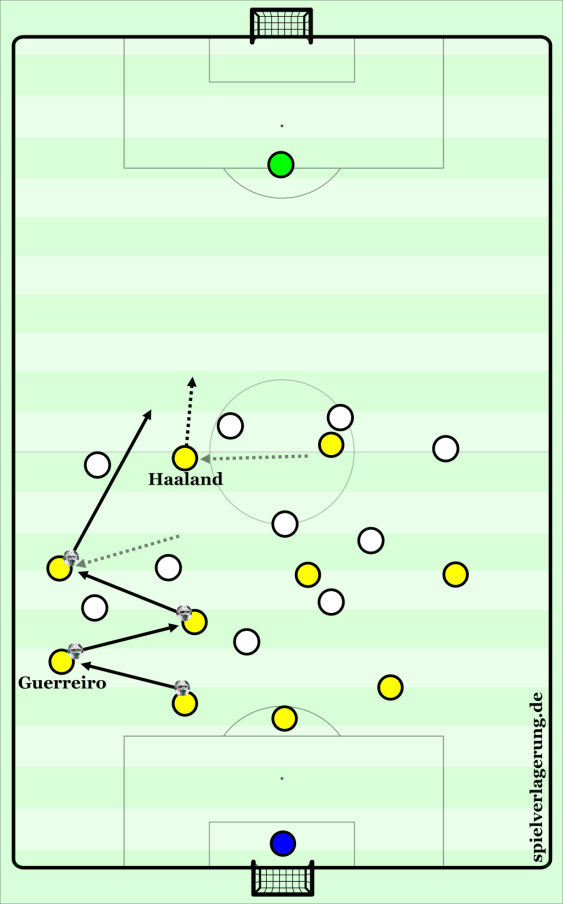
That is, in a simplified way, how a passing chain involving Guerreiro occasionally looks.
Contributing factors
Many opponents think they have to meet Dortmund’s build-up with a high press coupled with a man-marking scheme that at least assigns markers to Mats Hummels and Emre Can. If these markers confront Dortmund’s defenders intensely, forcing them to quickly decide whether lateral ball movements are safe enough, BVB often switch to direct vertical passing. Even if a pressing player stands directly in front of Can, the Dortmund player can still find a way to pass the ball around the opponent at a slight angle, moving it vertically down the field. In that regard, Gio Reyna plays a crucial role, as he is usually the attacking player that makes the most lateral runs 20 or so yards down the field and can establish a position in a vertical channel linked to the right-sided or left-sided centre-back. Reyna’s mobility and relentless style of constant movement are key to breaking high presses.
What Reyna is to Can is Bellingham to Hummels, as the young Brit also likes to create separation from his marker and position himself in the channel in front of one of the centre-backs. His teammates already trust Bellingham to such a degree that they even target him as a receiver when he is in a crowded spot in the middle third. In recent years, Dortmund were lacking the kind of box-to-box midfielder that can thrive next to Witsel. At the age of 17, Bellingham has clearly shown an aptitude for progressive passing during the short time at the club and already appears to be a self-assured ball carrier that may not crack under the unique pressure most Bundesliga teams put on centre-midfielders.
Bellingham often uses the left half-space to call for a vertical pass, as he usually is higher up the pitch than Witsel. With Reyna tending to drop back through the right half-space, the two 17-year-olds effectively form a temporary no. 8 pairing in Dortmund’s build-up, creating a triangle with Witsel who has devoted himself to covering the backs of these two youngsters. That midfield triangle is usually narrower than the back three which, again, creates diagonality when a forward pass is played.
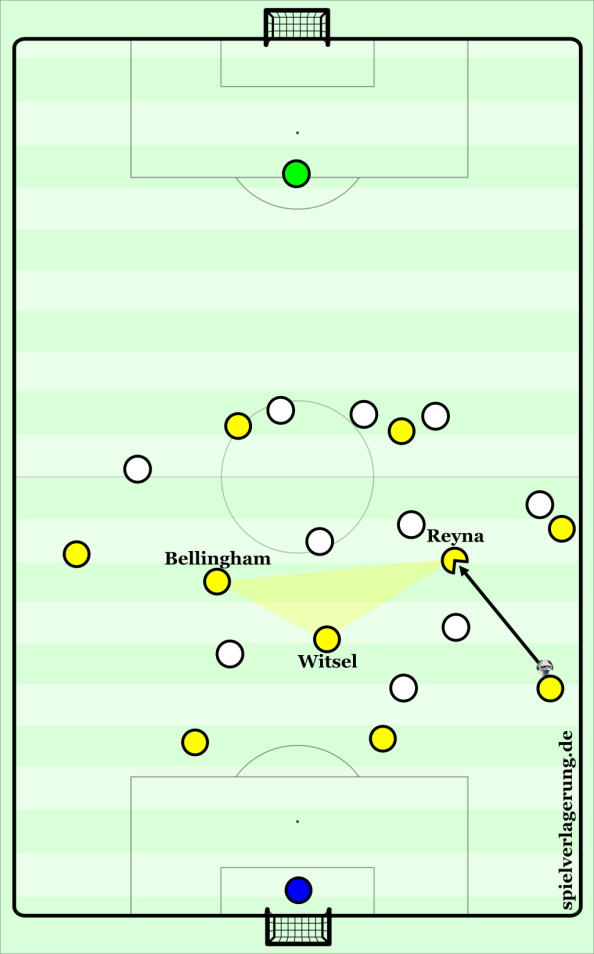
Witsel, Bellingham and Reyna form a midfield triangle. When one of the outside centre-backs, particularly Can who plays on his ‘natural’ side, is close to the touchline, it is paramount that the nearby midfielder moves out of coverage shadows and frees himself from markers to be quickly available as a receiver.
Another element that might not be a central component of the build-up, but makes Dortmund more unpredictable are Mats Hummels’s short dribbles where makes a few explosive steps from his initial position and gets past an opponent. Hummels quite regularly makes these short dribbles after receiving the ball from the left side to his right foot, immediately pushing the ball with the outside of the boot towards the centre and then following up with a few more touches in an attempt to win some spaces and provoke the opposing team to react. Hummels’s short dribbles can, at best, create a domino effect and free at least one midfielder from his marker.
The descriptions above have been made – and possibly read – under the assumption that Dortmund intend to keep passes short and the ball on the ground. It is certainly true that Favre likes ‘small ball’ much more than a style with long passes which are less controllable and usually create a considerable amount of chaos. That said, Dortmund are quite adept in sparingly employing long balls. These are most effective after Dortmund have advanced and decided to play the ball back to the defenders who immediately go for a long diagonal ball to a player on the far side or an attacker making a run behind the offside line. In that scenario, Dortmund smartly exploit the momentum of the opposing defence.
Pitfalls
There are certainly a few pitfalls that could endanger Dortmund’s success in the early phase of their build-up. Recent performances against Augsburg and Lazio have made that crystal clear.
Emre Can and his half-space runs are rightfully praised as a tool to break pressing lines, as such runs are commonly effective against most defences. However, Can tends to be a bit reckless with his forward movement, likely channelling his inner midfielder who wouldn’t face severe consequence in case of a turnover. Playing at the back means that he has to decrease the risks he takes when he attempts to disturb pressing structures. The fact that he makes so many progressive runs successfully can be seen as a positive, but knowing Favre and how calculated—or some could say risk-averse—he is, it is hard to believe that the Swiss doesn’t raise an eyebrow when Can decides it is time to take on two or three defenders.
The reason Can’s progressive runs usually work is that he can exploit vast chunks of space between opposing pressing lines. Most opponents believe they have to attack Dortmund early and intensely, not giving them any time in the first phase of the build-up. They fear that a competent passer like Hummels could catch them with his accurate vertical balls or hit a perfect pass over the top of the back line as he has done so many times in the past. But those teams that sit back a bit are usually more successful against BVB.
Hoffenheim, for instance, did not apply a high press in their recent match against Dortmund and instead created density in the middle third. Similarly, Lazio did not constantly use a high press, as they invited BVB to move a bit and then brought Dortmund to a halt, as the Italians intended to force backwards passes and passes to deep-sitting wing-backs. These passes by Dortmund were used as triggers by Lazio who quickly advanced and closed down passing options close to Dortmund’s ball carrier.
Dortmund’s build-up players usually take the bait and move a couple of yards forward, making the pitch more narrow and thus destroying space that could otherwise be used for medium-range passes to Bellingham, Witsel or Reyna. Once Hummels and his teammates are at the halfway line, any kind of vertical pass to one of the midfielders is usually short and somewhat slow, because a forceful pass would only increase the risk of an unclean touch by the receiver. But the shortness of the pass and the density don’t allow the receiver to make a quick and safe 180-degree turn towards the penalty area.
Another factor that could harm Dortmund’s build-up are injuries. Favre has been forced to change the line-up of his back three quite frequently in recent weeks. Thomas Delaney being slotted into the role of the left-sided centre-back against Hoffenheim and Lazio was nothing more than an emergency decision by the Swiss coach, although Delaney did quite well in this unfamiliar role. Still, an established line-up with Hummels, Can and possibly a fully fit Dan-Axel Zagadou would help Favre to hone the positional play and improve the accuracy and effectiveness of passing chains.
While there is certainly enough room for improvement, as shown by Dortmund’s disappointing performance against the pressing experts of FC Augsburg and the astute defenders of Lazio, BVB’s build-up provides a decent base for the attacks by the Black and Yellows. After all, there is no doubt that Jadon Sancho, Marco Reus and Erling Haaland are one of the most talented attacking trios in Europe. That Dortmund get the ball to them is what matters.
This post is also available in German here
We are five matchdays into the new Bundesliga season, so let’s have a look at a couple of interesting things from the early action. Predictable Leaders The Bundesliga has taken a lot less time to shake out than many of the other major European leagues, with the top three spots in the table currently filled by the top three teams from last season: Bayern Munich, Borussia Dortmund and RB Leipzig. Not only that, but the three of them also have the best underlying numbers in the division. Aside from a surprise 4-1 defeat away to Hoffenheim, champions Bayern are humming along just fine, scoring four or more goals in each of their four victories. Dortmund also have a loss on the board, but have won all of their remaining matches to nil. RB Leipzig lead the way early on with four wins and a draw from a kinder opening schedule. Even at this extremely early stage of the campaign, it would take a brave person to back another team to finish in the top three, and perhaps an even braver one to back anyone but Bayern for the title. Hans Flick’s side finished 13 points clear of second last season after winning nine on the bounce following the return to play to May, and then successfully made their way through the final four rounds of the Champions League to become champions of Europe. Aside from that Hoffenheim anomaly (4-1 on the scoreboard; 3.98-1.64 by expected goals), they’ve been dominant so far, outshooting their remaining opponents 79-33, and accumulating 13.44 xG while conceding just 3.48. We are only five matches in and the usual caveats about small sample sizes obviously still apply, but it is difficult to see Bayern relinquishing their mightily firm grip on the Bundesliga title. Robert Lewandowski has also made a great start in his attempt to finish the season as the league’s top scorer for a fourth consecutive campaign. 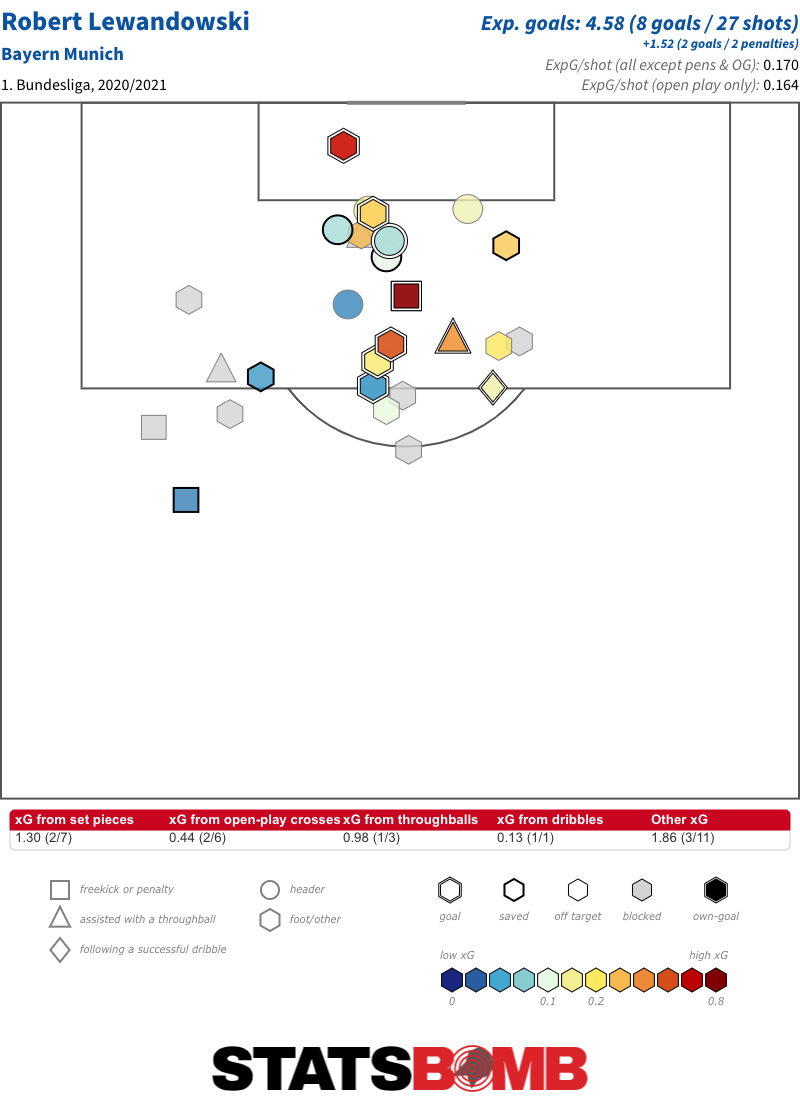 How bad are Schalke? Schalke are second from bottom after picking up just a single point from their opening five fixtures. More globally, they are now winless in their last 21 Bundesliga matches -- the joint second worst run in the history of the league. Their one and only league win this calendar year came way back on 17th January in a 2-0 triumph at home to Borussia Mönchengladbach. Are they really that bad? In a certain sense, the answer is yes. With penalties included, they’ve given up an average of over two goals per match to their opponents during this run. Extrapolated to a full campaign that would have resulted in comfortably the worst goal difference in the Bundesliga last season. With penalties removed, the average drops to 1.86, which is some way ahead of their average xG deficit of 0.98 per match, but that latter figure would still again have comfortably been the worst in the league last season. So we can pretty confidently state that as currently constituted, Schalke are a bad team. Even so, the likelihood of them putting together a run of 21 matches without victory is still very low. The race charts in StatsBomb IQ display the probability of a match ending in a home win, an away win or a draw based on the balance of chances. We can use these probabilities from each of the 21 matches in their winless streak to establish the cumulative probability of them failing to secure a single victory in that time. It’s worth noting that they are some dreadful performances in here, including four matches in which Schalke’s opponents had a 90% or better chance of winning given the balance of chances. Only once did Schalke’s win probability stand at over 50%. There was an 80% or better chance of them failing to win in 14 of the 21 matches. But if you stack them all, even a team playing as badly as they have done during this run would usually have sneaked a victory or two along the way. The probability of them failing to win all 21 of the matches stands at just under 1.5%. So while performances this calendar year and since the start of this season certainly have Schalke pegged as likely relegation candidates, it wouldn’t be at all surprising if they were to bring their winless run to an end before they reach the Bundesliga record of 31 matches without victory, set by Tasmania Berlin way back in the mid-sixties.
How bad are Schalke? Schalke are second from bottom after picking up just a single point from their opening five fixtures. More globally, they are now winless in their last 21 Bundesliga matches -- the joint second worst run in the history of the league. Their one and only league win this calendar year came way back on 17th January in a 2-0 triumph at home to Borussia Mönchengladbach. Are they really that bad? In a certain sense, the answer is yes. With penalties included, they’ve given up an average of over two goals per match to their opponents during this run. Extrapolated to a full campaign that would have resulted in comfortably the worst goal difference in the Bundesliga last season. With penalties removed, the average drops to 1.86, which is some way ahead of their average xG deficit of 0.98 per match, but that latter figure would still again have comfortably been the worst in the league last season. So we can pretty confidently state that as currently constituted, Schalke are a bad team. Even so, the likelihood of them putting together a run of 21 matches without victory is still very low. The race charts in StatsBomb IQ display the probability of a match ending in a home win, an away win or a draw based on the balance of chances. We can use these probabilities from each of the 21 matches in their winless streak to establish the cumulative probability of them failing to secure a single victory in that time. It’s worth noting that they are some dreadful performances in here, including four matches in which Schalke’s opponents had a 90% or better chance of winning given the balance of chances. Only once did Schalke’s win probability stand at over 50%. There was an 80% or better chance of them failing to win in 14 of the 21 matches. But if you stack them all, even a team playing as badly as they have done during this run would usually have sneaked a victory or two along the way. The probability of them failing to win all 21 of the matches stands at just under 1.5%. So while performances this calendar year and since the start of this season certainly have Schalke pegged as likely relegation candidates, it wouldn’t be at all surprising if they were to bring their winless run to an end before they reach the Bundesliga record of 31 matches without victory, set by Tasmania Berlin way back in the mid-sixties.
Football returns to Argentina this week following a seven-month absence due to the COVID-19 pandemic. Vicente Muglia, Olé journalist and author of the book Che Pep, joins us to preview the Copa de la Liga Profesional 2020, which opens with Gimnasia La Plata against Patronato on Friday. Nick Dorrington, Content Manager at StatsBomb (ND): Hi Vicente. Thanks for giving up your time to speak to us. We are going to kick off with the top two from last season (the Superliga 2019-20), River Plate and the champions Boca Juniors, two teams with differing approaches. Could you summarise the key points of their respective play styles? Vicente Muglia (VM): Throughout Marcelo Gallardo’s tenure, River have stood out as a team who take the initiative in two ways: through possession and with a high press. When they have the ball, they are a dangerous team because they are quite direct, they don’t chain together a lot of passes but instead seek to move forward, take advantage of space or create it, all by means of an unwavering tactical intensity. Without the ball, they have a well-oiled pressing system which is consistently effective in winning it back. The forwards are the team’s first defenders. When they win the ball back in opposition territory, they attack decisively to take full advantage of the transitional phase. ND: It is something that is clearly visible in the data. Last season, River utilised an aggressive high press, with only Argentinos Juniors contesting the ball more intensely in opposition territory.  River were also the team who generated the most shots after winning the ball back high up the pitch.
River were also the team who generated the most shots after winning the ball back high up the pitch. 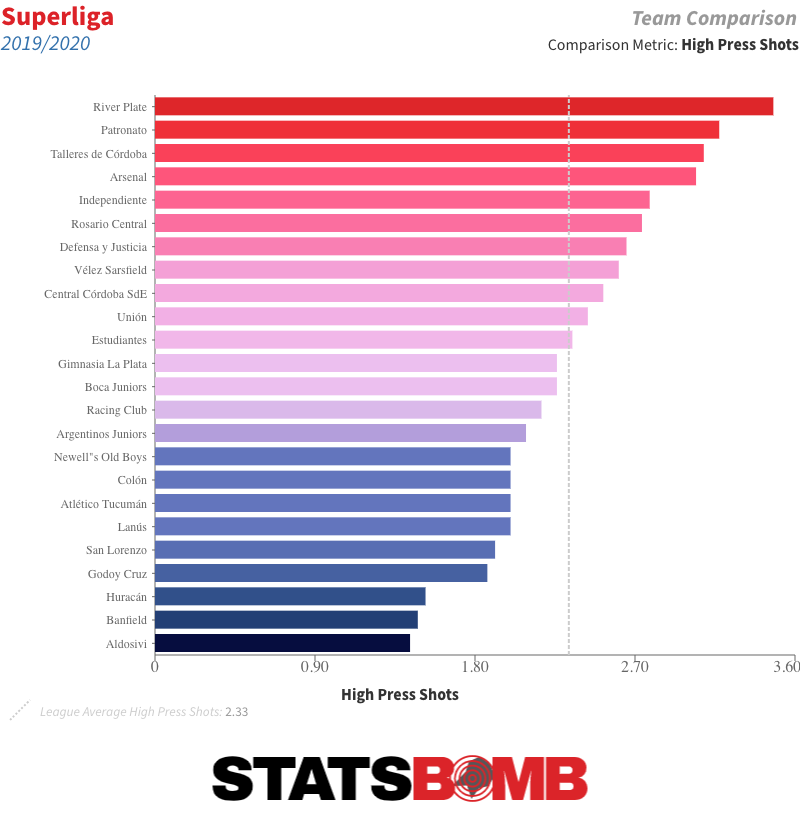 Both visualisations make it clear that Boca, coached by the experienced Miguel Ángel Russo, have a very different play style. VM: Yes. In contrast to River, Boca don’t usually press high but instead focus on winning the ball back in the centre of the pitch and then attacking quickly from there. They are a direct team, who don’t elaborate as much as River. The key to last season’s championship was the damage they did down the flanks. Julio Buffarini and Eduardo Salvio on the right and Frank Fabra and Sebastián Villa on the left spread the pitch, got in behind and destabilised opposing defences. Boca also had the very steady Jorman Campuzano in midfield, and Carlos Tévez up front, who was intelligent in finding space and rationing his efforts. ND: In addition to being the team’s top scorer, Tévez played a very important role in ball progression. He dropped back to receive and combine with teammates, and on a per-90 basis, only Emanuel Reynoso, now of Minnesota United in MLS, moved the ball into the final third more often and played more open play passes into the penalty area than Tévez.
Both visualisations make it clear that Boca, coached by the experienced Miguel Ángel Russo, have a very different play style. VM: Yes. In contrast to River, Boca don’t usually press high but instead focus on winning the ball back in the centre of the pitch and then attacking quickly from there. They are a direct team, who don’t elaborate as much as River. The key to last season’s championship was the damage they did down the flanks. Julio Buffarini and Eduardo Salvio on the right and Frank Fabra and Sebastián Villa on the left spread the pitch, got in behind and destabilised opposing defences. Boca also had the very steady Jorman Campuzano in midfield, and Carlos Tévez up front, who was intelligent in finding space and rationing his efforts. ND: In addition to being the team’s top scorer, Tévez played a very important role in ball progression. He dropped back to receive and combine with teammates, and on a per-90 basis, only Emanuel Reynoso, now of Minnesota United in MLS, moved the ball into the final third more often and played more open play passes into the penalty area than Tévez. 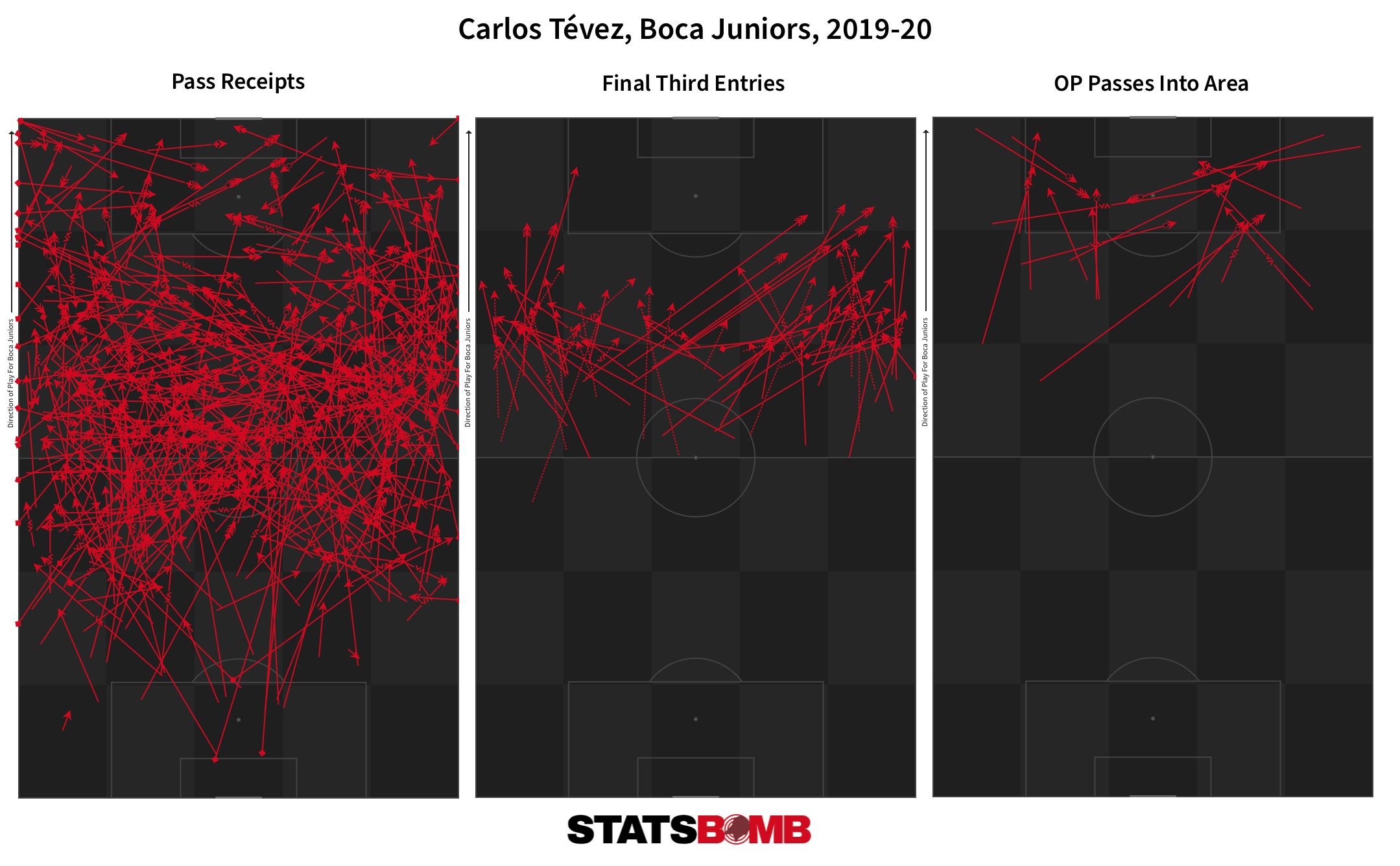 How are Boca and River looking ahead of this tournament? The format is a bit convoluted and so luck is likely to play a larger role than it would in a traditional league format, but are they still the two favourites to win it? VM: Even though River have lost Lucas Martínez Quarta and Juan Fernando Quintero, and Boca are unable to count on Villa due to off-pitch issues, they are still the two strongest teams in Argentinian football both in terms of collective performances and individual quality. They have the two best squads. Without a doubt, they remain the main candidates to lift the trophy. Prior to the start of the tournament, I don’t see another team equipped to compete with them for the trophy in normal conditions. ND: It’s worth mentioning that River had the best expected goal (xG) difference last season, and by some distance.
How are Boca and River looking ahead of this tournament? The format is a bit convoluted and so luck is likely to play a larger role than it would in a traditional league format, but are they still the two favourites to win it? VM: Even though River have lost Lucas Martínez Quarta and Juan Fernando Quintero, and Boca are unable to count on Villa due to off-pitch issues, they are still the two strongest teams in Argentinian football both in terms of collective performances and individual quality. They have the two best squads. Without a doubt, they remain the main candidates to lift the trophy. Prior to the start of the tournament, I don’t see another team equipped to compete with them for the trophy in normal conditions. ND: It’s worth mentioning that River had the best expected goal (xG) difference last season, and by some distance. 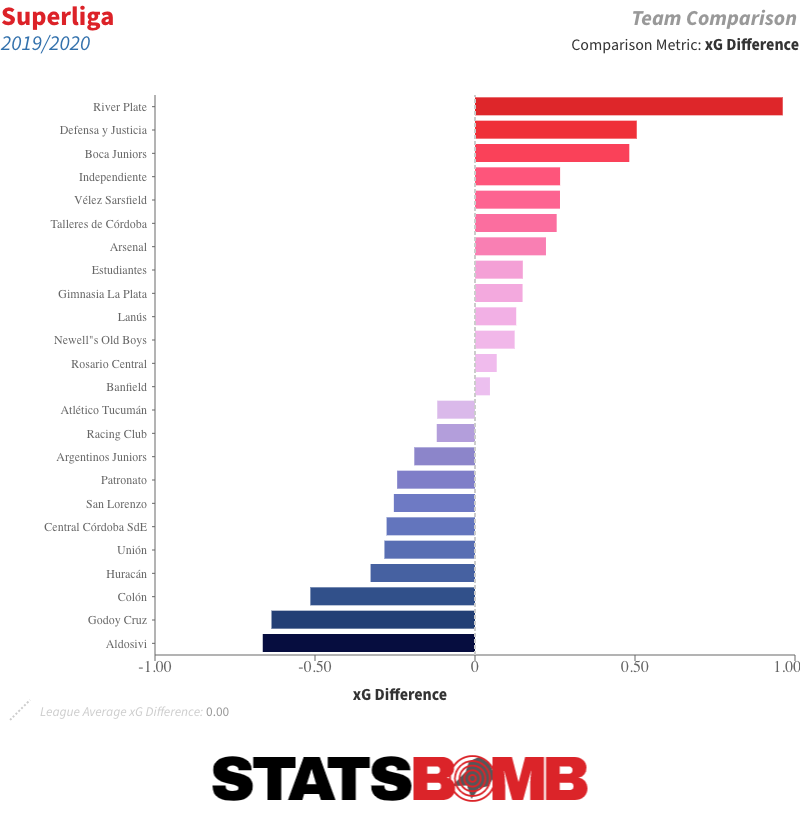 Boca performed well above expectation in defence, letting in just eight goals. Our data suggests the excellent performances of their goalkeeper Esteban Andrada were a contributory factor, but it doesn’t explain all of the difference. It is unlikely they will again concede so few goals.
Boca performed well above expectation in defence, letting in just eight goals. Our data suggests the excellent performances of their goalkeeper Esteban Andrada were a contributory factor, but it doesn’t explain all of the difference. It is unlikely they will again concede so few goals. 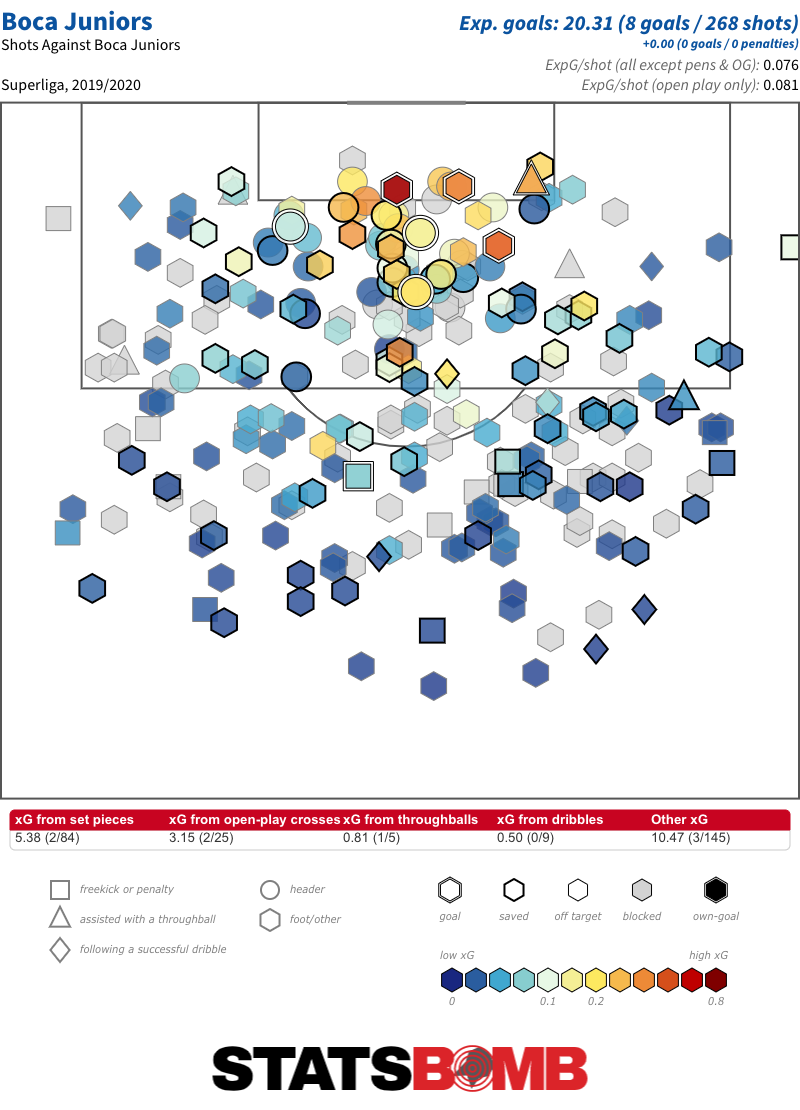 Are there some other teams with interesting play styles? VM: Racing and Defensa y Justicia have a pair of young coaches in Sebastián Beccacece and Hernán Crespo who, despite having different play styles, both seek to take the initiative and attack. They are teams who construct play from the back, move forward and are aggressive in attack. They don’t speculate. Although the feeling is that both of them need to find a bit more consistency, not only in terms of results but also in terms of their play. NM: The underlying numbers suggest that Crespo has better base to work from than Beccacece, but we will see how things play out. Another team who intrigue me are Argentinos Juniors. As we’ve already noted, they utilised a very aggressive high press last season, but they didn’t combine it with a high share of possession. They were a much more direct team than River or Vélez Sarsfield, for example. They finished fifth, but they scored less than a goal per match and struggled to create good quality chances.
Are there some other teams with interesting play styles? VM: Racing and Defensa y Justicia have a pair of young coaches in Sebastián Beccacece and Hernán Crespo who, despite having different play styles, both seek to take the initiative and attack. They are teams who construct play from the back, move forward and are aggressive in attack. They don’t speculate. Although the feeling is that both of them need to find a bit more consistency, not only in terms of results but also in terms of their play. NM: The underlying numbers suggest that Crespo has better base to work from than Beccacece, but we will see how things play out. Another team who intrigue me are Argentinos Juniors. As we’ve already noted, they utilised a very aggressive high press last season, but they didn’t combine it with a high share of possession. They were a much more direct team than River or Vélez Sarsfield, for example. They finished fifth, but they scored less than a goal per match and struggled to create good quality chances. 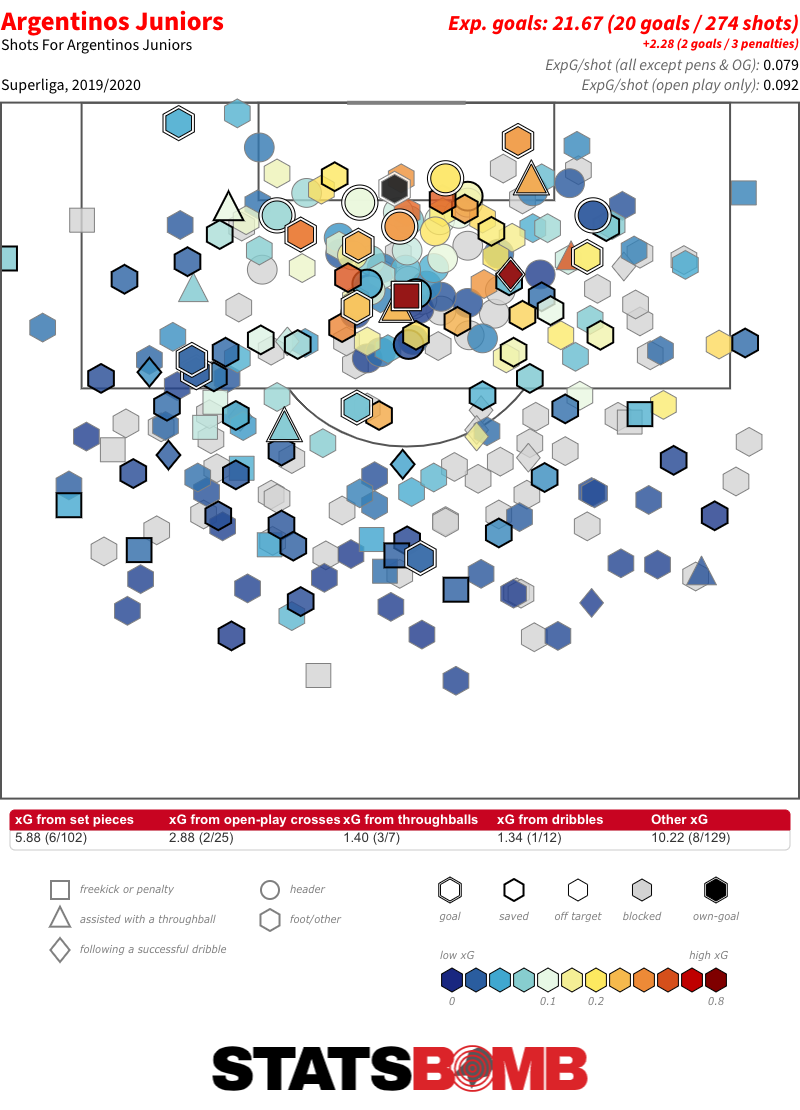 It will be interesting to see if Diego Dabove is capable of developing that aspect of their game. Have there been any interesting coaching changes? VM: Mauricio Pellegrino has replaced Gabriel Heinze at Vélez. It will be a big challenge for the club to maintain the level of competitiveness they had under Heinze, who elevated both the individual and collective level with an approach based around positional play. Pellegrino, returning to the country after a number of years in Europe, is more focused on maintaining balance. He takes less risks. We’ll have to see how the squad adapt to his style. ND: It’s a significant shift. If we take another look at the PPDA by Zone graphic above, we can see that Heinze’s Vélez pressed aggressively across pretty much the entire pitch. It looks very similar to what we see from Marcelo Bielsa’s teams. In contrast, Pellegrino was a much more reactive coach during his time in Spain, although admittedly with smaller teams. VM: There is also Mariano Soso, a young coach with some interesting ideas based around a distinctly attacking approach, who has taken charge at San Lorenzo. There, too, it remains to be seen whether he can convince his players to carry out his game model. ND: Which team made the best moves in the transfer market? VM: Due to the pandemic, there haven’t been many big moves in this window. I think Estudiantes de La Plata made the best signings. They’ve strengthened with Nicolás Pasquini from Lanús, Leonardo Godoy from Talleres de Córdoba and Leandro Díaz from Atlético Tucumán, three footballers who were starters at their respective clubs last season.
It will be interesting to see if Diego Dabove is capable of developing that aspect of their game. Have there been any interesting coaching changes? VM: Mauricio Pellegrino has replaced Gabriel Heinze at Vélez. It will be a big challenge for the club to maintain the level of competitiveness they had under Heinze, who elevated both the individual and collective level with an approach based around positional play. Pellegrino, returning to the country after a number of years in Europe, is more focused on maintaining balance. He takes less risks. We’ll have to see how the squad adapt to his style. ND: It’s a significant shift. If we take another look at the PPDA by Zone graphic above, we can see that Heinze’s Vélez pressed aggressively across pretty much the entire pitch. It looks very similar to what we see from Marcelo Bielsa’s teams. In contrast, Pellegrino was a much more reactive coach during his time in Spain, although admittedly with smaller teams. VM: There is also Mariano Soso, a young coach with some interesting ideas based around a distinctly attacking approach, who has taken charge at San Lorenzo. There, too, it remains to be seen whether he can convince his players to carry out his game model. ND: Which team made the best moves in the transfer market? VM: Due to the pandemic, there haven’t been many big moves in this window. I think Estudiantes de La Plata made the best signings. They’ve strengthened with Nicolás Pasquini from Lanús, Leonardo Godoy from Talleres de Córdoba and Leandro Díaz from Atlético Tucumán, three footballers who were starters at their respective clubs last season. 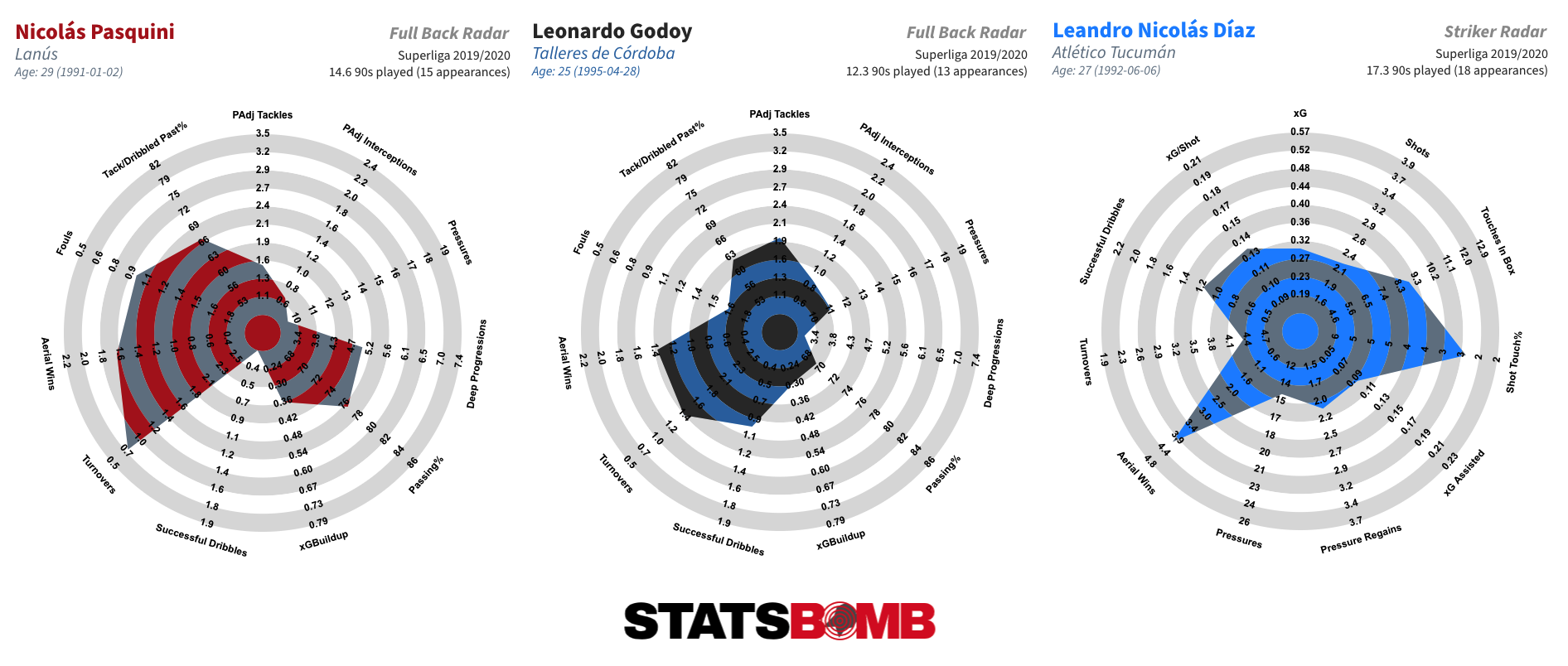 ND: Is there a particular signing you’re interested to see at their new club? VM: Maybe Edwin Cardona at Boca, to see how he fits into the team given that his characteristics, more suited to combination play, seem, in theory, pretty incompatible with Russo’s style of play. At San Lorenzo, it will be interesting to see how Franco Di Santo adapts to Argentinian football after spending his entire career outside the country. ND: In recent years, Di Santo has been a striker of few shots and few goals, so he shouldn’t be expected to score a lot. We’ll have to see what kind of role Soso has in mind for him.
ND: Is there a particular signing you’re interested to see at their new club? VM: Maybe Edwin Cardona at Boca, to see how he fits into the team given that his characteristics, more suited to combination play, seem, in theory, pretty incompatible with Russo’s style of play. At San Lorenzo, it will be interesting to see how Franco Di Santo adapts to Argentinian football after spending his entire career outside the country. ND: In recent years, Di Santo has been a striker of few shots and few goals, so he shouldn’t be expected to score a lot. We’ll have to see what kind of role Soso has in mind for him. 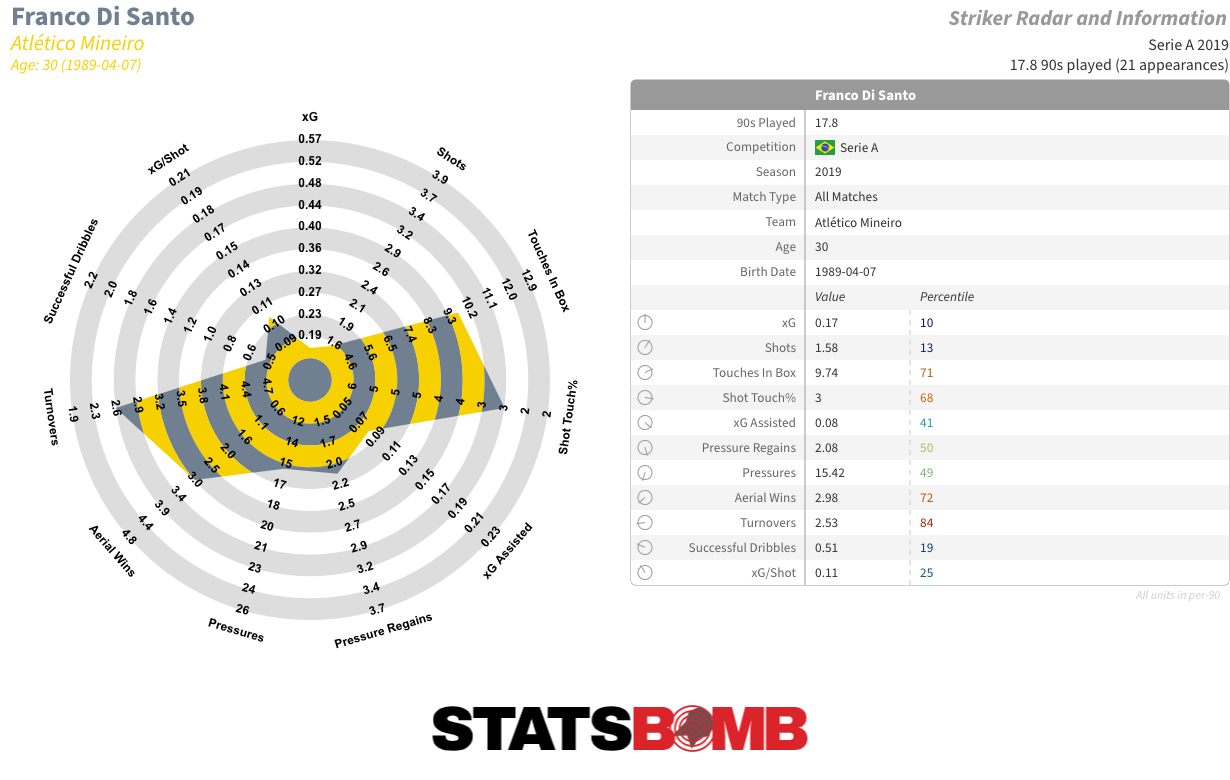 Who are the young players to keep tabs on? VM: At Racing, it will be interesting to see if Benjamin Garré, after showing promise at the back end of last season, is able to secure himself a starting berth and confirm what that run implied, namely that he is a skilled winger, incisive in one-on-one situations. It is obligatory to follow Thiago Almada. The Vélez player is ready to take a further step forward and become what he’s already hinted at becoming: a crack. He’s a skilled dribbler, incisive in one-on-ones, and with a good final pass. He is more than happy to take on the responsibility of generating advantageous positions for his team high up the pitch.
Who are the young players to keep tabs on? VM: At Racing, it will be interesting to see if Benjamin Garré, after showing promise at the back end of last season, is able to secure himself a starting berth and confirm what that run implied, namely that he is a skilled winger, incisive in one-on-one situations. It is obligatory to follow Thiago Almada. The Vélez player is ready to take a further step forward and become what he’s already hinted at becoming: a crack. He’s a skilled dribbler, incisive in one-on-ones, and with a good final pass. He is more than happy to take on the responsibility of generating advantageous positions for his team high up the pitch. 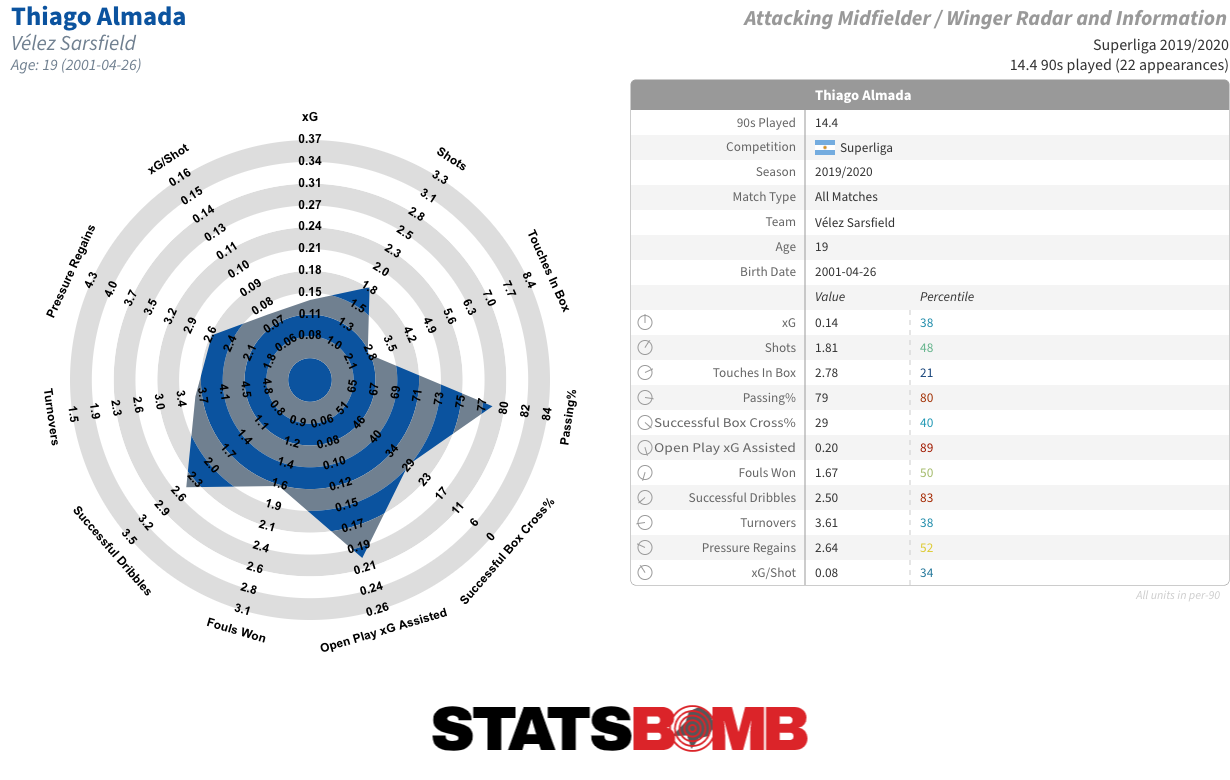 At Argentinos Juniors, Fausto Vera deserves a watch. The central midfielder of the Argentina Olympic team is technically sound, covers a lot of ground and reads play well, qualities that should allow him to establish himself as a great player for his club and also within the league. ND: With three goals and three assists in around 1,100 minutes of playing time, Tomás Badaloni of Godoy Cruz also looks like an interesting player to me. A goal or assist for every 180 minutes on the pitch is very good, particularly given that it runs in line with his expected output. We’ll see if he becomes a more regular starter in this tournament.
At Argentinos Juniors, Fausto Vera deserves a watch. The central midfielder of the Argentina Olympic team is technically sound, covers a lot of ground and reads play well, qualities that should allow him to establish himself as a great player for his club and also within the league. ND: With three goals and three assists in around 1,100 minutes of playing time, Tomás Badaloni of Godoy Cruz also looks like an interesting player to me. A goal or assist for every 180 minutes on the pitch is very good, particularly given that it runs in line with his expected output. We’ll see if he becomes a more regular starter in this tournament.  Great. Well, thanks again for your time Vicente. It's been a pleasure. VM: Thanks to you, Nick, and congratulations on the website. It provides very useful data with which to more deeply analyse the game.
Great. Well, thanks again for your time Vicente. It's been a pleasure. VM: Thanks to you, Nick, and congratulations on the website. It provides very useful data with which to more deeply analyse the game.
